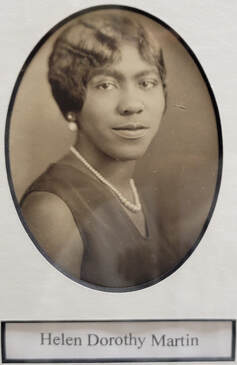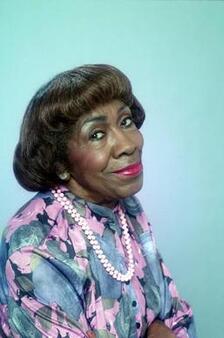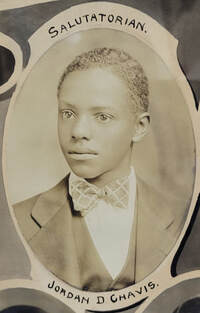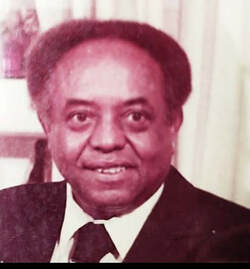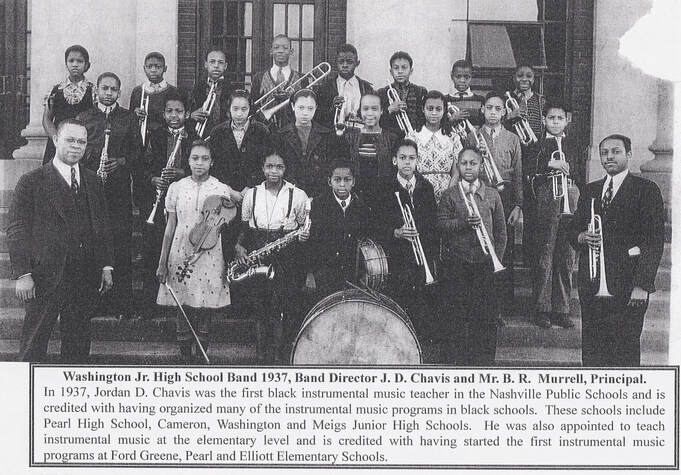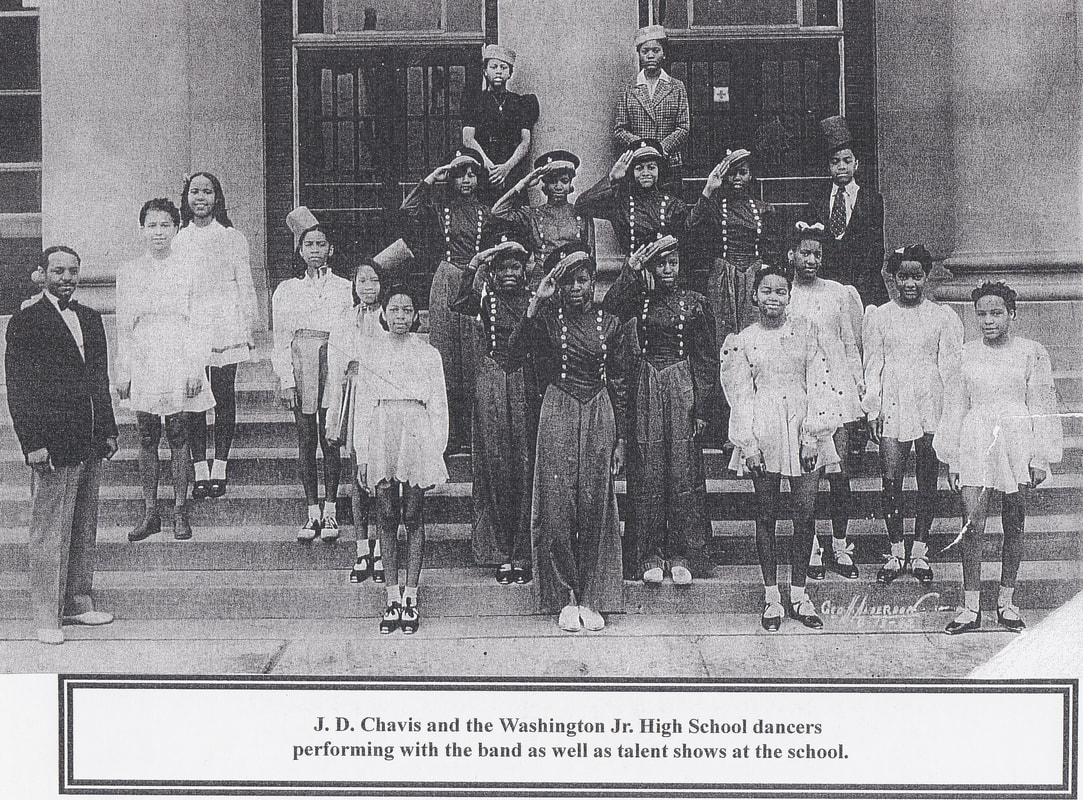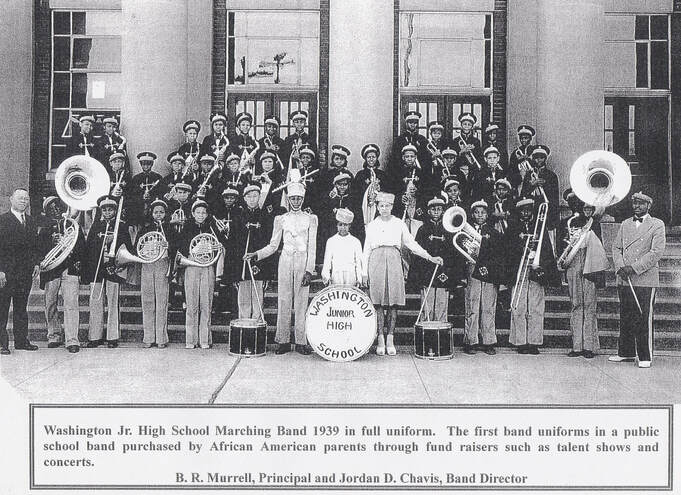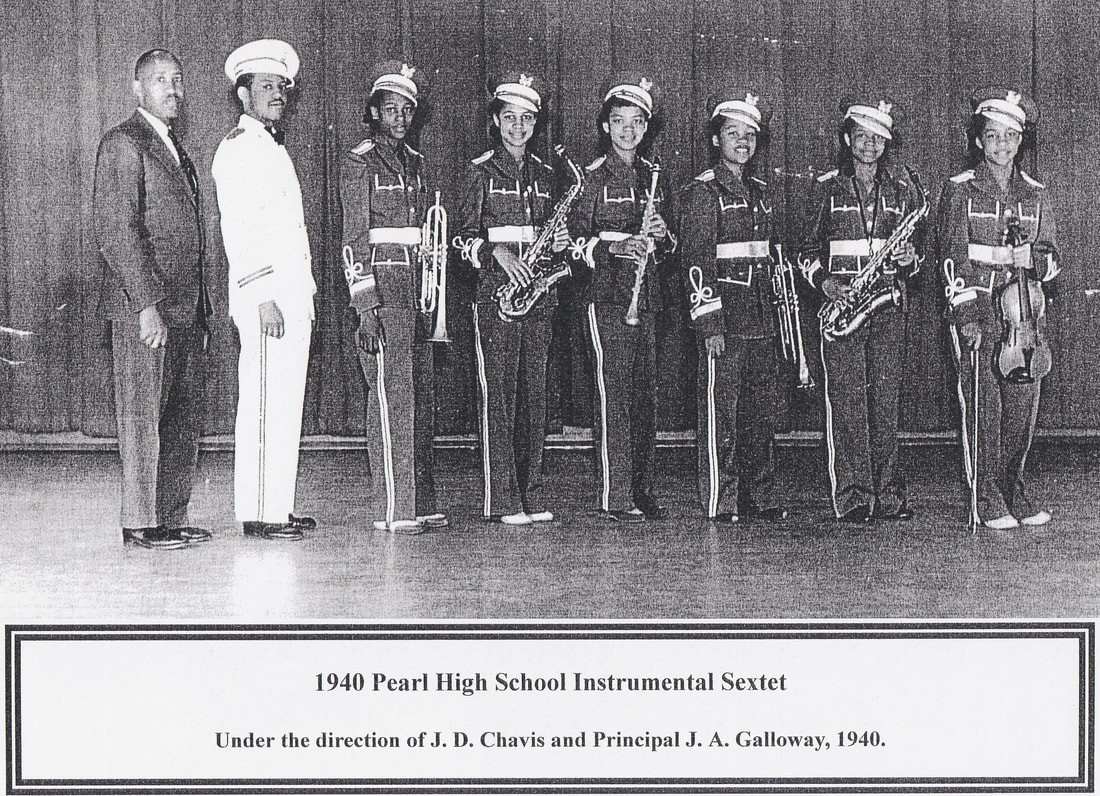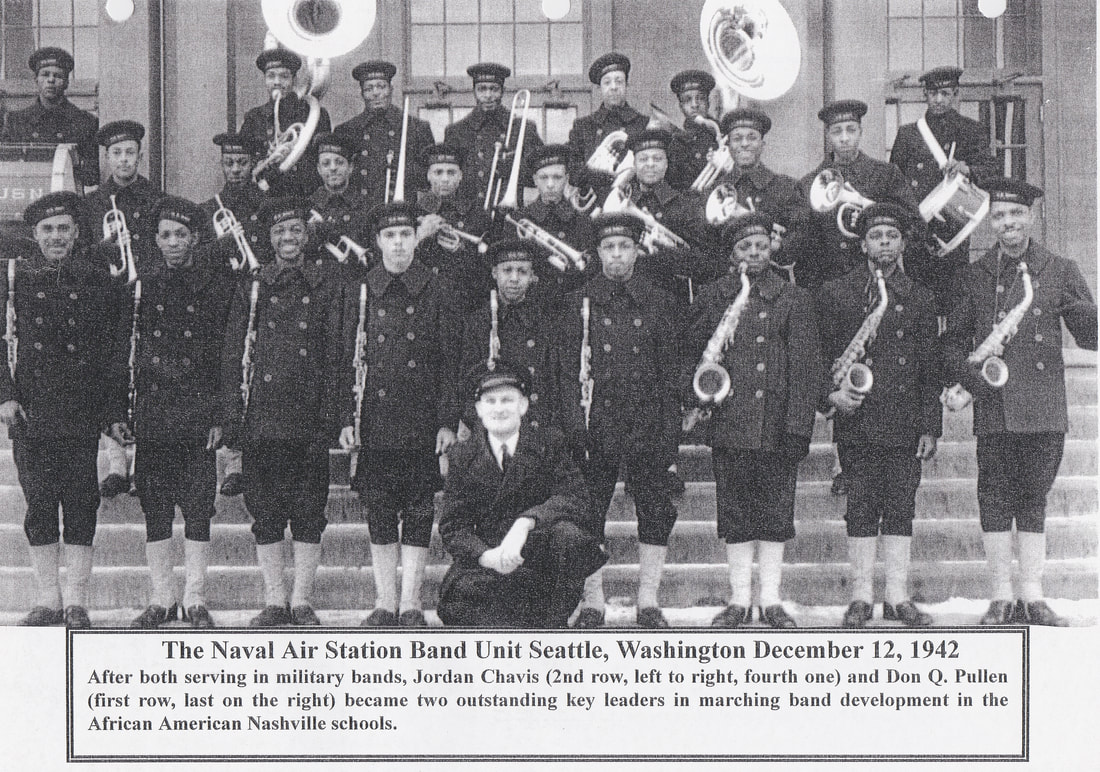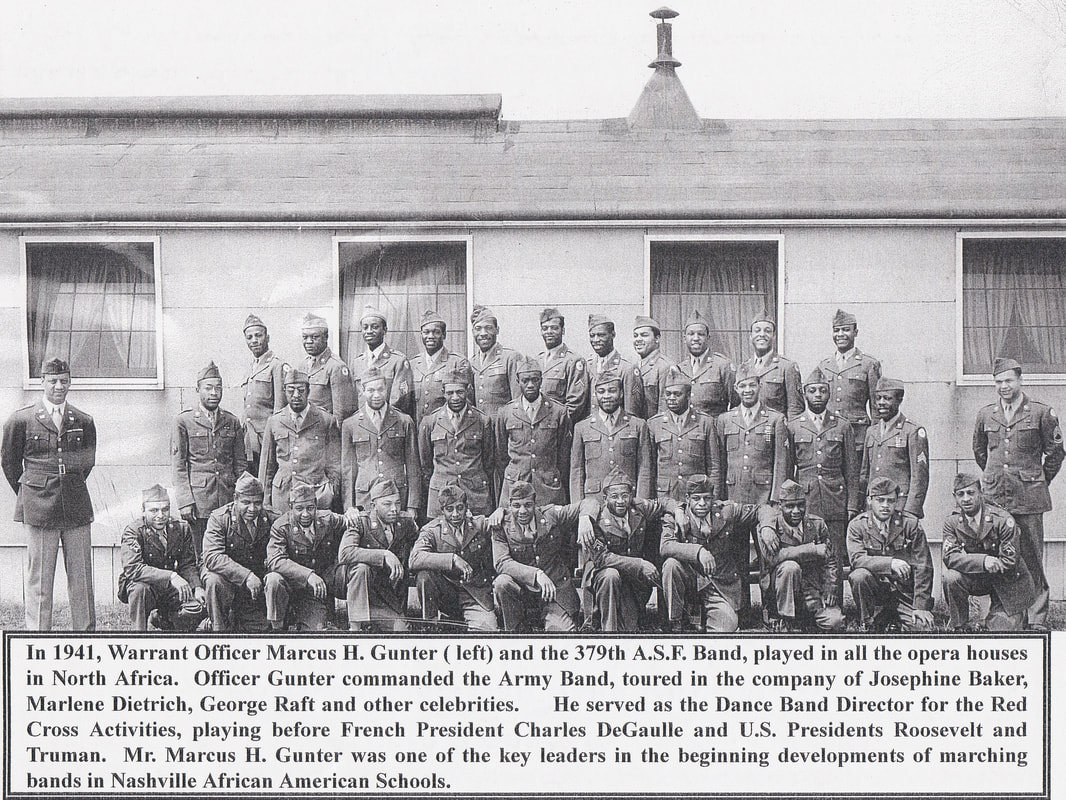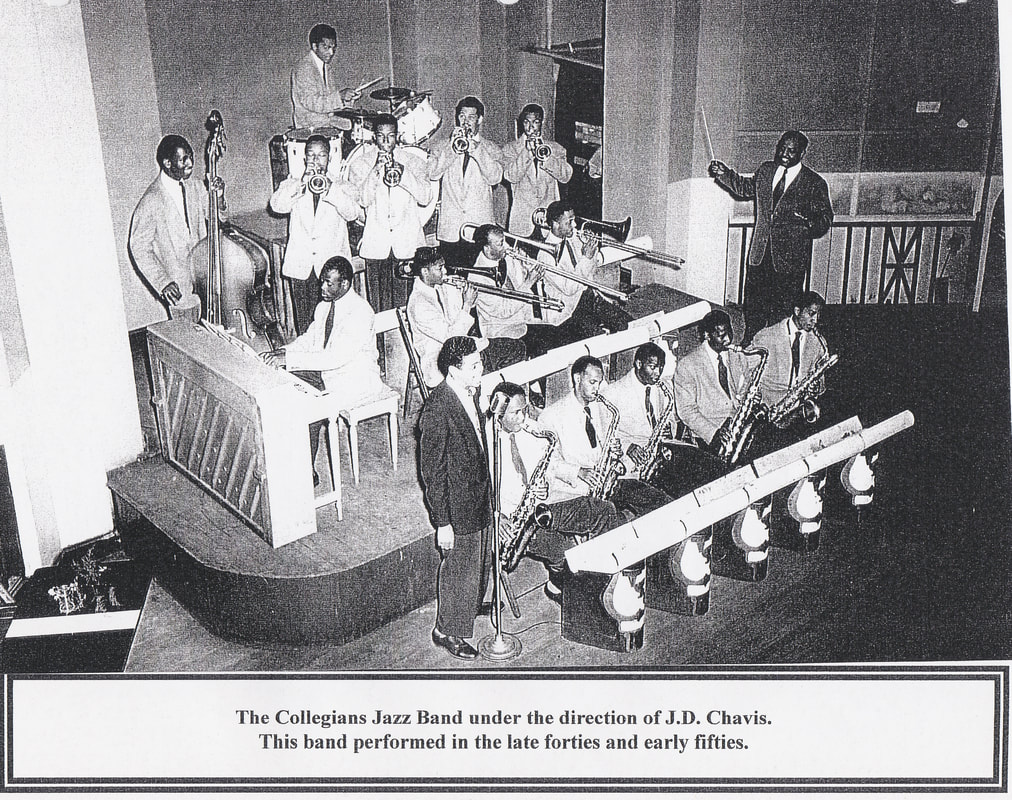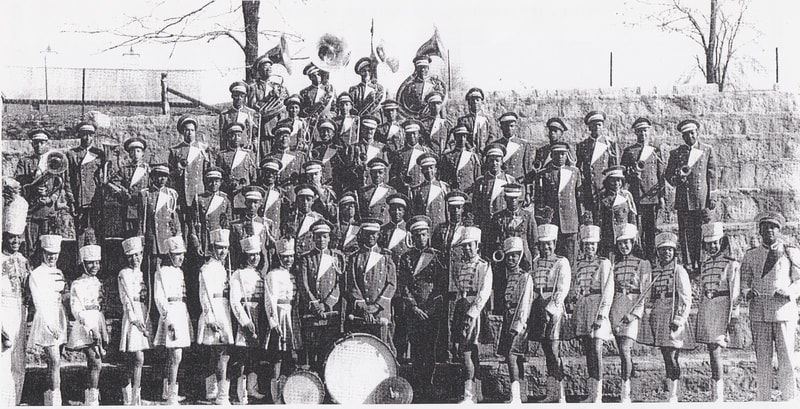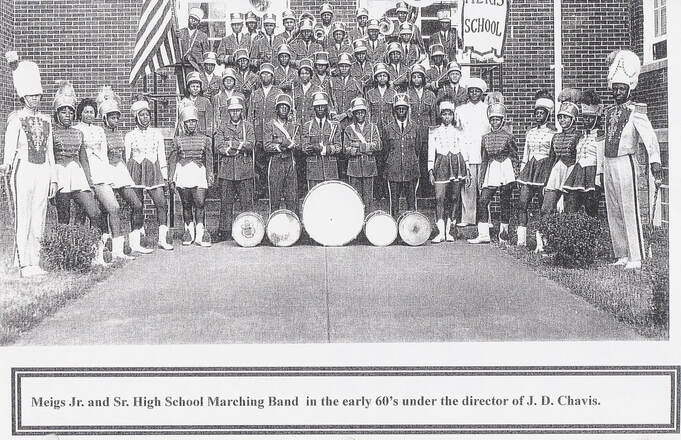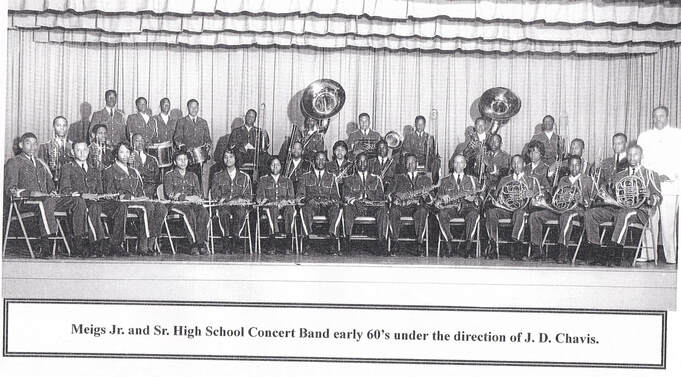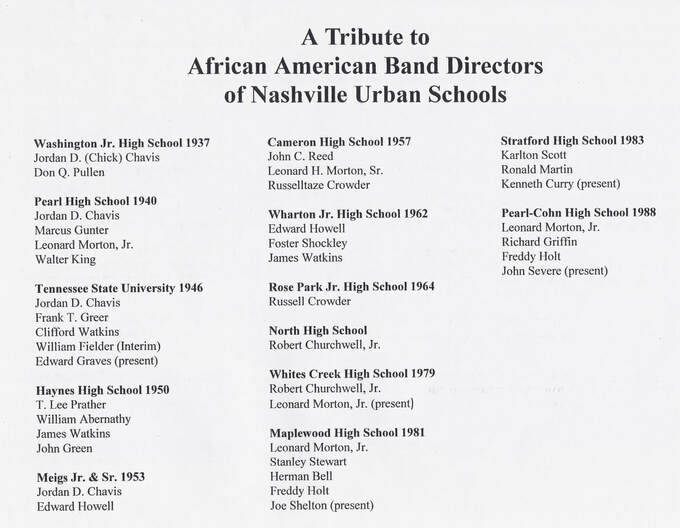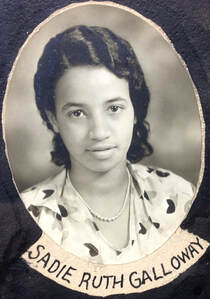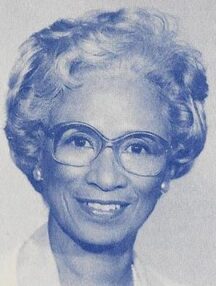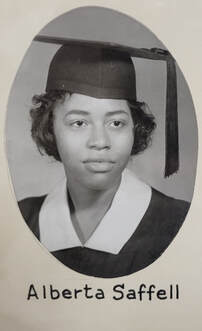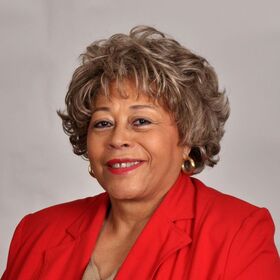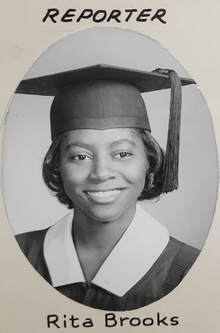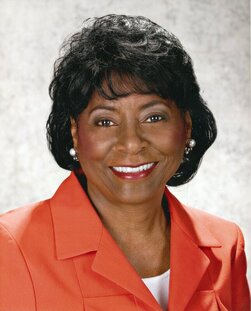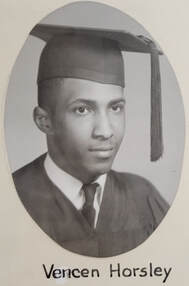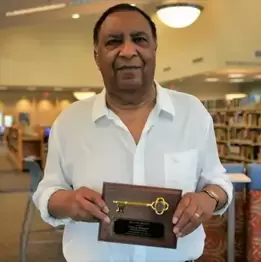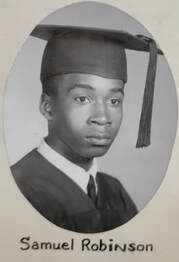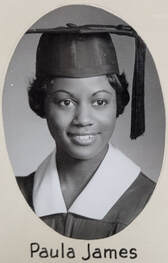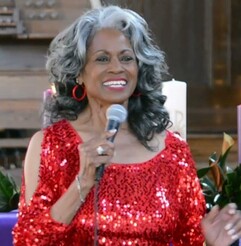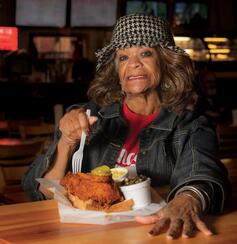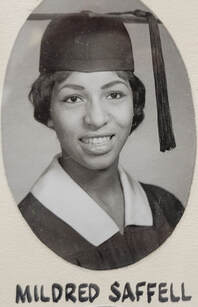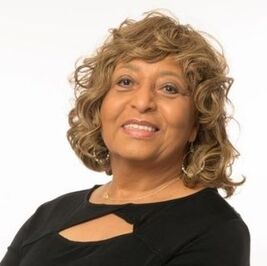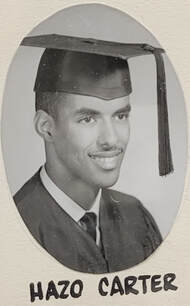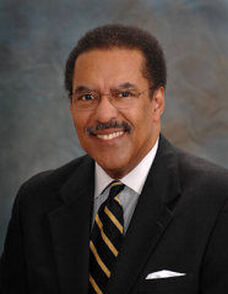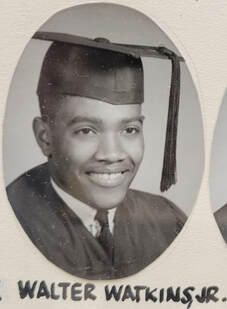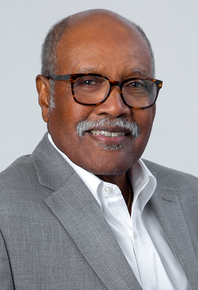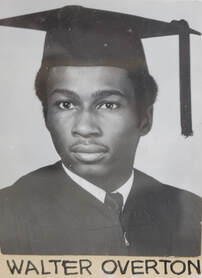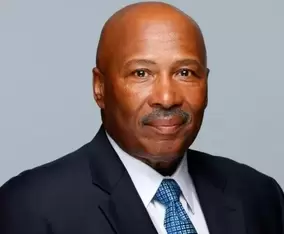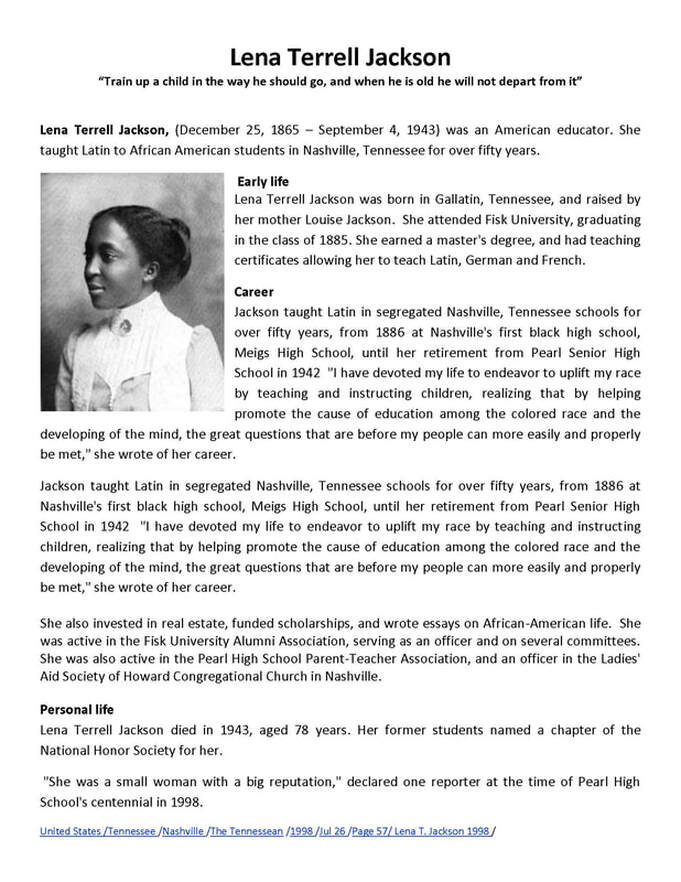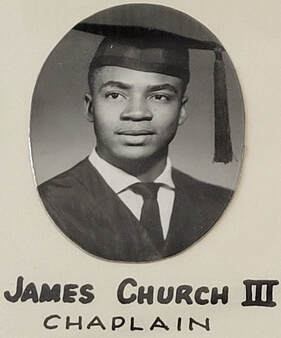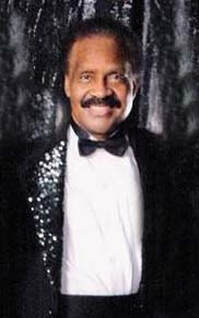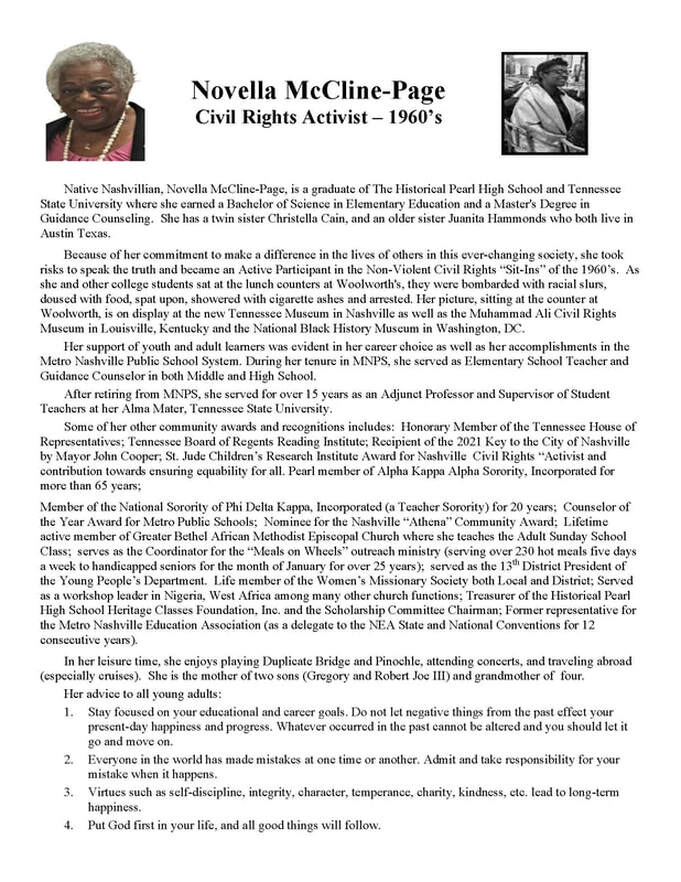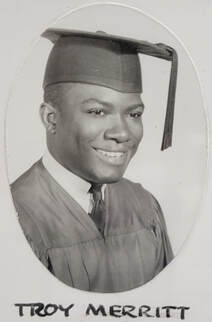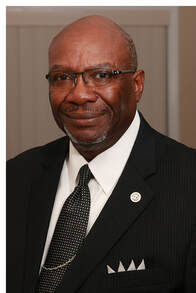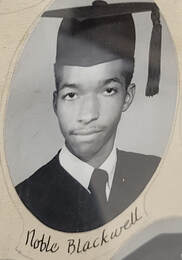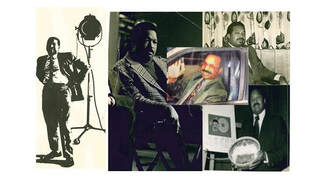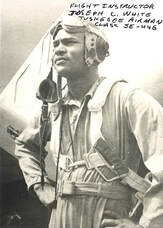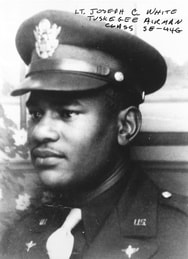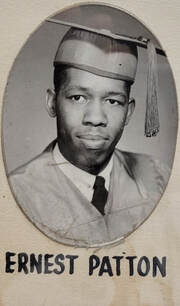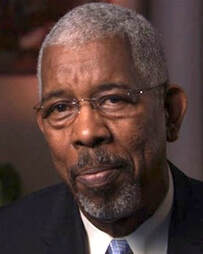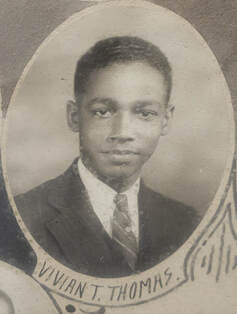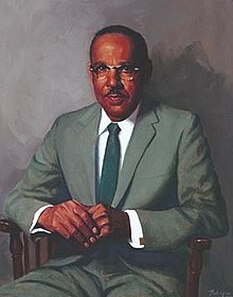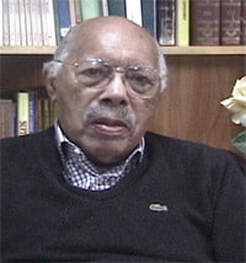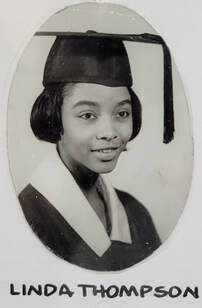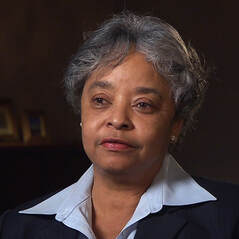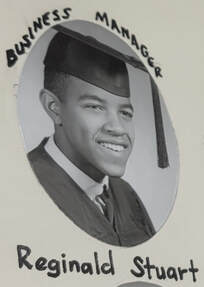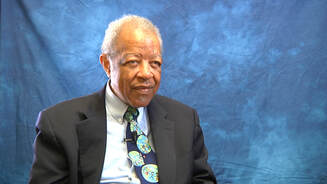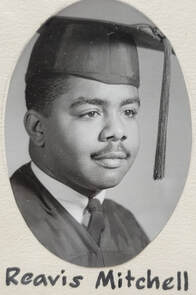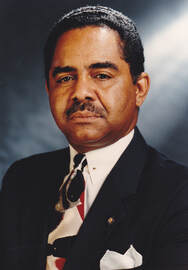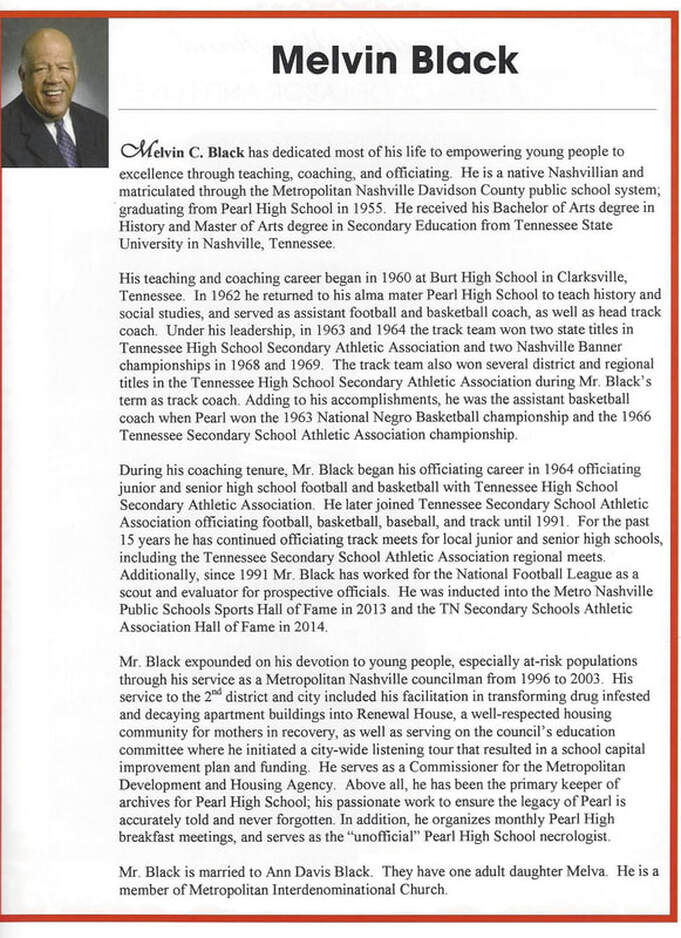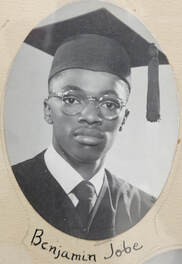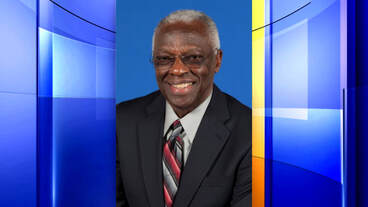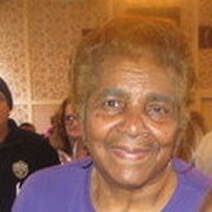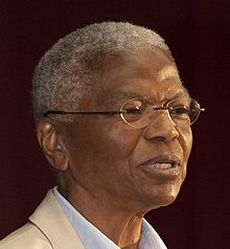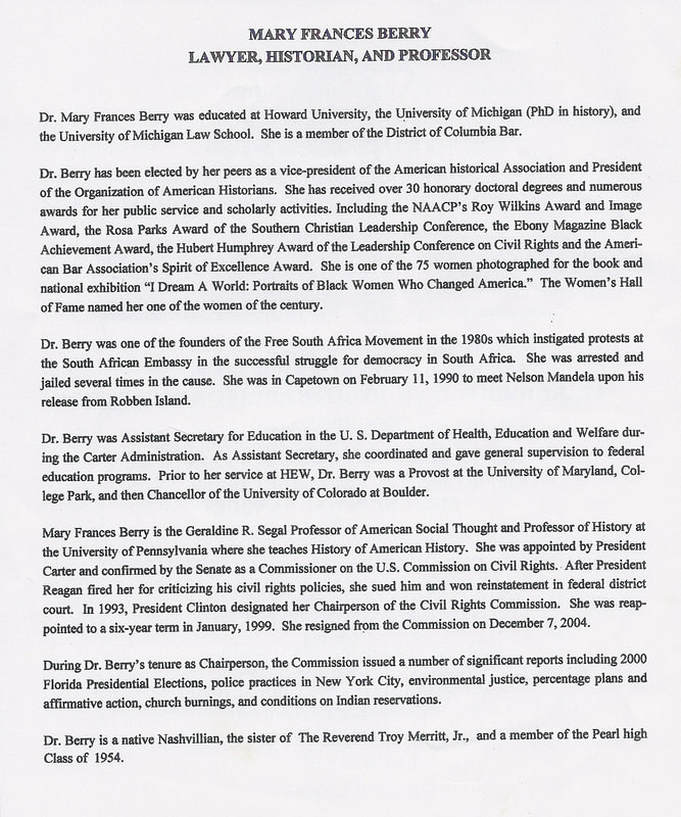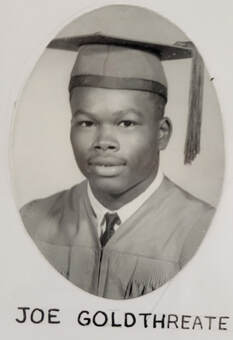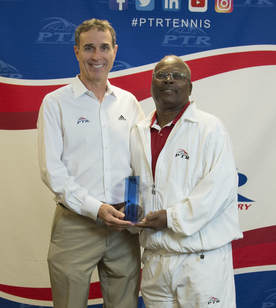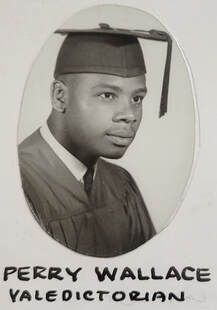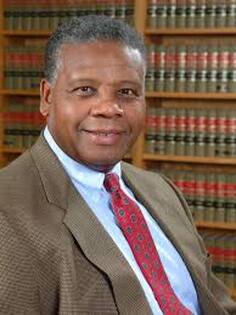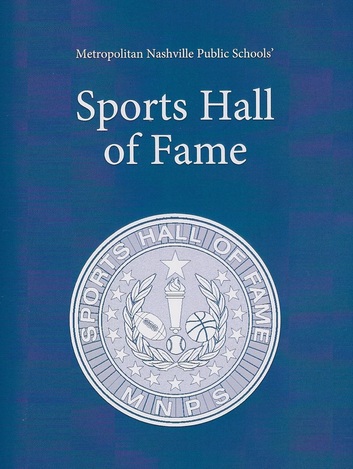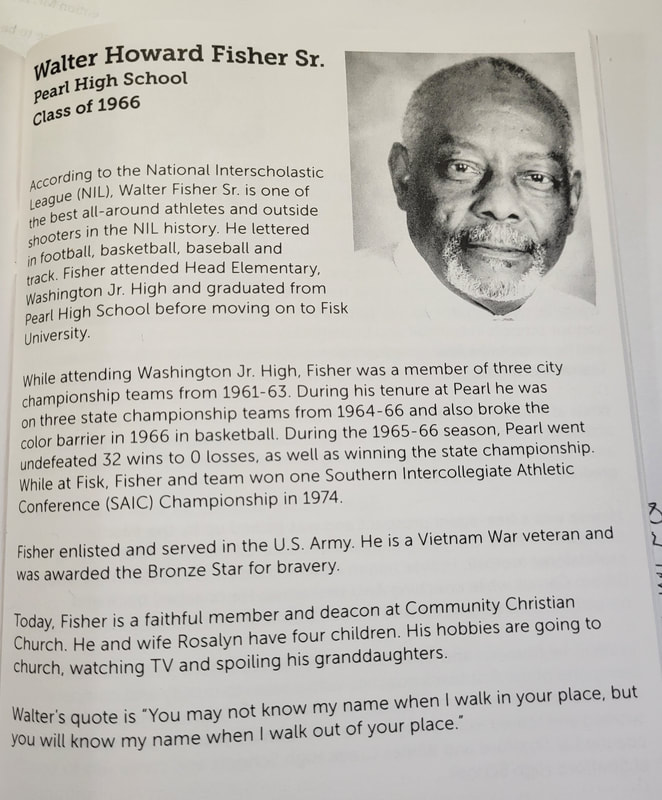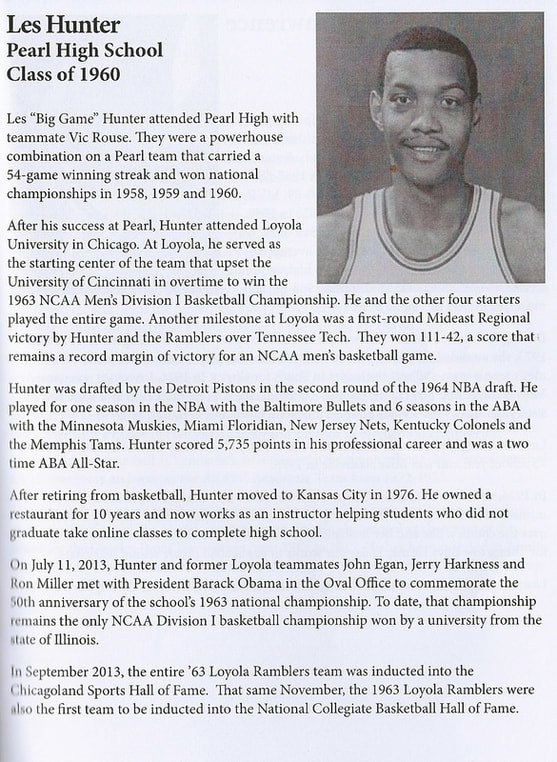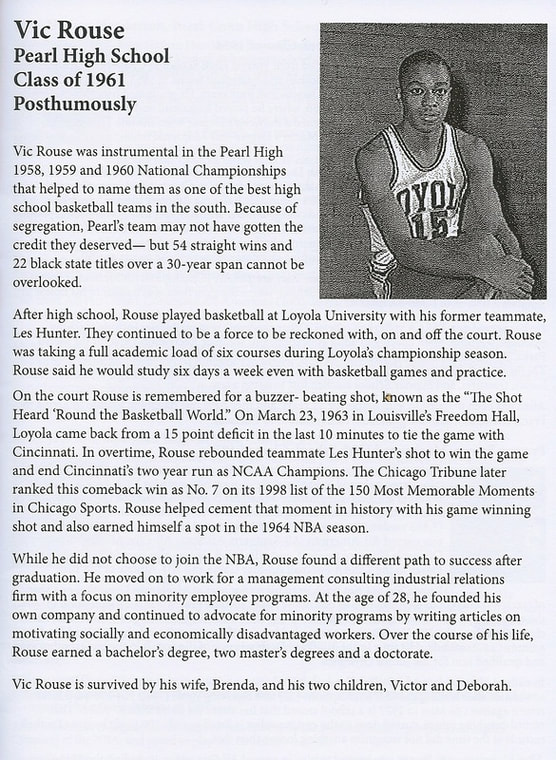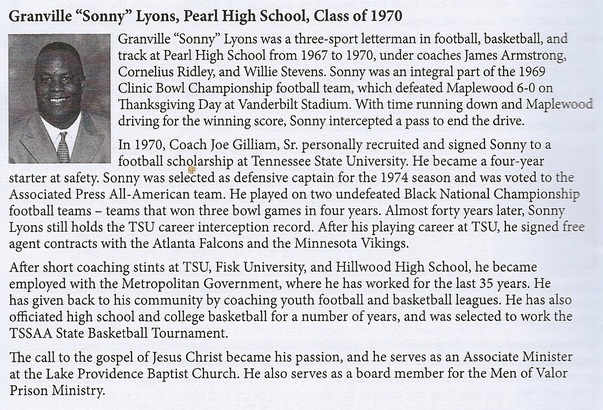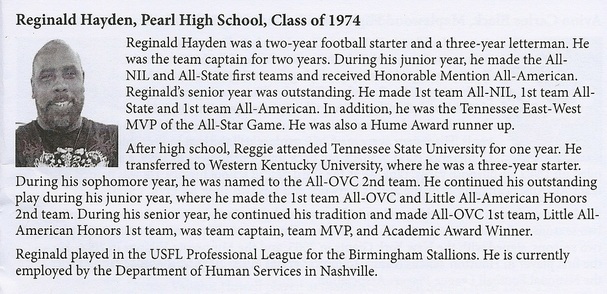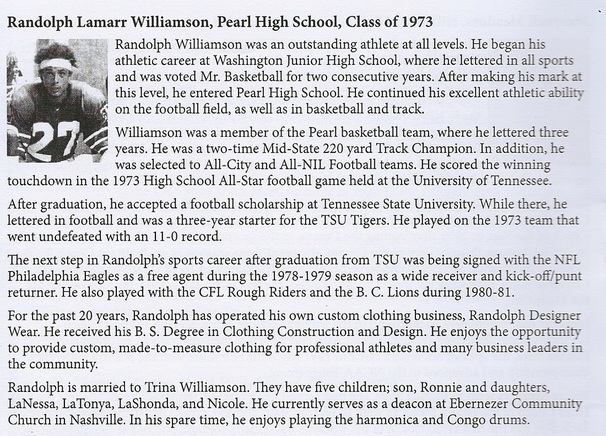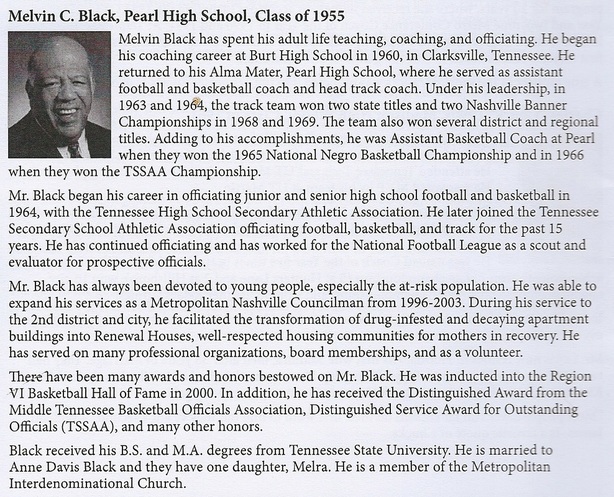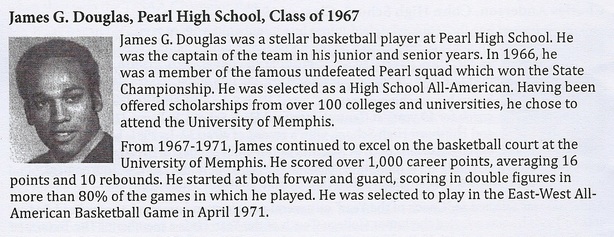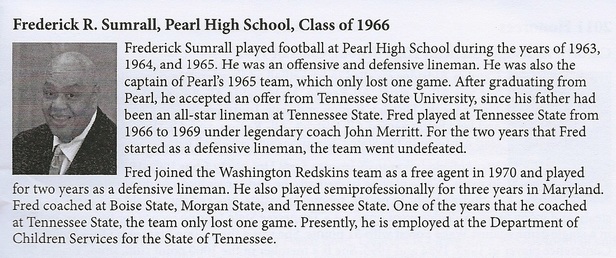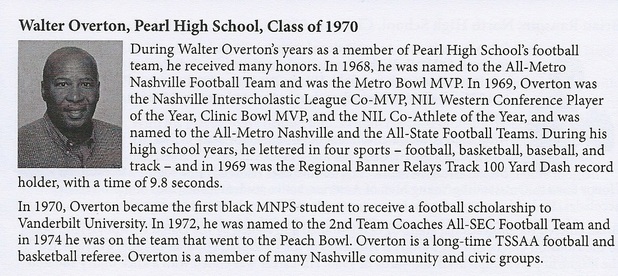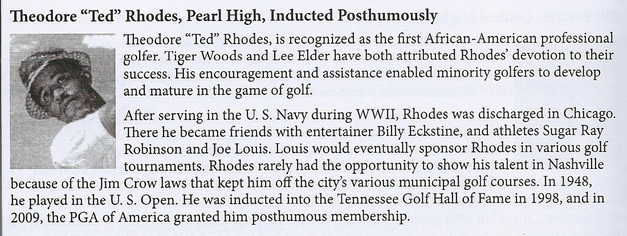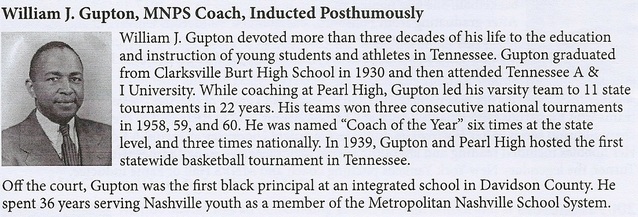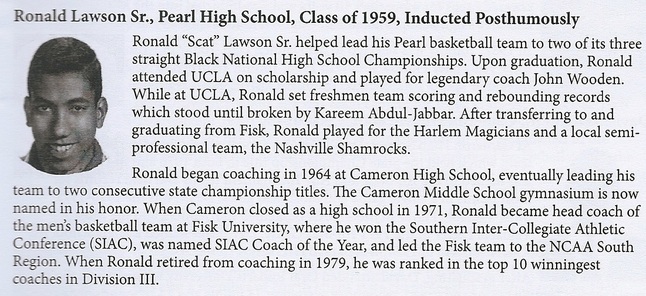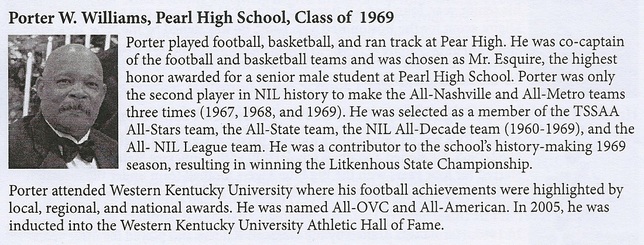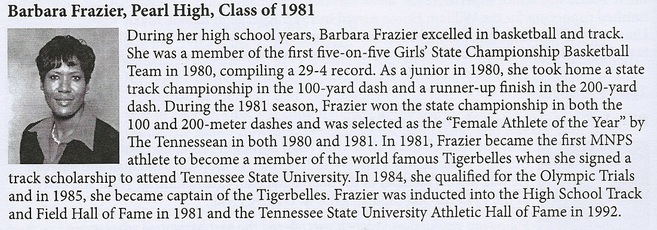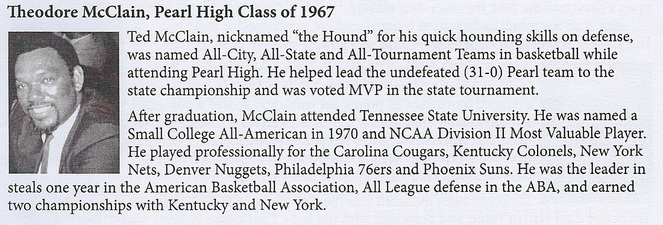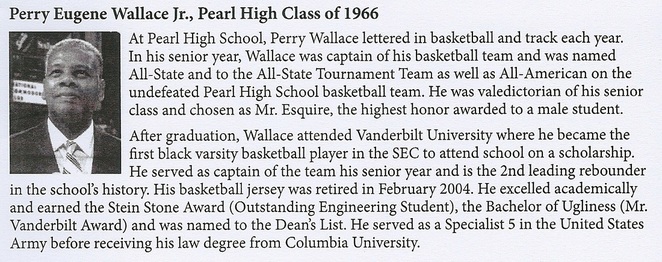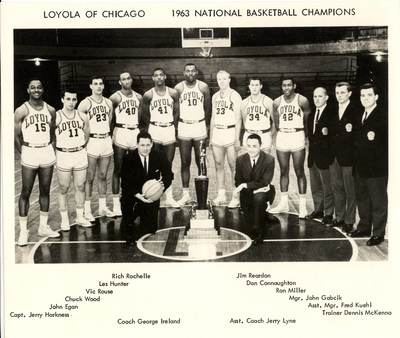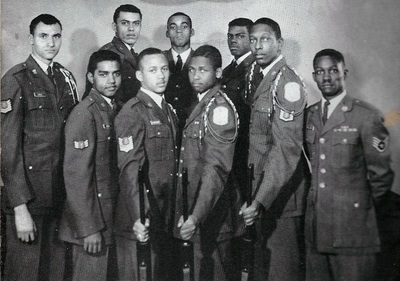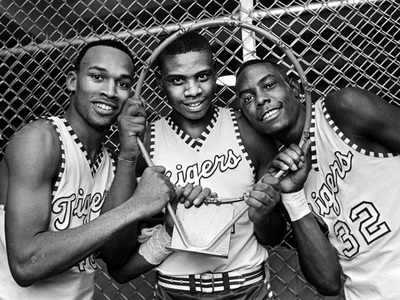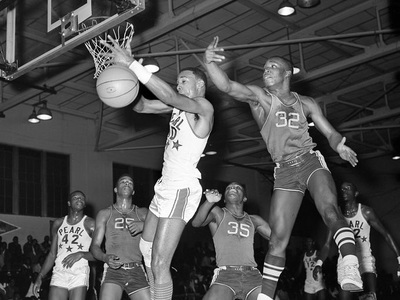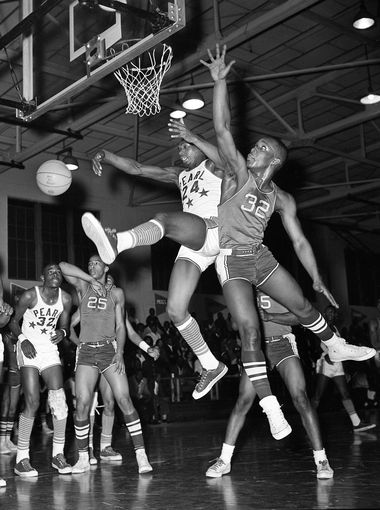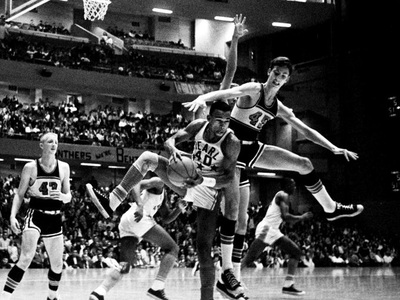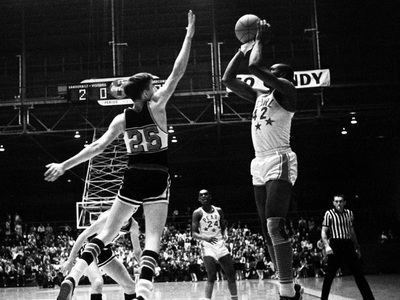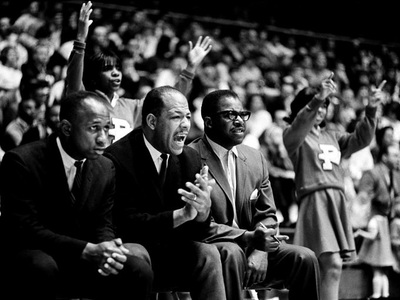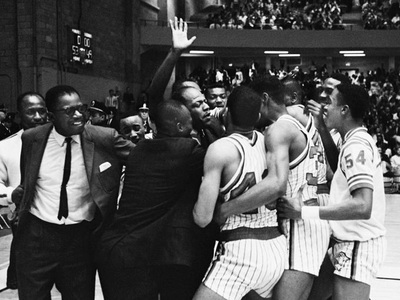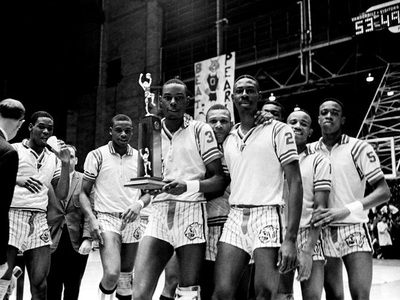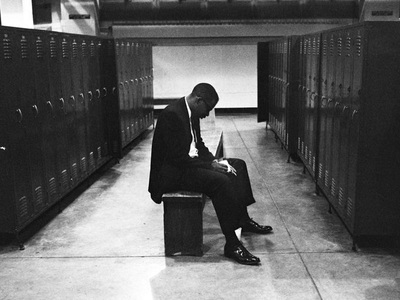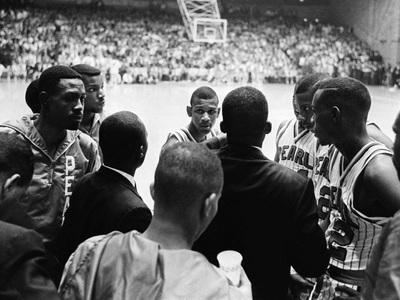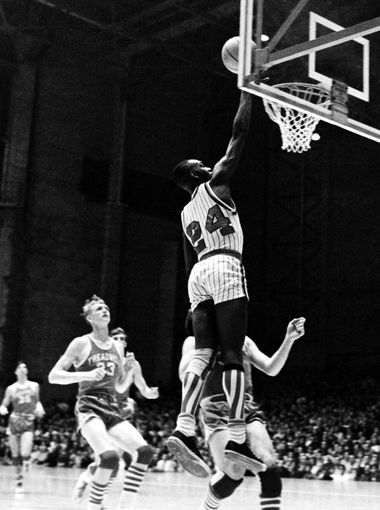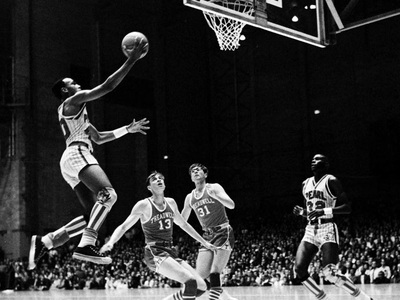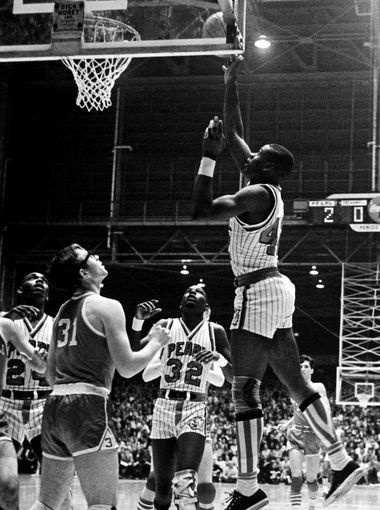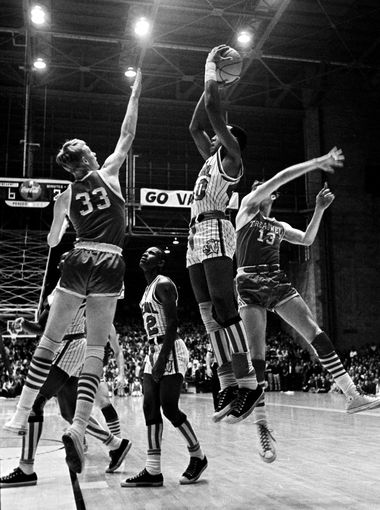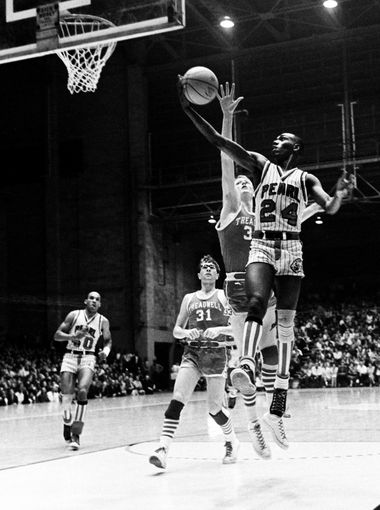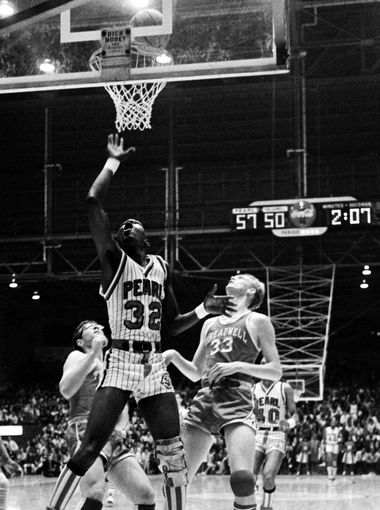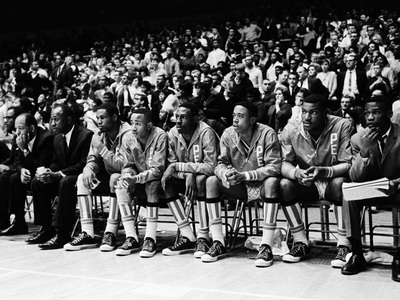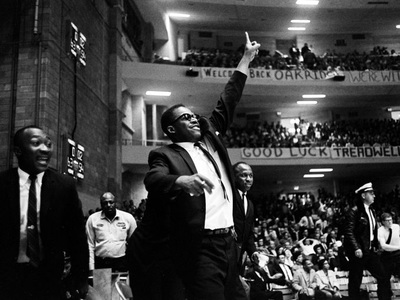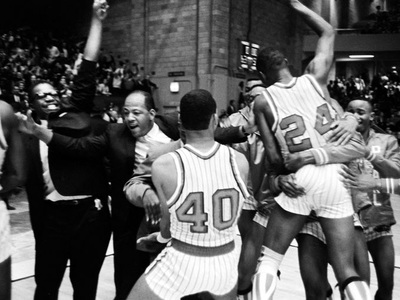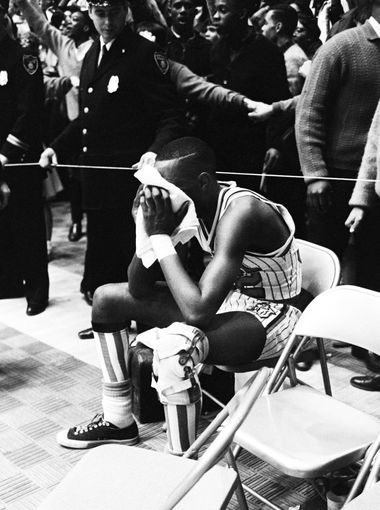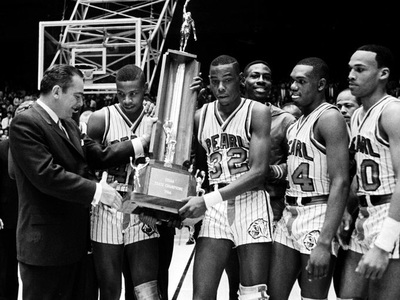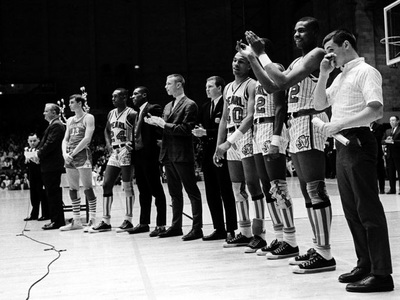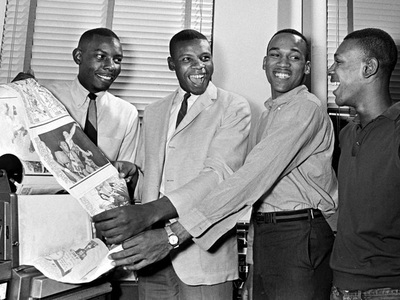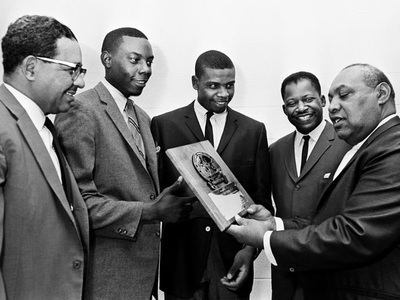CELEBRATION OF DIANE NASH AND ALONE WITH JOE GOLDTHREATE

John Henry Britton Jr. PHS Class of 1954
An exceptional communicator with an unwavering commitment to justice and peace
John Henry Britton Jr. had the good fortune to be born to parents who adored him and instilled in him strong ethical values, religious principles, and a commitment to racial equality. His father, John H. Britton Sr., a minister, and his mother, Martha Parrish Britton, a schoolteacher, served as role models for their beloved son and daughter, Naomi, who was 3 years older than John.
Although he did not follow his parents’ expectation that he would become a minister, John grew to be an accomplished, erudite, kind man who made his professional mark through journalism and communications. He carried on his family’s legacy of achievement in ways his parents may not have thought possible for Black people of their generation. At John’s death of congestive heart failure, at 86 years old, legions of friends and former colleagues mourned his passing while counting themselves as blessed for having known him.
Growing up in Nashville, TN, from birth on July 21, 1937, through high school in 1954, John learned firsthand the imperative of dismantling segregation and confronting racism through nonviolent affirmative action. He spent his first two years of college at Lincoln University in Missouri, transferred to the University of Michigan, and in 1958 graduated from Drake University with a B.S. degree in journalism. In1962, he earned an M.S. degree in journalism from Syracuse University in New York.
John found his gift in writing and communicating, and he was determined to use it to contribute to the cause of civil rights and economic justice for all. In 1958, John took a job as a reporter for the Atlanta Daily World, hoping to cover the burgeoning student Civil Rights protests. There, he met fellow young journalist Paul Delaney, who became one of his lifelong friends. They both left the Atlanta paper a few years later but reunited not long after in Chicago, where John was editor for Ebony/Jet and Paul was assigned to the Chicago bureau of the New York Times. Paul says of his dear friend: “When I met John Britton, he seemed like a person with not a worry in the world. And he never ceased to amaze me. Not only a great talent but a decent human being. We never stopped being in touch and supporting each other, wherever in the world we were. That was who he was.”
John joined the staff of Jet magazine in 1962 – one of the most widely read Black publications at the time. He worked there as associate editor until 1966 but took a two-year pause to do a stint with the U.S. Commission on Civil Rights in Washington, D.C. where he also worked on the Ralph Bunche Civil Rights Documentation Project.
He returned to Jet as managing editor in 1968 and left in 1971 to work as publicity manager with Motown Records for two years.
One of his colleagues at Ebony/Jet, Cordell Thompson, spoke of meeting John during Cordell’s visit to Johnson Publishing Company from the Bahamas. John hired him. “John was both an impressive and imposing figure, which matched his kindness, generosity, and true concern for everyone he knew. He always had the largest smile in the room and the softer voice. He became my father figure and mentor, showing me city ways and how to fit in. He made me a better writer, and just observing his natural warm nature made me a better person.”
Cordell added, “John knew all the important figures of his era, the entertainers, the political leaders, the business class -- they all knew and respected him. Jesse Jackson, Isaac Hayes, Aretha Franklin, and Muhammad Ali were just a few of the figures John introduced me to, not just for coverage in the magazines but true friends and confidants.”
John returned to Washington, D.C. in 1973, to serve as director of public affairs with the Joint Center for Political and Economic Studies in Washington, where he spent three years before joining The Washington Post as public relations manager in 1976. In March 1978, John made a career move that lasted for 19 years when he accepted the job as director and then associate vice president for public affairs at the University of the District of Columbia (UDC). John moved to Nashville in 1998 where he served as associate vice president for marketing and assistant to the president of Meharry Medical College.
While at UDC, John met the love of his life, Cherrie Alvilda Dean, who became his wife in 2002. He and Cherrie enjoyed traveling and visiting family and friends in South Carolina, Florida, Georgia, and other locations. John’s favorite game was Scrabble, and he enjoyed playing it immensely with his friend, Lurma Rackley, on their visits to each other’s homes.
John became a member of the Alpha Phi Alpha fraternity at Lincoln University, and was also a lifelong member of the NAACP, and an associate member of the National Association of Black Journalists. He is enshrined through videos in the archives at The History Makers and at Emory University.
An exceptional communicator with an unwavering commitment to justice and peace
John Henry Britton Jr. had the good fortune to be born to parents who adored him and instilled in him strong ethical values, religious principles, and a commitment to racial equality. His father, John H. Britton Sr., a minister, and his mother, Martha Parrish Britton, a schoolteacher, served as role models for their beloved son and daughter, Naomi, who was 3 years older than John.
Although he did not follow his parents’ expectation that he would become a minister, John grew to be an accomplished, erudite, kind man who made his professional mark through journalism and communications. He carried on his family’s legacy of achievement in ways his parents may not have thought possible for Black people of their generation. At John’s death of congestive heart failure, at 86 years old, legions of friends and former colleagues mourned his passing while counting themselves as blessed for having known him.
Growing up in Nashville, TN, from birth on July 21, 1937, through high school in 1954, John learned firsthand the imperative of dismantling segregation and confronting racism through nonviolent affirmative action. He spent his first two years of college at Lincoln University in Missouri, transferred to the University of Michigan, and in 1958 graduated from Drake University with a B.S. degree in journalism. In1962, he earned an M.S. degree in journalism from Syracuse University in New York.
John found his gift in writing and communicating, and he was determined to use it to contribute to the cause of civil rights and economic justice for all. In 1958, John took a job as a reporter for the Atlanta Daily World, hoping to cover the burgeoning student Civil Rights protests. There, he met fellow young journalist Paul Delaney, who became one of his lifelong friends. They both left the Atlanta paper a few years later but reunited not long after in Chicago, where John was editor for Ebony/Jet and Paul was assigned to the Chicago bureau of the New York Times. Paul says of his dear friend: “When I met John Britton, he seemed like a person with not a worry in the world. And he never ceased to amaze me. Not only a great talent but a decent human being. We never stopped being in touch and supporting each other, wherever in the world we were. That was who he was.”
John joined the staff of Jet magazine in 1962 – one of the most widely read Black publications at the time. He worked there as associate editor until 1966 but took a two-year pause to do a stint with the U.S. Commission on Civil Rights in Washington, D.C. where he also worked on the Ralph Bunche Civil Rights Documentation Project.
He returned to Jet as managing editor in 1968 and left in 1971 to work as publicity manager with Motown Records for two years.
One of his colleagues at Ebony/Jet, Cordell Thompson, spoke of meeting John during Cordell’s visit to Johnson Publishing Company from the Bahamas. John hired him. “John was both an impressive and imposing figure, which matched his kindness, generosity, and true concern for everyone he knew. He always had the largest smile in the room and the softer voice. He became my father figure and mentor, showing me city ways and how to fit in. He made me a better writer, and just observing his natural warm nature made me a better person.”
Cordell added, “John knew all the important figures of his era, the entertainers, the political leaders, the business class -- they all knew and respected him. Jesse Jackson, Isaac Hayes, Aretha Franklin, and Muhammad Ali were just a few of the figures John introduced me to, not just for coverage in the magazines but true friends and confidants.”
John returned to Washington, D.C. in 1973, to serve as director of public affairs with the Joint Center for Political and Economic Studies in Washington, where he spent three years before joining The Washington Post as public relations manager in 1976. In March 1978, John made a career move that lasted for 19 years when he accepted the job as director and then associate vice president for public affairs at the University of the District of Columbia (UDC). John moved to Nashville in 1998 where he served as associate vice president for marketing and assistant to the president of Meharry Medical College.
While at UDC, John met the love of his life, Cherrie Alvilda Dean, who became his wife in 2002. He and Cherrie enjoyed traveling and visiting family and friends in South Carolina, Florida, Georgia, and other locations. John’s favorite game was Scrabble, and he enjoyed playing it immensely with his friend, Lurma Rackley, on their visits to each other’s homes.
John became a member of the Alpha Phi Alpha fraternity at Lincoln University, and was also a lifelong member of the NAACP, and an associate member of the National Association of Black Journalists. He is enshrined through videos in the archives at The History Makers and at Emory University.
Helen Dorothy Martin PHS Class of 1930
Helen Dorothy Martin (July 23, 1909 – March 25, 2000)[2][3] was an American actress of stage and television. Martin's career spanned over 60 years, appearing first on stage and later in film and television. Martin is best known for her roles as Wanda on the CBS sitcom Good Times (1974–1979) and as Pearl Shay on the NBC sitcom 227 (1985–1990).
Martin was raised in Nashville, Tennessee.[4] She was an only child born to a family of musicians.[5] Martin's parents wanted their daughter to become a concert pianist.[5] At the urging of her parents, Martin attended Fisk University for a two year span before dropping out to embark on an acting career.[6] During the Great Depression, Martin supported herself as a domestic worker.[5]
After leaving college, Martin moved to Chicago, and New York City thereafter to study acting with the WPA Theater and the Rose McClendon Players. She was a founding member of the American Negro Theater in Harlem. Martin became a Broadway character actress for many decades, debuting in 'Orchids Preferred' in 1937 and thereafter Orson Welles's production of Native Son in 1941.
Martin appeared in a dozen Broadway shows, including Jean Genet's The Blacks, the musical Raisin from 1973 until 1975, Ossie Davis's Purlie Victorious (and later the musical version, which was called Purlie), The Amen Corner and Tennessee Williams's Period of Adjustment.
Martin became widely known later in life due to her roles in popular television series, which brought her a large audience. She had a recurring role as Wanda "Weeping Wanda" on the television series Good Times, and later as the neighbor Pearl Shay on the television sitcom 227, which lasted from 1985 until 1990. Martin also had a role on the short-lived sitcoms Baby, I'm Back (as mother in-law, Luzelle)[7] and That's My Mama. Martin portrayed a variety of grandmothers in films: Hollywood Shuffle (1987),[8] Don't Be a Menace to South Central While Drinking Your Juice in the Hood (1996), I Got the Hook Up (1998),[9] House Party 2 (1991), and Mama Doll in Bulworth (1998).
While appearing on Late Night with Conan O'Brien to promote Don't Be a Menace, Martin sent host Conan O'Brien and the audience into a frenzy with her remarks, responding to a question about being cast as a pot-smoking grandmother in the film, "I love the reefer!", and that she would be a stripper had she not gone into acting, following the statement with a suggestive dance.[10]
Martin died of a heart attack on March 25, 2000, in Monterey, California, aged 90.[4]
Helen Dorothy Martin (July 23, 1909 – March 25, 2000)[2][3] was an American actress of stage and television. Martin's career spanned over 60 years, appearing first on stage and later in film and television. Martin is best known for her roles as Wanda on the CBS sitcom Good Times (1974–1979) and as Pearl Shay on the NBC sitcom 227 (1985–1990).
Martin was raised in Nashville, Tennessee.[4] She was an only child born to a family of musicians.[5] Martin's parents wanted their daughter to become a concert pianist.[5] At the urging of her parents, Martin attended Fisk University for a two year span before dropping out to embark on an acting career.[6] During the Great Depression, Martin supported herself as a domestic worker.[5]
After leaving college, Martin moved to Chicago, and New York City thereafter to study acting with the WPA Theater and the Rose McClendon Players. She was a founding member of the American Negro Theater in Harlem. Martin became a Broadway character actress for many decades, debuting in 'Orchids Preferred' in 1937 and thereafter Orson Welles's production of Native Son in 1941.
Martin appeared in a dozen Broadway shows, including Jean Genet's The Blacks, the musical Raisin from 1973 until 1975, Ossie Davis's Purlie Victorious (and later the musical version, which was called Purlie), The Amen Corner and Tennessee Williams's Period of Adjustment.
Martin became widely known later in life due to her roles in popular television series, which brought her a large audience. She had a recurring role as Wanda "Weeping Wanda" on the television series Good Times, and later as the neighbor Pearl Shay on the television sitcom 227, which lasted from 1985 until 1990. Martin also had a role on the short-lived sitcoms Baby, I'm Back (as mother in-law, Luzelle)[7] and That's My Mama. Martin portrayed a variety of grandmothers in films: Hollywood Shuffle (1987),[8] Don't Be a Menace to South Central While Drinking Your Juice in the Hood (1996), I Got the Hook Up (1998),[9] House Party 2 (1991), and Mama Doll in Bulworth (1998).
While appearing on Late Night with Conan O'Brien to promote Don't Be a Menace, Martin sent host Conan O'Brien and the audience into a frenzy with her remarks, responding to a question about being cast as a pot-smoking grandmother in the film, "I love the reefer!", and that she would be a stripper had she not gone into acting, following the statement with a suggestive dance.[10]
Martin died of a heart attack on March 25, 2000, in Monterey, California, aged 90.[4]
Jordan D. “Chick” Chavis, Jr. PHS Class of 1927
Jordan D. “Chick” Chavis, Jr.
Jordan Douglass Chavis, Jr. was born August 3, 1910 in Greensboro, North Carolina. He was the youngest of four children of Reverend Dr. J. D. Chavis, Sr. (President of Bennett College) and Mattie Carr Chavis who were ardent educators and inspired him to pursue education and excellence in his endeavors.
He graduated as Salutatorian from Pearl High School. He earned a Bachelor of Science degree in English and Master of Arts degree in Music from Fisk University. When he was at Fisk, he organized and directed the Vagabond Collegians. He became known as “Chick” Chavis because of his style of playing trumpet and being bandleader of a jazz orchestra playing ‘swing’ and ‘big band’ music. Also, the nickname “Chick” was tagged after renowned bandleader Chick Webb. “Chick” was often out front of the orchestra with both hands on his trumpet at times and conducting with both hands at other times.
After graduation, he took his first teaching job at Fayette county Schools in West Tennessee. Later, he returned to Nashville where he began his teaching career in the public schools. In 1939, he was appointed bandmaster for Washington Junior High and Pearl High School. After that, he and some of his students were responsible for organizing the band and instrumental music programs in every black public school of Nashville and Davidson County.
In 1942, Chavis went to the United States Navy where he served as the assistant leader of the Black Naval Band, serving at the Great Lakes Naval Station and later at the Seattle, Washington Naval Base.
In 1946 when he returned to Nashville, Dr. W. S. Davis, President at Tennessee A. & I. College (now Tennessee State University) commissioned him to organize the band program that consisted of a jazz orchestra and a marching band (“The Marching 100”). In the fall of 1946, after six weeks of practice, a 100-piece marching band took to the field at Tennessee State University and a phenomenal tradition of excellence was born.
Under Chavis’ leadership, the marching band grew and developed into a premier university band that gave spectacular performances in parades and half-time shows at football games. The nationally acclaimed band won many competitions. They were noted for performing with such greats as Billie “Lady Day” Holiday in Carnegie Hall and even funded Count Basie’s first audition in Chicago which launched his big career as a legend. The jazz band that was formed from the collegiate orchestra played in the famous Savoy Lounge in New York City.
In 1947 and 1948, the marching band performed in the Washington Classic in Washington, D.C., where top historically black colleges and universities competed for national championships. It is not immodest to boast that the band won great acclaim from their parade performances and they electrified stadiums with their halftime shows with illuminated batons and instruments which formed figures and outlines against “blacked out” (lights out) field. Chavis' tenure as band director ended in 1952.
Chavis returned to Nashville Public Schools where administration was his next career move. He served as an assistant principal at Meigs High School then principal at Howard Elementary School and, subsequently, Carter-Lawrence Elementary School until his retirement in 1976.
“Chick” met his love Katherine M. Mason at A. & I. and married her in 1953. Katherine graduated in 1948 with a Bachelor of Science degree in Business Education. Along with being a TSU alumnus, she’s known for being in the first class of aviation students. Later she worked in administration on the campus in the areas of Sociology and Office of Athletics. Three children were born from their union, Jordan D. Chavis III (Jaye), Kaye Chavis, and Lynee` (Fielder), all TSU graduates.
Sadie Galloway PHS Class of 1932
Johnson, Sadie Galloway
Category:1980 - 1989 Inductees
Year Honored:1981
University: Fisk University, Tennessee State University, Columbia University
Luckily for us, Sadie Galloway Johnson never believed that a black woman in the 1930s could not educate herself and have a proud and respected career. A champion for the right of women to participate in athletic activities, Johnson graduated from Pearl High School in 1932. She received a B.S. from Tennessee State University in 1936 and started her career at Pearl High as girls basketball coach in 1939. Johnson’s teams dominated in Middle Tennessee, winning eight district titles and three state championships. When she retired from coaching in 1953, she had amassed a remarkable record of 160-6-2! A brilliant woman who always strived to improve herself, Johnson pursued graduate study at five different universities, including Fisk and Columbia. Throughout the years, she taught business courses and physical education at Pearl High. Johnson also has a long association with Fisk University, going back to 1936 when she was secretary in the president’s office. She served in various associations during her career, including the Colored Secondary Schools Athletic Association, National Business Association, National Education Association, and the National Association of Retired Teachers. She was also a tireless worker in her community. Perhaps Sadie Galloway Johnson’s greatest legacy, however, can be seen in the achievements of her daughters. Sheryl is a chemist and Ruth is an attorney. Sadie obviously passed on to her children the attitude that, with hard work, confidence, and faith, a black woman can attain whatever goals she sets for herself.
Johnson, Sadie Galloway
Category:1980 - 1989 Inductees
Year Honored:1981
University: Fisk University, Tennessee State University, Columbia University
Luckily for us, Sadie Galloway Johnson never believed that a black woman in the 1930s could not educate herself and have a proud and respected career. A champion for the right of women to participate in athletic activities, Johnson graduated from Pearl High School in 1932. She received a B.S. from Tennessee State University in 1936 and started her career at Pearl High as girls basketball coach in 1939. Johnson’s teams dominated in Middle Tennessee, winning eight district titles and three state championships. When she retired from coaching in 1953, she had amassed a remarkable record of 160-6-2! A brilliant woman who always strived to improve herself, Johnson pursued graduate study at five different universities, including Fisk and Columbia. Throughout the years, she taught business courses and physical education at Pearl High. Johnson also has a long association with Fisk University, going back to 1936 when she was secretary in the president’s office. She served in various associations during her career, including the Colored Secondary Schools Athletic Association, National Business Association, National Education Association, and the National Association of Retired Teachers. She was also a tireless worker in her community. Perhaps Sadie Galloway Johnson’s greatest legacy, however, can be seen in the achievements of her daughters. Sheryl is a chemist and Ruth is an attorney. Sadie obviously passed on to her children the attitude that, with hard work, confidence, and faith, a black woman can attain whatever goals she sets for herself.
Alberta Bell PHS Class of 1962
After two and a half decades at the helm of The Gardner News, President, Publisher and owner Alberta Bell, who took over the leadership of the paper in 1992, is finally saying goodbye to the newspaper business as she plans to take a rest and let some newcomers with new ideas take over.
The Gardner News has been owned by the Bell family for years on end, most recently by Alberta Bell and prior to that by her husband, C. Gordon Bell, who proudly stewarded the paper from 1971-1992, and prior to that by his mother, Dorothy Bell. Following Mr. Bell’s death in 1992, Alberta Bell spearheaded the paper, keeping it a living staple of the community up until the present day.
Now, Bell is saying goodbye as she prepares to retire from the industry and sell the business to GateHouse Media.
“I started running the paper when my husband died in 1992. I stuck with it because the paper is an important part of any community,” Bell said. “But with the changes in the industry, younger people need to take over because they can do what I cannot do. It’s time for a change.”
Going forward, The Gardner News will be operating closely with the Worcester Telegram & Gazette, which is also owned by GateHouse.
“I look forward to working with the team at The Gardner News, getting to know the readers and advertisers, and continuing the winning ways of this great publication,” Telegram & Gazette President Paul Provost said. “This market has been well served with a dedicated staff of professionals and we are grateful for the opportunity.”
GateHouse Media, based in Pittsford, N.Y., is one of largest publishers of local news across the country. In Massachusetts, GateHouse owns The Herald News (Fall River), The Enterprise (Brockton), The MetroWest Daily News (Framingham), The Patriot Ledger (Quincy) and The Cape Cod Times (Hyannis) as well as numerous dailies and weeklies throughout the state and country.
“I admire how The Gardner News has stuck to a winning formula. What a tremendous service this daily newspaper provides to Gardner and the surrounding towns,” GateHouse Media CEO Kirk Davis said. “We are proud to continue Alberta’s fine legacy of providing top-notch journalism to the Greater Gardner community.”
Finer details of the sale are still to be ironed out, but Alberta Bell will still own the renowned Gardner News building, so local people can expect to see her face in the community. The newsroom staff will still produce the same quality local news and feature articles, and will continue to work with dedication for Gardner and its surrounding communities.
“We at GateHouse feel an obligation to serve the readers and advertisers the best we can in the years to come,” Davis said.
In the meantime, Bell looks forward to having some time for herself.
“You know, I’ve been where I’ve want to be. I have a stack of books and I am looking forward to just sitting and reading,” Bell said over a laugh. “We have been very fortunate by having the best employees. No one else is more dedicated than my drivers. It’s an honor to have worked with all of the people here.”
After two and a half decades at the helm of The Gardner News, President, Publisher and owner Alberta Bell, who took over the leadership of the paper in 1992, is finally saying goodbye to the newspaper business as she plans to take a rest and let some newcomers with new ideas take over.
The Gardner News has been owned by the Bell family for years on end, most recently by Alberta Bell and prior to that by her husband, C. Gordon Bell, who proudly stewarded the paper from 1971-1992, and prior to that by his mother, Dorothy Bell. Following Mr. Bell’s death in 1992, Alberta Bell spearheaded the paper, keeping it a living staple of the community up until the present day.
Now, Bell is saying goodbye as she prepares to retire from the industry and sell the business to GateHouse Media.
“I started running the paper when my husband died in 1992. I stuck with it because the paper is an important part of any community,” Bell said. “But with the changes in the industry, younger people need to take over because they can do what I cannot do. It’s time for a change.”
Going forward, The Gardner News will be operating closely with the Worcester Telegram & Gazette, which is also owned by GateHouse.
“I look forward to working with the team at The Gardner News, getting to know the readers and advertisers, and continuing the winning ways of this great publication,” Telegram & Gazette President Paul Provost said. “This market has been well served with a dedicated staff of professionals and we are grateful for the opportunity.”
GateHouse Media, based in Pittsford, N.Y., is one of largest publishers of local news across the country. In Massachusetts, GateHouse owns The Herald News (Fall River), The Enterprise (Brockton), The MetroWest Daily News (Framingham), The Patriot Ledger (Quincy) and The Cape Cod Times (Hyannis) as well as numerous dailies and weeklies throughout the state and country.
“I admire how The Gardner News has stuck to a winning formula. What a tremendous service this daily newspaper provides to Gardner and the surrounding towns,” GateHouse Media CEO Kirk Davis said. “We are proud to continue Alberta’s fine legacy of providing top-notch journalism to the Greater Gardner community.”
Finer details of the sale are still to be ironed out, but Alberta Bell will still own the renowned Gardner News building, so local people can expect to see her face in the community. The newsroom staff will still produce the same quality local news and feature articles, and will continue to work with dedication for Gardner and its surrounding communities.
“We at GateHouse feel an obligation to serve the readers and advertisers the best we can in the years to come,” Davis said.
In the meantime, Bell looks forward to having some time for herself.
“You know, I’ve been where I’ve want to be. I have a stack of books and I am looking forward to just sitting and reading,” Bell said over a laugh. “We have been very fortunate by having the best employees. No one else is more dedicated than my drivers. It’s an honor to have worked with all of the people here.”
Rita Mack PHS Class of 1962
A former IBM Executive, Rita Mack, along with her husband Tony, is a franchise owner of two local McDonalds in Atlantic City. Rita has been involved in AtlantiCare’s governance for 17 years, serving on the AtlantiCare Regional Medical Center Board from 2002 through 2005 and the System Board 2005 to present. Beyond being a formidable business owner, she is a true community advocate. This is evidenced by the many charities that she serves and supports, many of which are aimed at improving Atlantic City, a community to which she remains committed. Of significance is Rita's interest in education. Through their charitable foundation, Rita and her husband have endowed a scholarship at Atlantic Cape Community College. She is also an active member of her church, Faith Baptist in Pleasantville. Rita served as Commissioner of the Atlantic City Convention & Visitors Authority Board of Directors and is a life member of the NAACP. In 2016, Rita was named to the list of the 25 Most Influential African American in New Jersey by the South Jersey Journal.
Chair, CEO of the National Black McDonald's Operators Association McDonald's Owner/Operator, Entrepreneur Atlantic City, NJ B.A. Owner of three McDonald's restaurants in Atlantic City, NJ. Co-Founder, McDonald's Women Operator Network Recipient of a 365Black Award.
A former IBM Executive, Rita Mack, along with her husband Tony, is a franchise owner of two local McDonalds in Atlantic City. Rita has been involved in AtlantiCare’s governance for 17 years, serving on the AtlantiCare Regional Medical Center Board from 2002 through 2005 and the System Board 2005 to present. Beyond being a formidable business owner, she is a true community advocate. This is evidenced by the many charities that she serves and supports, many of which are aimed at improving Atlantic City, a community to which she remains committed. Of significance is Rita's interest in education. Through their charitable foundation, Rita and her husband have endowed a scholarship at Atlantic Cape Community College. She is also an active member of her church, Faith Baptist in Pleasantville. Rita served as Commissioner of the Atlantic City Convention & Visitors Authority Board of Directors and is a life member of the NAACP. In 2016, Rita was named to the list of the 25 Most Influential African American in New Jersey by the South Jersey Journal.
Chair, CEO of the National Black McDonald's Operators Association McDonald's Owner/Operator, Entrepreneur Atlantic City, NJ B.A. Owner of three McDonald's restaurants in Atlantic City, NJ. Co-Founder, McDonald's Women Operator Network Recipient of a 365Black Award.
Vencen Horsley PHS Class of 1962
Hermitage resident Vencen Horsley had a dream when he was a young man, a dream that led him to join the civil rights movement of the 1960s in downtown Nashville, where he peacefully demonstrated alongside the late Rep. John Lewis.
And almost six decades later, Horsley’s pursuit of racial equality continues. For his efforts, Nashville Mayor John Cooper honored Horsley with a key to the city July 17, 2021 at the John Lewis Way street dedication celebration at the Ryman Auditorium.
“I was excited and a little surprised,” Horsley, 77, said of his shiny new hardware. “I was told that those who were involved in the sit-ins of the 1960s would be recognized, but I just didn’t know how recognized. So, I was pleasantly surprised and appreciative to receive the key.”
Kicked, spit on and beaten “too many times to remember,” Horsley was arrested about nine times in those early days. His role in history is cemented, along with more than 40 other warriors considered “heroes of the Nashville civil rights movement.”
Hermitage resident Vencen Horsley continues John Lewis’ legacy in Nashville by educating young people about the fight for equal rights.ROGER FREGOSO
A humble and soft-spoken man with an infectious smile, Horsley vividly recalled how he was destined to join the civil rights movement. However, he had to remain persistent after he was turned away several times for not possessing the proper training, he said.
To keep the message focused on desegregation, Nashville’s Rev. James Lawson trained the demonstrators to be nonviolent, respectful of the opposition and not react to attacks through his workshops.
“It was hard not to react. We really took some beatings; I call it tortured,” said Horsley.
One Saturday morning in 1961, Horsley took the bus to his job shining shoes at Beaver’s Barber Shop in Old Hickory. But on this particular day when he got off the bus, he headed downtown to cause “good trouble, necessary trouble,” a statement also made by Lewis commemorating Bloody Sunday on the Edmund Pettis Bridge in Selma, Alabama.
“I would go downtown to try and mix and mingle with them. Occasionally they would recognize me and say ‘well, you haven’t had the training for this,’ and so they would disappoint me. I would just sit on the sidelines and watch,” said Horsley. Although sounding resigned, he desperately wanted to participate.
A key to the city plaque was awarded to Vencen Horsley for his work in the Nashville civil rights movement.ROGER FREGOSO
Listening to updates about the lunch counter sit-ins on Tuesdays from people at Clark Memorial Church, “I would just get more and more excited and want to be part of the movement,” he said.
Late in 1961, the idea of the Freedom Riders took place and sought people to be a part of it.
“I was the first one to raise my hand, because I wanted to go,” said Horsley. “I had no idea what the Freedom Riders were really going to be like, but I just wanted to be a part of whatever activity was taking place.”
Again, he was turned away and told he couldn’t participate.
Finally on Thanksgiving weekend in 1962, Horsley attended a gathering with about 200 other young people, including Freedom Riders and some of the same people who had previously turned him away, at First Baptist Church Capitol Hill. At a weekend conference, the demonstrators agreed Lewis would be chairman of the Nashville Student Nonviolent Coordinating Committee. The group then marched through downtown, primarily on Church Street, from one end to the other.
A black-and-white photo from the early 1960s shows Hermitage resident Vencen Horsley arrested when he participated in the lunch counter sit-ins during the civil rights movement. As he demonstrated for equal rights, Horsley said he was arrested about nine times and found himself sitting in a jail cell next to Rep. John Lewis on countless occasions.LIBRARY ARCHIVES
“That was one of the most exciting days of my life. To be in that march and nobody telling me ‘well you can’t be a part of this,’” Horsley said.
Ironically, the weekend before, he had a dream he’d participate in the sit-ins. Sitting in the basement of First Baptist Church with students getting ready for the weekend conference after accidentally arriving at the church a week early, he heard them singing the song, “Ain’t Gonna Let Nobody Turn Me Around,” that was reminiscent of the song he heard in his dream.
“They were making signs, and afterwards, they began to sing a song. And the sound that they were singing was the same song that I had heard in my dream. When I went to First Baptist Capitol Hill, I didn’t know anything about it, but that was same little ole red church that I had seen in my dream. And so, I was just excited as I could be,” said Horsley.
Vencen Horsley sings ‘Ain’t Gonna Let Nobody Turn Me Around,’ a song he said they would sing as inspiration during the civil rights demonstrations in downtown Nashville.ROGER FREGOSO
After the successful downtown march, Lewis wanted to keep the momentum going, said Horsley. A couple of weeks later, Lewis had the church secretary call him to formally invite him to join and be a part of the lunch counter sit-ins.
Along with marching and picketing segregated downtown businesses, Horsley also worked to recruit more young people by speaking on school campuses, looking for student volunteers who were interested in making a difference for Black people, he said.
“I wanted to get with the younger people. I’d go around to junior high [schools,] and every time I’d see a young person – I didn’t care if sometimes some of them looked like they belonged in daycare – but I’d see them, and I’d try to explain to them what we were about and invite them come and just learn for themselves and try and orientate them on the importance of what they would be doing,” said Horsley.
A parade moves along past Woolworth on the renamed Rep. John Lewis Way, formerly Fifth Avenue, on July 17 in downtown Nashville. Woolworth’s was the site of lunch counter sit-in demonstrations during the civil rights movement that started desegregation of lunch counters in Nashville.ROGER FREGOSO
After desegregation took hold in Nashville, Horsley went on to work for DuPont before he retired from the chemicals company after 44 years. He spends a lot of his post-retirement time working to advance the Lewis legacy and speaking to young people at schools.
After the COVID-19 pandemic sidelined his work most of last year, Horsley looks forward to getting back out there in front of the young people when schools go back in session in a couple of weeks.
“What else can I say or do; how else can I influence someone else? I don’t expect them to go into places to be beaten or spit on and kicked, but there’s a lot of work out there to be done. It can be done. How can you improve yourself, how can you make your community better?” he said.
Even in today’s racially divided atmosphere, Horsley has his faith, hope and love to see him through.
“I’m about love. I can look you straight in the eyes right now and tell you ‘I love you’ and mean it,” he said. “Even at the worst, we knew the best was yet to come. That’s what I try and remind myself even now.”
Samuel E. Robinson PHS Class of 1962
SAMUEL E. ROBINSON --- THE MAN & HIS MUSIC
By Phyllis Qualls-Brooks, Ed. D.
The Man
Samuel Edward Robinson has music in his soul. He loves Music. He lives music. He is music. Known simply and affectionately as Sam, he is highly visible throughout Nashville and the A.M.E. Connectional Church and regarded as the musician’s musician.
He has always been involved with music as a singer and musician. As a child he sang at church and community events. He continued to hone his God-given talent during his teenage years.
His Music
Samuel presently serves as Director of Music for the 13th Episcopal District of the African Methodist Episcopal Church. He has held this position for the past 10 years. He also serves as Minister of Music for Greater Bethel A.M.E. Church in Nashville, Tenn. Sam was appointed to this position in 1975 by the late Rev. Walter W. Reid, then pastor of Greater Bethel. He has served under six pastorates during his tenure at Greater Bethel and operates on the premise that the pastor is the chief musician and his job is to promote the pastor’s ministry.
The devoted musician developed district music workshops for the A.M.E. local church as well as churches of other denominations. These workshops are designed to prepare choir directors, choir members musicians and congregations to be able to have a more effective worship experience through music. The focus of the workshops includes historical background of music in the Black church, anthems, gospels, spirituals, and hymns.
As a great supporter of young talent, Sam continuously encourages young musicians to participate in the church worship experience on both the local and district level. Many of these young musicians who are part of the Bethel family now have come from colleges and universities in the area to continue to be a major factor in the church worship service.
His love for music has expanded beyond the church with a focus on positive community growth and development. In 1992 he became associate director of the Ed Cathey and Friends Choir, which raised funds for The Union Mission, Prison Bond Ministry and The Good Samaritan House. The yearly concerts raised more than $10,000 each year, for 11 years. Sam has also directed combined city-wide choirs for Nashville’s annual Martin Luther King, Jr. Convocation and the Governor’s Prayer Breakfast.
In 2000 Samuel became associate director of the Nashville Pearl/Cameron (PC) Community Mass Choir. This group, made up of predominately Pearl High and Cameron High school alumni, annually distributes more than $4000 to both schools’ alumni associations as well as Greater Bethel Church for students seeking higher education.
He credits his success to four scholars of music: Bishop Fredrick Hilborn Talbot, (Retired) Professor Russell Boone of MVSU, Dr. James Scandrick, a Nashville music professor and conductor, and Mr. Leonard Morton, co-director of the Pearl/Cameron Community Choir of Nashville. Most of all, Samuel is thankful to Almighty God for guiding his footsteps.
The year 2007 was filled with special highlights for Sam. He was honored by the entire Nashville Community and had some one-of-a-kind experiences that he will cherish for years to come.
Sam, the devoted musician was lifted to greater heights on March 16, 2007. He was honored for more than 30 years in the gospel music community. The event was a complete surprise to “Mr. Sam” as the children call him, when the Nashville musical community, Bethel and all the choirs of which he is a part or conducts recognized him for his many years of service. The organizers had convinced him it was a concert featuring the renowned Fred Francis of Nashville. Every detail of the program was meticulously handled in order to surprise Sam, including the printing of two different programs. Once Fred performed stirring opening numbers, he took a break. The Master of Ceremony then called Sam to the front of the church and announced the program was in honor of him. He was shocked! He had family who had come throughout the country to be a part of this special experience and he was genuinely appreciative.
Co-conducting at the 125th Anniversary of the African Methodist Episcopal Church Sunday School Union celebration in August, 2007 in Nashville was another great musical experience for Sam. Joining Clarence Johnson provided the opportunity to blend voices from three different states to greater heights in one celestial choir. Sam and Clarence orchestrated the music for the combined choir of approximately 80 voices from the Pearl Street A.M.E. Church in Jackson, Miss., and the 13th Episcopal District Choir from Tennessee and Kentucky to perform at that historic anniversary event.
A special highlight of his career came in the fall of 2007, when he had the special distinction of being the first African-American to conduct a choir in the Schermerhorn Symphony Center located in downtown Nashville. He rhythmatically conducted a multi-racial and multi-denominational choir that consisted of more than 150 voices from the metropolitan Nashville area. This concert was the first official religious performance in the newly built world-class $123 million Center, which was completed in the spring of 2007 amid rave reviews.
More of the Man
The son of devout A.M.E.’ers Sam’s parents, Mrs. Ola Robinson Webb and the late Mr. Melvin C. Robinson, reared him in the church, where he participated in choir and youth activities.
The lifelong musician attended Meigs Junior High School and graduated in 1962 from the historical and highly touted Pearl High School (currently Martin Luther King Jr. Magnet High School). After completing high school, he ventured to Mississippi to attend Mississippi Valley State College (University) in Itta Bena, where his musical talent and skill continued to grow.
While Sam attended MVSU in the heart of the Mississippi Delta from 1962-1966, he had no question that music would be a part of his life. During the time he was a student, MVSU had one of the best musical programs among historically black colleges and universities in the state, as well as any school in the South. Sam played the baritone horn in the MVSU marching band and earned a Bachelor of Arts degree in music.
There is another dimension to Sam that goes beyond music. He has a sincere desire to give back to the community and is committed to civic causes. His most noted civic service has been with the United Way of Middle Tennessee. He was a volunteer team member for 32 years and served as Area Chair for Building Strong Neighborhoods on three different occasions. He was instrumental in ensuring that many non-profit organizations received funds for essential services to those who otherwise would not receive it. And he worked tirelessly to ensure accountability from those organizations for the funds they received. He retired from his United Way volunteer service in 2002.
Beginning in 1969, when Sam returned to Nashville after graduating from MVSU, he began working at Werthan Packaging in Nashville. For the past 38 years, he has continuously been a valued employee and currently serves as Manager of Material Services. He is admired and respected by his colleagues and the company’s management strongly supports his work as a renowned choir director.
The love of his life is his beautiful wife, Ruby Grace Robinson. They reside in Nashville and are the proud parents of four children and grandparents of two. Additionally, Sam has two sisters and two brothers, all of whom are A.M.E. members, and lovingly support him in his musical work.
SAMUEL E. ROBINSON --- THE MAN & HIS MUSIC
By Phyllis Qualls-Brooks, Ed. D.
The Man
Samuel Edward Robinson has music in his soul. He loves Music. He lives music. He is music. Known simply and affectionately as Sam, he is highly visible throughout Nashville and the A.M.E. Connectional Church and regarded as the musician’s musician.
He has always been involved with music as a singer and musician. As a child he sang at church and community events. He continued to hone his God-given talent during his teenage years.
His Music
Samuel presently serves as Director of Music for the 13th Episcopal District of the African Methodist Episcopal Church. He has held this position for the past 10 years. He also serves as Minister of Music for Greater Bethel A.M.E. Church in Nashville, Tenn. Sam was appointed to this position in 1975 by the late Rev. Walter W. Reid, then pastor of Greater Bethel. He has served under six pastorates during his tenure at Greater Bethel and operates on the premise that the pastor is the chief musician and his job is to promote the pastor’s ministry.
The devoted musician developed district music workshops for the A.M.E. local church as well as churches of other denominations. These workshops are designed to prepare choir directors, choir members musicians and congregations to be able to have a more effective worship experience through music. The focus of the workshops includes historical background of music in the Black church, anthems, gospels, spirituals, and hymns.
As a great supporter of young talent, Sam continuously encourages young musicians to participate in the church worship experience on both the local and district level. Many of these young musicians who are part of the Bethel family now have come from colleges and universities in the area to continue to be a major factor in the church worship service.
His love for music has expanded beyond the church with a focus on positive community growth and development. In 1992 he became associate director of the Ed Cathey and Friends Choir, which raised funds for The Union Mission, Prison Bond Ministry and The Good Samaritan House. The yearly concerts raised more than $10,000 each year, for 11 years. Sam has also directed combined city-wide choirs for Nashville’s annual Martin Luther King, Jr. Convocation and the Governor’s Prayer Breakfast.
In 2000 Samuel became associate director of the Nashville Pearl/Cameron (PC) Community Mass Choir. This group, made up of predominately Pearl High and Cameron High school alumni, annually distributes more than $4000 to both schools’ alumni associations as well as Greater Bethel Church for students seeking higher education.
He credits his success to four scholars of music: Bishop Fredrick Hilborn Talbot, (Retired) Professor Russell Boone of MVSU, Dr. James Scandrick, a Nashville music professor and conductor, and Mr. Leonard Morton, co-director of the Pearl/Cameron Community Choir of Nashville. Most of all, Samuel is thankful to Almighty God for guiding his footsteps.
The year 2007 was filled with special highlights for Sam. He was honored by the entire Nashville Community and had some one-of-a-kind experiences that he will cherish for years to come.
Sam, the devoted musician was lifted to greater heights on March 16, 2007. He was honored for more than 30 years in the gospel music community. The event was a complete surprise to “Mr. Sam” as the children call him, when the Nashville musical community, Bethel and all the choirs of which he is a part or conducts recognized him for his many years of service. The organizers had convinced him it was a concert featuring the renowned Fred Francis of Nashville. Every detail of the program was meticulously handled in order to surprise Sam, including the printing of two different programs. Once Fred performed stirring opening numbers, he took a break. The Master of Ceremony then called Sam to the front of the church and announced the program was in honor of him. He was shocked! He had family who had come throughout the country to be a part of this special experience and he was genuinely appreciative.
Co-conducting at the 125th Anniversary of the African Methodist Episcopal Church Sunday School Union celebration in August, 2007 in Nashville was another great musical experience for Sam. Joining Clarence Johnson provided the opportunity to blend voices from three different states to greater heights in one celestial choir. Sam and Clarence orchestrated the music for the combined choir of approximately 80 voices from the Pearl Street A.M.E. Church in Jackson, Miss., and the 13th Episcopal District Choir from Tennessee and Kentucky to perform at that historic anniversary event.
A special highlight of his career came in the fall of 2007, when he had the special distinction of being the first African-American to conduct a choir in the Schermerhorn Symphony Center located in downtown Nashville. He rhythmatically conducted a multi-racial and multi-denominational choir that consisted of more than 150 voices from the metropolitan Nashville area. This concert was the first official religious performance in the newly built world-class $123 million Center, which was completed in the spring of 2007 amid rave reviews.
More of the Man
The son of devout A.M.E.’ers Sam’s parents, Mrs. Ola Robinson Webb and the late Mr. Melvin C. Robinson, reared him in the church, where he participated in choir and youth activities.
The lifelong musician attended Meigs Junior High School and graduated in 1962 from the historical and highly touted Pearl High School (currently Martin Luther King Jr. Magnet High School). After completing high school, he ventured to Mississippi to attend Mississippi Valley State College (University) in Itta Bena, where his musical talent and skill continued to grow.
While Sam attended MVSU in the heart of the Mississippi Delta from 1962-1966, he had no question that music would be a part of his life. During the time he was a student, MVSU had one of the best musical programs among historically black colleges and universities in the state, as well as any school in the South. Sam played the baritone horn in the MVSU marching band and earned a Bachelor of Arts degree in music.
There is another dimension to Sam that goes beyond music. He has a sincere desire to give back to the community and is committed to civic causes. His most noted civic service has been with the United Way of Middle Tennessee. He was a volunteer team member for 32 years and served as Area Chair for Building Strong Neighborhoods on three different occasions. He was instrumental in ensuring that many non-profit organizations received funds for essential services to those who otherwise would not receive it. And he worked tirelessly to ensure accountability from those organizations for the funds they received. He retired from his United Way volunteer service in 2002.
Beginning in 1969, when Sam returned to Nashville after graduating from MVSU, he began working at Werthan Packaging in Nashville. For the past 38 years, he has continuously been a valued employee and currently serves as Manager of Material Services. He is admired and respected by his colleagues and the company’s management strongly supports his work as a renowned choir director.
The love of his life is his beautiful wife, Ruby Grace Robinson. They reside in Nashville and are the proud parents of four children and grandparents of two. Additionally, Sam has two sisters and two brothers, all of whom are A.M.E. members, and lovingly support him in his musical work.
PAULA JAMES CHAVIS PHS Class of 1963
Nashville Jazz, Soul, R&B, Pop and Blues artist Paula James Chavis grew up in Nashville, Tennessee and began singing at four years of age at the historic Episcopal Church of the Holy Trinity located in downtown Nashville. She continued to sing throughout Junior High, High School, and College. Her influences are many and varied, including Aretha Franklin, Sarah Vaughan, Gladys Knight, Nancy Wilson, Etta James and Tina Turner. She of course has developed her own style over the years, combining influences from those listed along with many others.
While continuing to engage in her music career performing on recordings, stage and television, Paula raised three children and was a teacher for Metro Nashville Schools. She was the lead vocalist in noted Nashville jazz artist Sam Levine's "City Lights" Orchestra and has performed with American Idol finalist Melinda Dolittle, Amy Grant, Charlie Daniels, The Drifters, Shirley Caesar, Kenny Rogers, The Chi-lites, Arthur Murray and several others, including Dr. Dorothy Marcic, acclaimed author of "Respect" and, the John Birdsong Trio at Nashville's Rudy's Jazz Room.
Paula has released her own jazz/soul CD entitled "Special Requests" and has done extensive Nashville studio demo and harmony work. She has also appeared in local Nashville and national television commercials, performed in the Super Bowl "Halftime for Kids" and was featured in an Opryland presentation for Macy's Thanksgiving Day Parade on CBS. She was also a regular member of the Nashville Symphony Chorus and has been a featured soloist with the Nashville Symphony Orchestra.
Nashville Jazz, Soul, R&B, Pop and Blues artist Paula James Chavis grew up in Nashville, Tennessee and began singing at four years of age at the historic Episcopal Church of the Holy Trinity located in downtown Nashville. She continued to sing throughout Junior High, High School, and College. Her influences are many and varied, including Aretha Franklin, Sarah Vaughan, Gladys Knight, Nancy Wilson, Etta James and Tina Turner. She of course has developed her own style over the years, combining influences from those listed along with many others.
While continuing to engage in her music career performing on recordings, stage and television, Paula raised three children and was a teacher for Metro Nashville Schools. She was the lead vocalist in noted Nashville jazz artist Sam Levine's "City Lights" Orchestra and has performed with American Idol finalist Melinda Dolittle, Amy Grant, Charlie Daniels, The Drifters, Shirley Caesar, Kenny Rogers, The Chi-lites, Arthur Murray and several others, including Dr. Dorothy Marcic, acclaimed author of "Respect" and, the John Birdsong Trio at Nashville's Rudy's Jazz Room.
Paula has released her own jazz/soul CD entitled "Special Requests" and has done extensive Nashville studio demo and harmony work. She has also appeared in local Nashville and national television commercials, performed in the Super Bowl "Halftime for Kids" and was featured in an Opryland presentation for Macy's Thanksgiving Day Parade on CBS. She was also a regular member of the Nashville Symphony Chorus and has been a featured soloist with the Nashville Symphony Orchestra.
Andre Prince PHS Class of 1964
Nashvillian of the Year: André Prince Jeffries
Of all the things that have made Nashville a part of the national zeitgeist — country music, health care, party tractors — the one that many locals are most proud of is Nashville hot chicken. Noted piquant-poultryphile and former Nashville Mayor Bill Purcell is an adamant cheerleader of the specialty cuisine.
“Nashville hot chicken is our only indigenous food,” says Purcell, who founded the Music City Hot Chicken Festival more than 15 years ago. “And it’s the only product from Nashville that has ‘Nashville’ in its name. From New York to L.A., Cambodia, Bangkok and Kuala Lumpur, this chicken has spanned the world, and it’s always referred to as ‘Nashville hot chicken.’ ”
When asked who is primarily responsible for the phenomenon, Purcell answers quickly.
“André Prince Jeffries has been an incredible representative of Nashville and hot chicken. She is genuine and knows who she is. I say that André is the NFT of hot chicken — she cannot be copied, and there are no substitutes or subdivisions for her.”
That’s why the Scene is naming André Prince Jeffries our 2022 Nashvillian of the Year.
At age 76, Ms. André — as she is widely known — doesn’t get around as quickly as she once did. She uses two canes thanks to a pair of arthritic kneecaps, but her eyes still sparkle as she shares a lifetime of stories with her easy laugh. She still shows up at the largest location of Prince’s Hot Chicken Shack at 5814 Nolensville Pike almost every night that it’s open, but she doesn’t stick around until 4 in the morning like she used to at Prince’s previous homes — first on Clarksville Highway, then on Ewing Drive. That’s because the restaurant closes at 10 p.m. now, although she hopes to expand the hours in 2023.
“Have mercy!” she recalls. “Everything went down after midnight on Ewing and Clarksville Highway. Things I didn’t even know were happening. I was clueless to things going on around that chicken shack!”
Hot chicken’s origin story is oft-told, but it’s always entertaining to hear Ms. André recount it.
“Thornton Prince was my great-uncle, and he was a real wanted man,” she says. “He married five times. Who has enough energy to do that? He was a real Casanova, jolly like Santa Claus and a real people person.”
Every true hot chicken fan knows the legendary story — that a lady friend of Thornton’s was fed up with his catting around and sought to punish him by blanketing his breakfast fried chicken with hot pepper. So much hot pepper that it was as dark red as the seventh circle of hell with a temperature level to match. But as the story goes, Thornton actually enjoyed the dish and asked her to make it again.
“He loved his punishment and shared it with his friends,” says Ms. André. Those friends suggested Thornton open a restaurant, which he did with his BBQ Chicken Shack in 1945 on the corner of 28th and Jefferson.
“I give the credit to a woman,” says Jeffries. “We don’t know who she was or who all the wives were, but she came up with what I call ‘revenge chicken.’ Thornton’s been dead 65 years, but this all came from a scorned woman and the sacrifice of a little chicken.”
Ms. André was well into adulthood before she got into the hot chicken biz.
“Thornton’s brother Will Prince took over the chicken shack after Thornton died, and his wife Maude was the bookkeeper,” she says. “His cousin Bolton Polk ran the shack when it moved to Clarksville Highway, and that’s where I took over.
“Bolton started his own place, Columbo’s at the foot of the Shelby Street Bridge, and Maude didn’t want to run the restaurant by herself,” she continues. “So she asked my mother if she knew anyone who could do it. My mother was a retired schoolteacher and my father was a postal superintendent, so neither of them wanted it. My brother and sister were both teachers and wanted no part of it. I was the only divorced member of the family and was working at the tax assessor’s office.”
“My mother was on her deathbed with breast cancer when Maude came to ask her who could do it,” Ms. André says. “I think they just didn’t want me and my two daughters on welfare. I was someone who never cooked at home and was never asked to help out in the kitchen. I had only been inside the restaurant a few times at the holidays, so taking over was a shocker and a mind-adjuster. It was definitely a hands-on learning experience.”
Ms. André took the keys in August 1980, and the first thing she did was change the name of the restaurant. “It wasn’t a BBQ chicken shack,” she says. “It was a hot chicken shack, and I wanted it to have the family name. My goal was to keep something in the family.”
Her customers welcomed her with open arms.
“The regulars were just glad the place was open again,” Ms. André recalls with a chuckle. “I didn’t even advertise, and I still don’t. They just saw the lights were on, and they stopped in. I made more raw chicken and sold it than you can imagine, but very few people complained or sent it back.”
She operated Prince’s on Clarksville Highway and later on Ewing for years, but the hot chicken boom was yet to occur. It was mainly just Ms. André and her neighborhood regulars who protected her.
“We didn’t even open until 6 because everybody was working supplemental jobs,” says Ms. André, who’s full of stories about the early days. “We closed at midnight during the week and 4 in the morning on weekends. It was a crazy time, have mercy! One time, a policeman left his car running on Clarksville Highway, and when he came out with his greasy bag of chicken, his car was gone. I don’t think whoever took it knew how to drive because he ended up running it through a fence around Metro Center.”
A major tipping point for Nashville hot chicken’s broader acceptance can be traced back to Mayor Purcell. “He’s a beautiful person!” says Ms. André. “He’s always been a customer. He used to have his meetings at the Chicken Shack, and he still comes in all the time. His order is always ‘one leg, as hot as you can make it.’ ”
“André and I have been friends and co-conspirators for years,” Purcell says. “I was introduced to hot chicken at Columbo’s until the building was ‘eminent domained’ to build the arena. That created a huge void in my life, so I went to Prince’s, even though it wasn’t nearly as close by. I quickly realized that Prince’s was not just the first, but also the best hot chicken in the world.”
Purcell became a proud public advocate for the business.
“When I was in the legislature during the ’80s, I made sure that Prince’s was always in my district,” he says. “There are definitely some advantages to being majority leader. Then on my last day in the House, I put forth legislation declaring Prince’s to be the best restaurant in Tennessee.”
As he neared the end of his second term as Nashville’s mayor in 2006, Purcell came up with another way to honor Prince’s and Nashville hot chicken writ large.
“In 2006, we were celebrating Nashville’s bicentennial of incorporation as a city. I decided to take a year and focus on some aspect of the city each month with a festival. As the year neared an end, we wanted one final celebration, so of course I came up with the idea of a hot chicken festival. As mayor, you become accustomed to your staff telling you ‘what a great idea’ at meetings. It was only later that I found out that my staffers had left the meeting saying to each other that it was the stupidest idea I’d ever come up with.
“At that point hot chicken wasn’t understood by the whole city, and many people had never had it,” Purcell continues. “It turned out to be an enormous success, and we’ve seen every year that the crowd that gathers in East Park on July 4 represents the whole city and most of the hot chicken restaurants. It’s a uniter.”
When he hears people complain about the Nashville heat in early July, Purcell responds, “July 4 is the ideal day! It’s the hottest day and the hottest chicken. We celebrate that one additional freedom to eat Nashville hot chicken together.”
Once Prince’s popped up on the national culinary radar, Ms. André found herself inundated with opportunities to expand her operations.
“I had so many offers to sell out,” she remembers. “But my feet are on the ground, and I just wanted my one little chicken shack. I had a fellow from Saudi Arabia visit four times, and he wanted me to open up in Dubai. He even flew me over there on that Emirates plane, and there I was above the clouds, like a United Nations of chicken!”
Ms. André eventually acceded to an idea from longtime family friend Mario Hambrick to open a food truck and a second Prince’s location in a converted sports bar in South Nashville. This was an extremely fortuitous decision — not long after opening, a car smashed into the strip mall that housed Prince’s on Ewing. The December 2018 accident started a fire, and water damage caused by the fire department’s efforts to stop the blaze caused extensive damage, forcing Ms. André to close down her flagship location for good. “I don’t know where I’d be if Mario hadn’t convinced me to open that second restaurant,” she says.
Ms. André also struck up a partnership with Yee-Haw Brewing Co. to open an outpost at their brewery in Greenville, S.C. “We send a truck down there every week to get them supplies and to check on them,” she says. “If you don’t keep an eye on people, they start doing their own thing their own way. Yee-Haw has been very good to me.”
Still, it hasn’t been easy for Ms. André.
“Mom-and-pop places are disappearing so fast due to big business,” she says. “I see all these new hot chicken restaurants, and I’m not jealous of them. But when I see them open, I know they had to have been to Prince’s first! Like those guys at Howlin’ Ray’s [a very successful hot chicken restaurant in Los Angeles] — they came here and they saw dollar signs. We didn’t, have mercy! We didn’t have access to loans. We never took a loan until the pandemic, and all our money went back into the restaurant. Those people knew bankers. I’m not mad at ’em.”
Ms. André knows that issues of access to capital extend beyond her humble chicken shack. “People of color are the most exploited people on the face of the earth,” she says. “We create things but don’t get the credit. Other people get rich, but it doesn’t trickle down with a profit to the creators. I guess that’s what you call ‘authentic.’ That’s what’s happening to the hot chicken business. The takers get the credit because they can get the loans. The process you go through to run a hot chicken restaurant is so strenuous that it makes it harder on the creators, especially when you’ve got people lurking over you.”
“People of color are the most exploited people on the face of the earth. We create things but don’t get the credit. Other people get rich, but it doesn’t trickle down with a profit to the creators. I guess that’s what you call ‘authentic.’ ” —André Prince Jeffries
Jeffries measures success on her own terms.
“I didn’t call the restaurant André’s,” she points out. “It’s the family name. Our people come from Franklin, and we still live there on the property where our forefathers were slaves. I just want the people whose shoulders we stood on to be recognized. My goal was to have one place that is good quality and keep it in the family.”
Prince’s has definitely received adulation through the years, even while Ms. André worked so hard to pay the bills. It was designated as one of America’s Classics by the James Beard Foundation in 2013, and just this year Jeffries was presented with the 2022 Culinary Icon Award at the National Fried Chicken Festival in New Orleans. (“They flew me down on Southwest, and I got recognized on the plane,” she shares proudly.)
The Nashville Entrepreneur Center inducted Jeffries into their Entrepreneurs Hall of Fame at a ceremony in October, and she was beside herself thinking about it. “There I was on the stage at the Schermerhon thinking, ‘Imagine where this little chicken has taken me!’ My mother must have known something.”
“When I was 12 or 13 years old, my mother called me into the kitchen and said, ‘Sister, I’m gonna teach you how to cut up a chicken,’ ” says Ms. André. “She taught me how to cut it into eight pieces, and then I did it. Then she told me I could go back outside. She never called me back into the kitchen to do anything ever again. It must have been divine inspiration for someone who had never been asked to cook a meal to be in the restaurant business. I am most indebted to my customers who have passed it on through the generations.”
She’s preparing to open the next Prince’s at the Nashville International Airport — though, she notes quizzically, “Other hot chicken restaurants got there first. You’d have thought the originators would have got there first.” She’s also working on an upcoming project on Jefferson Street a couple blocks from where the first Prince’s opened decades ago. “It’s as close as we could get to where we first started. I’ve been working on it for 20 years, but the devil’s been busy!”
Ms. André has already transferred much of the business responsibility to her two daughters, who handle the management and bookkeeping of the restaurants.
“Uncle Sam said I’ve retired, so I can only make a certain amount of money,” she explains. “I’ve got to pass it on to the younger generation, but this little chicken shack has taken me places I never would have thought I’d been. It’s way beyond my imagination!”
You can bet that whenever Ms. André’s daughters fully take over the business at Prince’s, they’ll remember whose shoulders they have stood on. And with this recognition of André Prince Jeffries as the 2022 Nashvillian of the Year, so do we.
André Prince Jeffries
Nashvillian of the Year: André Prince Jeffries
Of all the things that have made Nashville a part of the national zeitgeist — country music, health care, party tractors — the one that many locals are most proud of is Nashville hot chicken. Noted piquant-poultryphile and former Nashville Mayor Bill Purcell is an adamant cheerleader of the specialty cuisine.
“Nashville hot chicken is our only indigenous food,” says Purcell, who founded the Music City Hot Chicken Festival more than 15 years ago. “And it’s the only product from Nashville that has ‘Nashville’ in its name. From New York to L.A., Cambodia, Bangkok and Kuala Lumpur, this chicken has spanned the world, and it’s always referred to as ‘Nashville hot chicken.’ ”
When asked who is primarily responsible for the phenomenon, Purcell answers quickly.
“André Prince Jeffries has been an incredible representative of Nashville and hot chicken. She is genuine and knows who she is. I say that André is the NFT of hot chicken — she cannot be copied, and there are no substitutes or subdivisions for her.”
That’s why the Scene is naming André Prince Jeffries our 2022 Nashvillian of the Year.
At age 76, Ms. André — as she is widely known — doesn’t get around as quickly as she once did. She uses two canes thanks to a pair of arthritic kneecaps, but her eyes still sparkle as she shares a lifetime of stories with her easy laugh. She still shows up at the largest location of Prince’s Hot Chicken Shack at 5814 Nolensville Pike almost every night that it’s open, but she doesn’t stick around until 4 in the morning like she used to at Prince’s previous homes — first on Clarksville Highway, then on Ewing Drive. That’s because the restaurant closes at 10 p.m. now, although she hopes to expand the hours in 2023.
“Have mercy!” she recalls. “Everything went down after midnight on Ewing and Clarksville Highway. Things I didn’t even know were happening. I was clueless to things going on around that chicken shack!”
Hot chicken’s origin story is oft-told, but it’s always entertaining to hear Ms. André recount it.
“Thornton Prince was my great-uncle, and he was a real wanted man,” she says. “He married five times. Who has enough energy to do that? He was a real Casanova, jolly like Santa Claus and a real people person.”
Every true hot chicken fan knows the legendary story — that a lady friend of Thornton’s was fed up with his catting around and sought to punish him by blanketing his breakfast fried chicken with hot pepper. So much hot pepper that it was as dark red as the seventh circle of hell with a temperature level to match. But as the story goes, Thornton actually enjoyed the dish and asked her to make it again.
“He loved his punishment and shared it with his friends,” says Ms. André. Those friends suggested Thornton open a restaurant, which he did with his BBQ Chicken Shack in 1945 on the corner of 28th and Jefferson.
“I give the credit to a woman,” says Jeffries. “We don’t know who she was or who all the wives were, but she came up with what I call ‘revenge chicken.’ Thornton’s been dead 65 years, but this all came from a scorned woman and the sacrifice of a little chicken.”
Ms. André was well into adulthood before she got into the hot chicken biz.
“Thornton’s brother Will Prince took over the chicken shack after Thornton died, and his wife Maude was the bookkeeper,” she says. “His cousin Bolton Polk ran the shack when it moved to Clarksville Highway, and that’s where I took over.
“Bolton started his own place, Columbo’s at the foot of the Shelby Street Bridge, and Maude didn’t want to run the restaurant by herself,” she continues. “So she asked my mother if she knew anyone who could do it. My mother was a retired schoolteacher and my father was a postal superintendent, so neither of them wanted it. My brother and sister were both teachers and wanted no part of it. I was the only divorced member of the family and was working at the tax assessor’s office.”
“My mother was on her deathbed with breast cancer when Maude came to ask her who could do it,” Ms. André says. “I think they just didn’t want me and my two daughters on welfare. I was someone who never cooked at home and was never asked to help out in the kitchen. I had only been inside the restaurant a few times at the holidays, so taking over was a shocker and a mind-adjuster. It was definitely a hands-on learning experience.”
Ms. André took the keys in August 1980, and the first thing she did was change the name of the restaurant. “It wasn’t a BBQ chicken shack,” she says. “It was a hot chicken shack, and I wanted it to have the family name. My goal was to keep something in the family.”
Her customers welcomed her with open arms.
“The regulars were just glad the place was open again,” Ms. André recalls with a chuckle. “I didn’t even advertise, and I still don’t. They just saw the lights were on, and they stopped in. I made more raw chicken and sold it than you can imagine, but very few people complained or sent it back.”
She operated Prince’s on Clarksville Highway and later on Ewing for years, but the hot chicken boom was yet to occur. It was mainly just Ms. André and her neighborhood regulars who protected her.
“We didn’t even open until 6 because everybody was working supplemental jobs,” says Ms. André, who’s full of stories about the early days. “We closed at midnight during the week and 4 in the morning on weekends. It was a crazy time, have mercy! One time, a policeman left his car running on Clarksville Highway, and when he came out with his greasy bag of chicken, his car was gone. I don’t think whoever took it knew how to drive because he ended up running it through a fence around Metro Center.”
A major tipping point for Nashville hot chicken’s broader acceptance can be traced back to Mayor Purcell. “He’s a beautiful person!” says Ms. André. “He’s always been a customer. He used to have his meetings at the Chicken Shack, and he still comes in all the time. His order is always ‘one leg, as hot as you can make it.’ ”
“André and I have been friends and co-conspirators for years,” Purcell says. “I was introduced to hot chicken at Columbo’s until the building was ‘eminent domained’ to build the arena. That created a huge void in my life, so I went to Prince’s, even though it wasn’t nearly as close by. I quickly realized that Prince’s was not just the first, but also the best hot chicken in the world.”
Purcell became a proud public advocate for the business.
“When I was in the legislature during the ’80s, I made sure that Prince’s was always in my district,” he says. “There are definitely some advantages to being majority leader. Then on my last day in the House, I put forth legislation declaring Prince’s to be the best restaurant in Tennessee.”
As he neared the end of his second term as Nashville’s mayor in 2006, Purcell came up with another way to honor Prince’s and Nashville hot chicken writ large.
“In 2006, we were celebrating Nashville’s bicentennial of incorporation as a city. I decided to take a year and focus on some aspect of the city each month with a festival. As the year neared an end, we wanted one final celebration, so of course I came up with the idea of a hot chicken festival. As mayor, you become accustomed to your staff telling you ‘what a great idea’ at meetings. It was only later that I found out that my staffers had left the meeting saying to each other that it was the stupidest idea I’d ever come up with.
“At that point hot chicken wasn’t understood by the whole city, and many people had never had it,” Purcell continues. “It turned out to be an enormous success, and we’ve seen every year that the crowd that gathers in East Park on July 4 represents the whole city and most of the hot chicken restaurants. It’s a uniter.”
When he hears people complain about the Nashville heat in early July, Purcell responds, “July 4 is the ideal day! It’s the hottest day and the hottest chicken. We celebrate that one additional freedom to eat Nashville hot chicken together.”
Once Prince’s popped up on the national culinary radar, Ms. André found herself inundated with opportunities to expand her operations.
“I had so many offers to sell out,” she remembers. “But my feet are on the ground, and I just wanted my one little chicken shack. I had a fellow from Saudi Arabia visit four times, and he wanted me to open up in Dubai. He even flew me over there on that Emirates plane, and there I was above the clouds, like a United Nations of chicken!”
Ms. André eventually acceded to an idea from longtime family friend Mario Hambrick to open a food truck and a second Prince’s location in a converted sports bar in South Nashville. This was an extremely fortuitous decision — not long after opening, a car smashed into the strip mall that housed Prince’s on Ewing. The December 2018 accident started a fire, and water damage caused by the fire department’s efforts to stop the blaze caused extensive damage, forcing Ms. André to close down her flagship location for good. “I don’t know where I’d be if Mario hadn’t convinced me to open that second restaurant,” she says.
Ms. André also struck up a partnership with Yee-Haw Brewing Co. to open an outpost at their brewery in Greenville, S.C. “We send a truck down there every week to get them supplies and to check on them,” she says. “If you don’t keep an eye on people, they start doing their own thing their own way. Yee-Haw has been very good to me.”
Still, it hasn’t been easy for Ms. André.
“Mom-and-pop places are disappearing so fast due to big business,” she says. “I see all these new hot chicken restaurants, and I’m not jealous of them. But when I see them open, I know they had to have been to Prince’s first! Like those guys at Howlin’ Ray’s [a very successful hot chicken restaurant in Los Angeles] — they came here and they saw dollar signs. We didn’t, have mercy! We didn’t have access to loans. We never took a loan until the pandemic, and all our money went back into the restaurant. Those people knew bankers. I’m not mad at ’em.”
Ms. André knows that issues of access to capital extend beyond her humble chicken shack. “People of color are the most exploited people on the face of the earth,” she says. “We create things but don’t get the credit. Other people get rich, but it doesn’t trickle down with a profit to the creators. I guess that’s what you call ‘authentic.’ That’s what’s happening to the hot chicken business. The takers get the credit because they can get the loans. The process you go through to run a hot chicken restaurant is so strenuous that it makes it harder on the creators, especially when you’ve got people lurking over you.”
“People of color are the most exploited people on the face of the earth. We create things but don’t get the credit. Other people get rich, but it doesn’t trickle down with a profit to the creators. I guess that’s what you call ‘authentic.’ ” —André Prince Jeffries
Jeffries measures success on her own terms.
“I didn’t call the restaurant André’s,” she points out. “It’s the family name. Our people come from Franklin, and we still live there on the property where our forefathers were slaves. I just want the people whose shoulders we stood on to be recognized. My goal was to have one place that is good quality and keep it in the family.”
Prince’s has definitely received adulation through the years, even while Ms. André worked so hard to pay the bills. It was designated as one of America’s Classics by the James Beard Foundation in 2013, and just this year Jeffries was presented with the 2022 Culinary Icon Award at the National Fried Chicken Festival in New Orleans. (“They flew me down on Southwest, and I got recognized on the plane,” she shares proudly.)
The Nashville Entrepreneur Center inducted Jeffries into their Entrepreneurs Hall of Fame at a ceremony in October, and she was beside herself thinking about it. “There I was on the stage at the Schermerhon thinking, ‘Imagine where this little chicken has taken me!’ My mother must have known something.”
“When I was 12 or 13 years old, my mother called me into the kitchen and said, ‘Sister, I’m gonna teach you how to cut up a chicken,’ ” says Ms. André. “She taught me how to cut it into eight pieces, and then I did it. Then she told me I could go back outside. She never called me back into the kitchen to do anything ever again. It must have been divine inspiration for someone who had never been asked to cook a meal to be in the restaurant business. I am most indebted to my customers who have passed it on through the generations.”
She’s preparing to open the next Prince’s at the Nashville International Airport — though, she notes quizzically, “Other hot chicken restaurants got there first. You’d have thought the originators would have got there first.” She’s also working on an upcoming project on Jefferson Street a couple blocks from where the first Prince’s opened decades ago. “It’s as close as we could get to where we first started. I’ve been working on it for 20 years, but the devil’s been busy!”
Ms. André has already transferred much of the business responsibility to her two daughters, who handle the management and bookkeeping of the restaurants.
“Uncle Sam said I’ve retired, so I can only make a certain amount of money,” she explains. “I’ve got to pass it on to the younger generation, but this little chicken shack has taken me places I never would have thought I’d been. It’s way beyond my imagination!”
You can bet that whenever Ms. André’s daughters fully take over the business at Prince’s, they’ll remember whose shoulders they have stood on. And with this recognition of André Prince Jeffries as the 2022 Nashvillian of the Year, so do we.
André Prince Jeffries
Dr. Mildred Saffell-Smith, Ph. D. PHS Class of 1964
Dr. Mildred Saffell-Smith is a proud graduate of Pearl High School Class of ’64. Of her five siblings, three also graduated from Pearl High School in addition to her maternal grandmother and both her parents. Pearl has been a part of her life story and dear to her as her father told the story often of coming to Nashville from Greenback, Tennessee to get a high school education. With every “embellished” version of his trek from East Tennessee, Pearl took on new meaning.
She earned a B.S. degree in English, certification in guidance and counseling and a master’s degree in Secondary Education from Tennessee State University. She began the doctoral program at George Peabody College for Teachers and received the Doctor of Philosophy degree in Educational Administration along with Peabody’s merge with Vanderbilt University.
She began her career as the first and only African American teacher.at her assignment. There she witnessed the impact of “cross town busing.”
She volunteered for specialized training in interpersonal relations and spent hours leading and conducting sessions in human relations. In her brief assignment as a
junior high guidance counselor, Mildred designed and facilitated programs for academically advanced students. Shortly, she was appointed the first African American administrator in an outlining community with the charge of curriculum development.
Dr. Saffell-Smith served in several areas during thirty-four years of employment. She was appointed to the Pupil Assignment Committee, a component of the court ordered desegregation plan for Metro schools.
She later was selected as assistant principal opening Hume-Fogg Academic High School, the premier magnet school for academically talented students. Achieving level lll Master Administrator endorsement, she was selected to serve as a Career Ladder Evaluator in former Gov. Lamar Alexander’s Better Schools Program. As an evaluator, she traveled across the state assessing programs and practices of administrators and supervisors.
A dream deferred and realized, she was appointed executive principal at Martin Luther King, Jr. Magnet High School for Health Science and Engineering. She set about establishing the team that instigated the engineering component in the curriculum. Achieving that goal, she retired with “her class” of the 7th graders who adopted her their first year.
She joined the Faculty at Cumberland University and served in the Teacher Education Program as an assistant professor and coordinator of the secondary education program. She also taught graduate courses in the Public Service Management Program. These included Cultural Diversity and Organizational Management. During her eleven years at Cumberland, she was “on loan” twice to Metro Schools. At the request of the Director of Schools, she served as interim principal at Martin Luther King while a national search was conducted to fill the position. Later, at the request of State Department officials, she assumed the interim position at McGavock High School the largest high school in the state.
She has enjoyed working with local agencies on community-based projects.
Most recently, she participated in a project on a History of Black Nashville and the Pearl High Story coordinated by Dr. Andre Churchwell, Senior Advisor to the Chancellor on Inclusion and Community Outreach, Vanderbilt University.
Serving as Communications Chair for the Class of ’64, Mildred regularly apprises the class of Pearl High School news. She has served as recording secretary for the Pearl High School Heritage Classes Foundation for several years.
Dr. Saffell-Smith’s current situation is monitoring school progress of “the little Saffells” while honing her tech skills and enjoying reruns of Gunsmoke.
Dr. Mildred Saffell-Smith is a proud graduate of Pearl High School Class of ’64. Of her five siblings, three also graduated from Pearl High School in addition to her maternal grandmother and both her parents. Pearl has been a part of her life story and dear to her as her father told the story often of coming to Nashville from Greenback, Tennessee to get a high school education. With every “embellished” version of his trek from East Tennessee, Pearl took on new meaning.
She earned a B.S. degree in English, certification in guidance and counseling and a master’s degree in Secondary Education from Tennessee State University. She began the doctoral program at George Peabody College for Teachers and received the Doctor of Philosophy degree in Educational Administration along with Peabody’s merge with Vanderbilt University.
She began her career as the first and only African American teacher.at her assignment. There she witnessed the impact of “cross town busing.”
She volunteered for specialized training in interpersonal relations and spent hours leading and conducting sessions in human relations. In her brief assignment as a
junior high guidance counselor, Mildred designed and facilitated programs for academically advanced students. Shortly, she was appointed the first African American administrator in an outlining community with the charge of curriculum development.
Dr. Saffell-Smith served in several areas during thirty-four years of employment. She was appointed to the Pupil Assignment Committee, a component of the court ordered desegregation plan for Metro schools.
She later was selected as assistant principal opening Hume-Fogg Academic High School, the premier magnet school for academically talented students. Achieving level lll Master Administrator endorsement, she was selected to serve as a Career Ladder Evaluator in former Gov. Lamar Alexander’s Better Schools Program. As an evaluator, she traveled across the state assessing programs and practices of administrators and supervisors.
A dream deferred and realized, she was appointed executive principal at Martin Luther King, Jr. Magnet High School for Health Science and Engineering. She set about establishing the team that instigated the engineering component in the curriculum. Achieving that goal, she retired with “her class” of the 7th graders who adopted her their first year.
She joined the Faculty at Cumberland University and served in the Teacher Education Program as an assistant professor and coordinator of the secondary education program. She also taught graduate courses in the Public Service Management Program. These included Cultural Diversity and Organizational Management. During her eleven years at Cumberland, she was “on loan” twice to Metro Schools. At the request of the Director of Schools, she served as interim principal at Martin Luther King while a national search was conducted to fill the position. Later, at the request of State Department officials, she assumed the interim position at McGavock High School the largest high school in the state.
She has enjoyed working with local agencies on community-based projects.
Most recently, she participated in a project on a History of Black Nashville and the Pearl High Story coordinated by Dr. Andre Churchwell, Senior Advisor to the Chancellor on Inclusion and Community Outreach, Vanderbilt University.
Serving as Communications Chair for the Class of ’64, Mildred regularly apprises the class of Pearl High School news. She has served as recording secretary for the Pearl High School Heritage Classes Foundation for several years.
Dr. Saffell-Smith’s current situation is monitoring school progress of “the little Saffells” while honing her tech skills and enjoying reruns of Gunsmoke.
Hazo William Carter PHS Class of 1964
Dr. Carter was born April 22, 1946, in Nashville, Tenn. He received a Bachelor of Science in English from Tennessee State University in 1968 and a Master of Science in Journalism from the University of Illinois Champaign-Urbana in 1969. He received a Doctorate of Education in 1975 from Vanderbilt University in Higher Education Administration.
Before beginning his career in higher education, Dr. Carter worked as an Operator Services Supervisor with the Illinois Bell Telephone Company and as the Public Information Officer for the Department of Mental Health for the State of Tennessee.
Dr. Carter’s career in higher education began at Norfolk State University in Norfolk, Va., where he held a number of different positions, including Executive Assistant to President, Assistant Vice President for Student Affairs and Vice President for Student Affairs. While in Norfolk, Dr. Carter met the woman with whom he would spend his life, Phyllis Harden. After a 14-month courtship, the couple wed on Aug. 8, 1981, and enjoyed 32 wonderful years together.
In August 1983, Dr. Carter was named President of Philander Smith College in Little Rock, Ark. During his time at the college, Dr. Carter embarked on an ambitious fundraising campaign for the college’s operations and renovation of facilities, including dormitories, the administration building and gymnasium. He also started a number of new initiatives, including a weekly television program, “Highlights of Philander Smith College.”
In 1987, Dr. Carter came to Institute, W.Va., to become the ninth President of what was then West Virginia State College. Throughout his tenure at West Virginia State, Dr. Carter worked tirelessly to articulate the institution’s economic impact and presence as the largest institution of higher education located in the Kanawha Valley. He successfully led a 12-year quest to regain the institution’s 1890 land-grant status, which enables the University to better serve the surrounding community and the entire state of West Virginia. He encouraged local community leaders, legislators and alumni to support West Virginia State’s journey to have land-grant status restored at the state level and recognized and funded at the federal level.
Dr. Carter started the Business, Industry and Education Cluster Program in 1988 to improve communication and cooperation among the business, industry, public education and college communities. One of the cluster’s key goals was to help West Virginia State students remain competitive in the job market.
In 1991, Dr. Carter was instrumental in the creation of the West Virginia State University Research and Development Corporation. This organization manages grant funds provided to foster research and other projects at the college. Dr. Carter and his wife, the late Judge Phyllis H. Carter, also established the National Center for Human Relations at West Virginia State in 1999. In addition, the Center for the Advancement of Science, Technology, Engineering and Mathematics (CASTEM) was established during Dr. Carter’s presidency to provide STEM outreach programs to support the region’s K-12 community.
Following a resolution by the institution’s National Alumni Association in 2000, Dr. Carter provided the leadership that resulted in West Virginia State College being designated as West Virginia State University. On April 7, 2004, then-Governor Bob Wise signed the bill that officially changed the institution’s status to that of University. Dr. Carter was also active in telling the University’s story throughout the region with the creation of a weekly 30-minute television program called “State Today.” From its beginning in 1989, Dr. Carter taped several hundred episodes of the program, which aired in the metro-Charleston viewing area.
During Dr. Carter’s tenure, West Virginia State underwent two highly successful accreditation visits by the North Central Association of Colleges and Schools (1995, 2005). In addition, during Dr. Carter’s presidency, three master’s degrees became available for students to earn, and the 4-H Program, which gave rise to the first African-American 4-H camp in the U.S., resumed at West Virginia State in 2000.
In planning for the future of the school, Dr. Carter also began the process of acquiring the property of the former West Virginia Rehabilitation Center, located adjacent to the University’s campus in Institute.
Dr. Carter became President Emeritus of West Virginia State University in 2012.
During his time as President, Dr. Carter was an active participant in community life in the Kanawha Valley, serving on various local boards. He served as a member of the boards of directors of: Advantage Valley, the Business and Industrial Development Corporation, the Chemical Alliance Zone, College Summit, Dunbar Rotary Club, Hospice Care Foundation of West Virginia, Salvation Army, St. Francis Hospital, United Way of Central West Virginia, the West Virginia Roundtable and the former West Virginia Intercollegiate Athletic Conference (where he served as president in 2003).
He was also a member of the Greater Kanawha Valley Foundation Board of Trustees and served on the Advisory Committee of United Bank-Dunbar. Additionally, Dr. Carter served as a member of the Martin Luther King Jr. West Virginia Holiday Commission (initially appointed in 1988) and served as Chair of the Commission for many years.
Dr. Carter was a member of the Charleston Regional Chamber of Commerce and Development for more than a decade and served as chairman of their Education Committee for four years. Throughout his association with this organization he served as Vice Chair of their Board of Directors (2003) and was elected as Chair in January 2004; the organization merged with the Charleston Renaissance and the Business and Industrial Development Corporation (BIDCO) in the summer of 2004. Consequently, Dr. Carter became a member of the Board of Directors of the Charleston Area Alliance as well as their Education Committee.
On the national level, Dr. Carter served as a member of President George W. Bush's Board of Advisors for Historically Black Colleges and Universities. He also served on the Board of Directors for the National Institute for Chemical Studies. Dr. Carter served a three-year term (2001-2004) on the Board of Directors of the American Association of State Colleges and Universities (AASCU), where he also served on the Executive Committee (2003-2004). In November 2004, he was appointed to AASCU's Commission on Public University Renewal.
Dr. Carter also served on the Board of the Peabody College of Vanderbilt University Alumni Association from 1992-1998, serving as president from 1996-97 and as the Division II representative on the Presidents Council for the National Collegiate Athletic Association from 1998-2003.
Dr. Carter received many awards and accolades in recognition of his service through the years. Among his most cherished were “Distinguished West Virginian” awards, presented in 1991 by then-Governor Gaston Caperton and in 2004 by then-Governor Bob Wise; Honorary West Virginian award, presented by then-Governor Joe Manchin III in 2007; Distinguished Mountaineer award, presented by Governor Earl Ray Tomblin in 2011; award and designation “President of the Century” by the West Virginia State University National Alumni Association during their biennial conference in 2000 in recognition of his successful efforts to regain land-grant status. In January 2007, he was honored by the House of Delegates of the West Virginia Legislature and recognized for his contributions and service to West Virginia State University, the Kanawha Valley and the State of West Virginia. His alma mater, Tennessee State University, also presented him the university's Highest Achievement Award in Education in recognition of outstanding dedication and accomplishments in the field of Education.
Walter C. Watkins, Jr. PHS Class of 1964
Walter C. Watkins, Jr., is Independent Director of the Company. Mr. Watkins is the principal of WCW Enterprises, LLC, which he founded in 2000 to provide business consulting services and manage certain private investments. Prior to founding WCW Enterprises, Mr. Watkins served in various executive capacities at Bank One Corporation (the successor to First Chicago NBD, NBD Bancorp and National Bank of Detroit) from 1968 to 2000, including serving as executive vice president and president of Bank One, Michigan. As executive vice president, he was responsible for middle market banking in Michigan, Ohio and Kentucky, from 1998 to 2000. As president of Bank One, Michigan, he was the bank's primary public spokesman, community liaison and business coordinator for the state of Michigan. Mr. Watkins served as the chief development officer for the City of Detroit from 2002 to 2006 and the interim chief executive officer of Detroit Regional Convention Facility Authority from 2009 to 2010. Mr. Watkins is a member of the board of directors of Omega Psi Phi Fraternity Federal Credit Union. His past board affiliations include Health Alliance Plan, Detroit Economic Growth Corporation, Detroit Medical Center, Detroit Regional Chamber of Commerce, United Way of Southeast Michigan and Fisk University.
When Banc One of Columbus, Ohio, merged with First Chicago NBD in the fall of 1998, yet another bank was created: Bank One Corp., one of the five largest banks in the United States. Watkins was named Detroit president to succeed retiring NBD executive Tom Jeffs. Although Bank One’s company headquarters would be in Chicago, Watkins’s role in maintaining a strong and vital corporate presence for the institution in Detroit was unchanged. His new duties would include dealing with legal and regulatory compliance issues, and he was now answerable to a team of bank officers in Chicago. With the merger, Watkins became a member of the management roster of the fourth-largest bank holding company in the United States. Holding assets of $264 billion, Bank One was also the largest issuer of Visa cards in the world.
Walter Overton PHS Class of 1970
Walter Overton, who has been heavily involved in local athletics for most of his life, took a step back this week.
Overton, 69, retired Thursday from his position with the Titans as general manager of Nissan Stadium, a role he has held the past 15 years.
He first became involved with the Titans from 2000-06 when he served as executive director of the Nashville Sports Authority, which oversees Nissan Stadium and Bridgestone Arena for the Metro Government.
"This has been the best job I have ever had," Overton said. "Having played sports here in Nashville at Vanderbilt and thought I'd have a chance to play in the pros, that didn't work out, but the next best thing is to have had the opportunity to work with a professional team in the Tennessee Titans."
Overton was an all-state quarterback at old Pearl High School (1967-69) and was named one of Nashville's 50 Greatest High School Football Players by The Tennessean in 2018.
In 1970, he became the first Black quarterback signed by Vanderbilt. He was moved to receiver and kick returner during his sophomore season and finished his career with 46 catches, 692 yards and four touchdowns.
Overton started refereeing local high school games 40 years ago and will continue to do that in his retirement. He has been a head ref for the past 30 years.
"I'll continue to referee as long as my legs will allow me to," he said. "As long as I can run a little bit."
Overton, who was inducted into the Metro Nashville Public Schools Sports Hall of Fame in 2013, said he might stay on with the Titans in a part-time role working at the stadium on game days.
"I'm getting out when I'm healthy and able to do some things with my wife and family that I haven't been able to do because this job was pretty much seven days a week," Overton said. "If the doors were open (at the stadium), I was there. I've loved every moment of it, but the time has come where I want to get away from that grind and do some things that I want to do."
Walter Overton, who has been heavily involved in local athletics for most of his life, took a step back this week.
Overton, 69, retired Thursday from his position with the Titans as general manager of Nissan Stadium, a role he has held the past 15 years.
He first became involved with the Titans from 2000-06 when he served as executive director of the Nashville Sports Authority, which oversees Nissan Stadium and Bridgestone Arena for the Metro Government.
"This has been the best job I have ever had," Overton said. "Having played sports here in Nashville at Vanderbilt and thought I'd have a chance to play in the pros, that didn't work out, but the next best thing is to have had the opportunity to work with a professional team in the Tennessee Titans."
Overton was an all-state quarterback at old Pearl High School (1967-69) and was named one of Nashville's 50 Greatest High School Football Players by The Tennessean in 2018.
In 1970, he became the first Black quarterback signed by Vanderbilt. He was moved to receiver and kick returner during his sophomore season and finished his career with 46 catches, 692 yards and four touchdowns.
Overton started refereeing local high school games 40 years ago and will continue to do that in his retirement. He has been a head ref for the past 30 years.
"I'll continue to referee as long as my legs will allow me to," he said. "As long as I can run a little bit."
Overton, who was inducted into the Metro Nashville Public Schools Sports Hall of Fame in 2013, said he might stay on with the Titans in a part-time role working at the stadium on game days.
"I'm getting out when I'm healthy and able to do some things with my wife and family that I haven't been able to do because this job was pretty much seven days a week," Overton said. "If the doors were open (at the stadium), I was there. I've loved every moment of it, but the time has come where I want to get away from that grind and do some things that I want to do."
Jimmy Church PHS Class of 1957
James Neely Church was born and raised in Nashville, TN. He grew up under the care and guidance of his grandparents Mariah (Miss Marie) and Elder James Church, where he was introduced to church music by the age of 5 or 6. When his grandfather died he was 7 years old, but he remained in the loving care of his grandmother whose guidance, direction and firm hand are the primary reasons for his successful work ethic.
At the age of l 0 he joined a spiritual gospel group and in junior high school he began singing secular music along with gospel music. Later he was asked to join the "Howse Singers," a gospel group which was formed in 1953. That group included Albert Hailey (PHS 1956), Lewis Davidson (PHS 1954), George Howse (PHS 1949), and James Woods (PHS 1956). Church was the youngest member of the group. They were a very popular group for social events and Church programs during the 1950's.
At Pearl High School he and fellow students William McCord (PHS 1956), Lindsey
Page (PHS 1957), Bobby Hebb, who joined the group after returning from the Navy, Joe Cantrell (PHS 1957), and Dorris Patton formed a vocal group known as The Five Seniors. The group successfully recorded on Excello Records. James was a star pupil in the Pearl High School Chorus and he also sang with The Jubilee Singers of Fisk University while a student at Pearl High. The experience of singing with the Jubilee Singers kept him centered in Negro spirituals and helped to provide instruction in voice control.
In 1957 James graduated from Pearl High School. Feeling he could not ask his grandmother to pay the cost associated with joining the Jubilee singers, he decided to head for the West Coast. His goal was to get on the talent shows as a start in climbing the 'show biz' ladder. He won a talent competition on the Johnny Otis talent show, but felt uncomfortable with conditions of the Contract for performances. He did not sign, which relinquished the win to the runner-up in the competition who happened to be The Righteous Brothers. He remained in Los Angeles doing odd jobs to survive. He landed a job at the Los Angeles Country Club and things began to change for him. While working there he met many popular and successful musicians, who offered helpful advice.
The deaths of an Aunt and his beloved Grandmother brought him back to
Nashville, where he planned to remain for the funeral and then return to LA. While here he met Clifford Curry, who asked him to fill-in for him a couple of weekends with the Bubba Suggs Band. While working with this band of musicians, he met the guys with "The King Casuals Band" and was asked to join them as their vocalist. That group included Jimi Hendrix and Larry Lee, guitarists, Billy Cox, bassist, and Harold Nesbitt, drummer. He was impressed with their ability to commercialize their performances. This Band traveled the 'chitlin circuit' where James gained even more exposure and popularity. Around 1963, "Hoss" Allen (a popular radio deejay) who had managed the Five Seniors and changed their name to "The Hi-Fi's," suggested that James change his stage name to Jimmy Church, instead of James Church, because it seemed more catchy and memorable.
As a recording artist during the late 60's and 70's, Jimmy performed with such
known artists as Jackie Wilson, Otis Redding, Marvin Gaye, Aretha Franklin, Johnnie Taylor, The Isley Brothers, and Percy Sledge to name a few.
As a lead vocalist and regular on the Channel 5 television show Night Train from
1964 through 1967, Jimmy's local celebrity reached new heights. The success of Night Train also helped to ease some of the tensions of segregation in Nashville and surrounding areas within the Channel 5 viewing area as people of both races enjoyed the soul music performed on the show. Many do not know that Nashville's "Night Train" was a precursor and model for the popular show "Soul Train." After spending time as a regular on the Night Train and The Beat television shows, Jimmy formed The Jimmy Church Revue, now known as The Jimmy Church Band.
This Band has remained active right into the 21st century and gained recognition and popularity among even members of the Royal Family of Great Britain. The Band performed at a wedding reception in Memphis, TN in the presence of His Royal Highness, William, Prince of Wales, and his brother Prince Harry. The Royals, whom they had the honor and pleasure of meeting personally, enjoyed the Band's performance enough to have them invited to travel to London to perform at a wedding reception there. A memorable experience to say the least.
James Neely Church was born and raised in Nashville, TN. He grew up under the care and guidance of his grandparents Mariah (Miss Marie) and Elder James Church, where he was introduced to church music by the age of 5 or 6. When his grandfather died he was 7 years old, but he remained in the loving care of his grandmother whose guidance, direction and firm hand are the primary reasons for his successful work ethic.
At the age of l 0 he joined a spiritual gospel group and in junior high school he began singing secular music along with gospel music. Later he was asked to join the "Howse Singers," a gospel group which was formed in 1953. That group included Albert Hailey (PHS 1956), Lewis Davidson (PHS 1954), George Howse (PHS 1949), and James Woods (PHS 1956). Church was the youngest member of the group. They were a very popular group for social events and Church programs during the 1950's.
At Pearl High School he and fellow students William McCord (PHS 1956), Lindsey
Page (PHS 1957), Bobby Hebb, who joined the group after returning from the Navy, Joe Cantrell (PHS 1957), and Dorris Patton formed a vocal group known as The Five Seniors. The group successfully recorded on Excello Records. James was a star pupil in the Pearl High School Chorus and he also sang with The Jubilee Singers of Fisk University while a student at Pearl High. The experience of singing with the Jubilee Singers kept him centered in Negro spirituals and helped to provide instruction in voice control.
In 1957 James graduated from Pearl High School. Feeling he could not ask his grandmother to pay the cost associated with joining the Jubilee singers, he decided to head for the West Coast. His goal was to get on the talent shows as a start in climbing the 'show biz' ladder. He won a talent competition on the Johnny Otis talent show, but felt uncomfortable with conditions of the Contract for performances. He did not sign, which relinquished the win to the runner-up in the competition who happened to be The Righteous Brothers. He remained in Los Angeles doing odd jobs to survive. He landed a job at the Los Angeles Country Club and things began to change for him. While working there he met many popular and successful musicians, who offered helpful advice.
The deaths of an Aunt and his beloved Grandmother brought him back to
Nashville, where he planned to remain for the funeral and then return to LA. While here he met Clifford Curry, who asked him to fill-in for him a couple of weekends with the Bubba Suggs Band. While working with this band of musicians, he met the guys with "The King Casuals Band" and was asked to join them as their vocalist. That group included Jimi Hendrix and Larry Lee, guitarists, Billy Cox, bassist, and Harold Nesbitt, drummer. He was impressed with their ability to commercialize their performances. This Band traveled the 'chitlin circuit' where James gained even more exposure and popularity. Around 1963, "Hoss" Allen (a popular radio deejay) who had managed the Five Seniors and changed their name to "The Hi-Fi's," suggested that James change his stage name to Jimmy Church, instead of James Church, because it seemed more catchy and memorable.
As a recording artist during the late 60's and 70's, Jimmy performed with such
known artists as Jackie Wilson, Otis Redding, Marvin Gaye, Aretha Franklin, Johnnie Taylor, The Isley Brothers, and Percy Sledge to name a few.
As a lead vocalist and regular on the Channel 5 television show Night Train from
1964 through 1967, Jimmy's local celebrity reached new heights. The success of Night Train also helped to ease some of the tensions of segregation in Nashville and surrounding areas within the Channel 5 viewing area as people of both races enjoyed the soul music performed on the show. Many do not know that Nashville's "Night Train" was a precursor and model for the popular show "Soul Train." After spending time as a regular on the Night Train and The Beat television shows, Jimmy formed The Jimmy Church Revue, now known as The Jimmy Church Band.
This Band has remained active right into the 21st century and gained recognition and popularity among even members of the Royal Family of Great Britain. The Band performed at a wedding reception in Memphis, TN in the presence of His Royal Highness, William, Prince of Wales, and his brother Prince Harry. The Royals, whom they had the honor and pleasure of meeting personally, enjoyed the Band's performance enough to have them invited to travel to London to perform at a wedding reception there. A memorable experience to say the least.
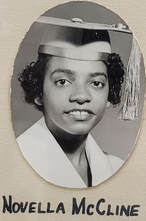
Novella McCline-Page PHS Class of 1956
Troy Merritt, Jr. PHS Class of 1966
Troy Merritt, Jr. is a native Nashvillian. He is a 1966 graduate of Pearl High School. He received both the Bachelor of Science (1970) and Master of Arts (1973) degrees from Fisk University. In 1990, while serving as pastor of historic Avery Chapel in Memphis, he received the of Master of Divinity degree, Cum Laude, and the Alston Award as the Outstanding Black Student, from Memphis Theological Seminary. He has also studied at American Baptist College, Trevecca Nazarene University, and Tennessee State University.
As a teenager, he participated in the Nashville civil rights marches, during the 1960-1968 era. He was influenced by the Revs. Andrew White, Kelly Miller Smith, and others. This led him to be and advocate for those marginalized by society.
The Reverend Mr. Merritt has worked with at-risk youth in a variety of city and state government programs as well as in private not for profit mental health centers. Positions held include: teacher, counselor, counseling supervisor, program director/coordinator, for the various programs. He has taught graduate level courses and trained many teachers in the area of positive approaches to classroom and behavior management. Also, as a trainer of department supervisors/managers, and as a policy compliance monitor, he traveled across the State of Tennessee serving prison and juvenile facility staffs.
Reverend Merritt accepted the call to preach at Lee Chapel AME Church, Nashville under the Reverend Charles A. Jones in February 1978. He was ordained a Deacon, by the late Bishop Howard T. Primm in 1979 at Greater Bethel, Nashville, and appointed to two churches. In 1981, he was ordained an Elder at Lee Chapel, Nashville, by the late Bishop William F. Ball, Sr. He has been privileged to pastor Sulphur Spring, Cunningham, Tennessee and Mt. Zion, Bellsburg, Tennessee (a circuit); Ebenezer, Clarksville, Tennessee; Avery Chapel, Memphis, Tennessee; St. John, Frankfort, Kentucky; Salem, Nashville, Tennessee, St. Paul, Columbia, Tennessee, and Historic St. John, Nashville, Tennessee 2012-2014.
Service to the AME church includes: 13th District Director of Christian Education (1990-2002), Dean Tennessee Conference Board of Examiners (member since 1992, Assistant Dean 2000-2002) 2002-2004, Dean South Nashville District Board of Christian Education (1992-2004), Boards of Examiners, member – West Tennessee, Kentucky, Tennessee Conferences (1985-2004).
From October 2004-2012, Reverend Merritt served as Presiding Elder of the South Nashville District having been appointed eight times to this office by Bishop Vashti Murphy McKenzie, Presiding Prelate of the 13th Episcopal District. In October 2014, Bishop Jeffrey N. Leath appointed him to the newly formed Nashville District, where he currently serves.
Reverend Merritt is a member of Kappa Alpha Psi Fraternity, Inc., the NAACP (Life Member), Fellowship of Christian Educators (FCE), Nashville Organized for Action and Hope (NOAH), Metro Retired Education Association, the Interdenominational Ministers Fellowship (IMF) Nashville, and the Presiding Elders Connectional Council of the African Methodist Episcopal Church.
During the Rep. John Lewis Way Dedication Celebration, Reverend Merritt and three other Pearl High School Heritage Classes Foundation, Inc. members were recognized as Nashville Civil Rights Heroes; and were awarded Keys to the City, July 17, 2021.
Reverend Merritt is married to the former Brenda Rhodes (PHS’66), who retired as the Assistant Dean of Student and Academic Affairs at Meharry Medical College in Nashville, Tennessee, in June 2016. They have four (4) children, and six (6) grandchildren.
He is the brother of the late George Berry, Jr. PHS’53, and Dr. Mary Frances Berry (PHS’54}.
Noble Virgil Blackwell PHS Class of 1952
Born in Nashville, TN, to James and Susie Lee Blackwell, Noble began his radio career reading announcements over the high school PA system. His distinguished voice landed him a part time DJ job at WSOK, a local radio station (now known as WVOL black urban radio) and part of the renown Rounsaville Media Group. The relationship with this media group would be the catalyst for a career path in radio that was unconscionable for a young African American man before civil rights. He was sent to WEFC in Miami where his DJ personality, and prominence as "The Honey Bee," was born. He then became the Program Director at WIOK in Tampa before being asked to return to WVOL to help community relations and was quickly promoted to Account Executive and then Sales Manager.
From 1966-1968 Noble was the National Director of Alumni Affairs for Meharry Medical College traveling all over the country setting up Alumni chapters and developing innovative programs in support of the sixty-six million dollar expansion program reporting directly to the President of the College. The assassination of Dr. Martin Luther King Jr. sparked the '68 riots and the black community threatened to burn down the white owned and operated radio station. The President of Rounsaville called Noble, the voice of calm and respected leader in the community to take over the station as the Vice President and General Manager. A very bold move that catapulted WVOL to the forefront. His community outreach included auditions for internships for high school students which started the career of teen "Oprah Winfrey." It was something about her voice," Noble said. Under his tutelage Oprah became a newscaster, Ms. Fire Prevention, and host of a Saturday morning teen program.
While still at WVOL, Noble recognized the need to promote local artists. He started NB Productions and produced his signature project and accomplishment, "Night Train"(a joint venture with WLAC-TV, a CBS affiliate). Noble was the writer, producer and host of "Night Train," the first African American program to be syndicated by Viacom in 30 countries. The early production of Night Train included young people dancing, but the church community came out against the show, which gave birth to the "Night Train Revue." He would tell his wife, "Baby, the kids just want to dance." So on the weekends, Noble produced and traveled with a crew to shoot the roadshow which sparked the careers of many notable musicians including Jimi Hendrix, who was in the House Band. In 2005 his contributions to The Music City (Nashville) were featured in the "Night Train to Nashville" an exhibit at the Country Music Hall of Fame and later included in the Tennessee Radio Hall of Fame.
In 1972 the son of Nashville made a giant step to venture into broadcast TV as the Director of Broadcasting at CBS affiliate WCAU-TV (channel 10) in Philadelphia. He continued to climb the corporate ladder moving to New York to become the Division Director of Community Relations responsible for overall performance regarding FCC license, public affairs, news and children's programming for all five CBS owned stations. As Director of Corporate Staff Services Noble was the acting liaison officer for CBS with various community and public service organizations.
After seven years (from 1972-1979) with CBS in the television Industry Noble's first love, "radio," came calling. He was named Vice President and General Manager of WNJR Radio in Newark, NJ, which put him back in the community providing opportunities for creative youth involvement. It was his decision to play the Sugarhill Gang's "Rapper's Delight" on radio and produced the first rap concert at Paradisio Night Club, which ushered in the new genre we now call hip hop. He soon revived NB Productions and became one of the premier promoters in the nation. He was credited with promoting the first major rap tour; The Def Jam Tour headlined by LL Cool J, other notable tours included: Kool & The Gang's "She's Fresh" tour for Coca-Cola, the Cameo "Word Up" Tour and The Force MD's "Love is a House" tour, to name a few.
In his later years Noble accomplished his life's dream when he purchased a AM/FM combo station in northeastern Pennsylvania. WLSP FM and WCDL AM became the first radio stations owned by an African American with a nontraditional format. WLSP was 24 hour contemporary country, which at the time was a new format and WCDL AM was contemporary hit radio (CHR). He never knew one day he would be featured in the Country Music Hall of Fame for his contributions.
When Noble retired he continued to stay relevant in the industry offering consulting services. From 1988 to 1990 he worked with the National Black Network to persuade major advertisers to include advertising in urban black radio markets. In the twilight of his life Noble Blackwell was ordained a Deacon in the Baptist Ministry and the overseer of StrategicMinistries Group, a multi-faceted young adult ministry serving New York/New Jersey. Noble applied his immense knowledge attained through years in the broadcast industry to introduce a ground breaking gospel video series, Urban Contemporary Gospel, a 30-minute show syndicated by New York-based JME Entertainment.
Noble has been recognized on a national level by the National Association of TV & Radio Announcers as Man of the Year in 1972 and Citation of Meritorious Achievement for Management in 1968. He received a Citation from the New York chapter of the Public Relations Society of America Inc. as head of the committee on minorities in 1977. He also received a Certificate of Merit from United Way of Tri-State Inc. that same year. Noble Blackwell has been recognized by the Delaware Valley Chapter of Broadcast Pioneers as a Pioneer in 1976 and earned an Award in Recognition of Service from WCAU-TV Philadelphia in 1975. In his hometown of Nashville, Noble Blackwell was awarded the Certificate of Appreciation from Donelson Hermitage Jaycees in 1969, the Tennessee State Sports Media Award from 1971 to 1972, and the Certificate of Merit from the Military Department, State of Tennessee. Furthermore, he was elected to the board of directors of the Better Business Bureau from 1971 to 1972, was vice chair of the Nashville Chamber of Commerce in 1971, and was a member of the Nashville Broadcasting Pioneers from 1970 to 1972 and the Nashville Advertising Federation in 1972. Noble Blackwell attributes his success to his faith in God, his deep understanding of his purpose, and absolute determination.
The following poem, "Recollections about a Great Weaver," was written by Dianne Oyama Dixon in memory of Mr. Blackwell:
"It was as early as yesterday and as far away as years ago, that Noble V. Blackwell began pulling together the threads of our lives. To him there were no ugly fabrics or unkind colors. For Noble saw you with his heart... he saw what was deep inside.
He was a simple man, a loving man, a caring man, a giving man, a Christian man, that saw every life that touched his as having great value and worth. And he treated each as a precious treasure.
Sometimes his lessons to us brought tears to his eyes, tears of joy. They had to be, because the tears flowed he would speak of how thankful he was for the many blessings he had received during his life. And yet, we were the receivers of the blessings just to know him.
He spoke about developing our minds, uplifting our spirits, setting goals, taking chances, individuality, self-respect, dignity, faith in God and one's self, and of course having dreams. He walked a walk that blazed trails, that set trends, that opened doors through whom he carried many people.
He was a weaver that set in motion fabrics that he connected to create a tapestry of love, color, hope and strength.
As gentle as a breeze that touches us and moves on Noble was claimed to God's kingdom. Until that time we shall meet again let us exemplify his living by loving one another. "Be Good to Your Neighbor" (The Honeybee)
Noble Blackwell passed away on September 10, 1994. His legacy lives on through his wife, children, relatives and friends who have embraced his entrepreneurial spirit finding success in radio, business, sports and entertainment, and ministry. In memory of his spirit and his work, his family is working on a documentary that will chronicle his life. Those with any photos, stories or memories are invited to share them with the family at Noble Blackwell on Facebook.
Born in Nashville, TN, to James and Susie Lee Blackwell, Noble began his radio career reading announcements over the high school PA system. His distinguished voice landed him a part time DJ job at WSOK, a local radio station (now known as WVOL black urban radio) and part of the renown Rounsaville Media Group. The relationship with this media group would be the catalyst for a career path in radio that was unconscionable for a young African American man before civil rights. He was sent to WEFC in Miami where his DJ personality, and prominence as "The Honey Bee," was born. He then became the Program Director at WIOK in Tampa before being asked to return to WVOL to help community relations and was quickly promoted to Account Executive and then Sales Manager.
From 1966-1968 Noble was the National Director of Alumni Affairs for Meharry Medical College traveling all over the country setting up Alumni chapters and developing innovative programs in support of the sixty-six million dollar expansion program reporting directly to the President of the College. The assassination of Dr. Martin Luther King Jr. sparked the '68 riots and the black community threatened to burn down the white owned and operated radio station. The President of Rounsaville called Noble, the voice of calm and respected leader in the community to take over the station as the Vice President and General Manager. A very bold move that catapulted WVOL to the forefront. His community outreach included auditions for internships for high school students which started the career of teen "Oprah Winfrey." It was something about her voice," Noble said. Under his tutelage Oprah became a newscaster, Ms. Fire Prevention, and host of a Saturday morning teen program.
While still at WVOL, Noble recognized the need to promote local artists. He started NB Productions and produced his signature project and accomplishment, "Night Train"(a joint venture with WLAC-TV, a CBS affiliate). Noble was the writer, producer and host of "Night Train," the first African American program to be syndicated by Viacom in 30 countries. The early production of Night Train included young people dancing, but the church community came out against the show, which gave birth to the "Night Train Revue." He would tell his wife, "Baby, the kids just want to dance." So on the weekends, Noble produced and traveled with a crew to shoot the roadshow which sparked the careers of many notable musicians including Jimi Hendrix, who was in the House Band. In 2005 his contributions to The Music City (Nashville) were featured in the "Night Train to Nashville" an exhibit at the Country Music Hall of Fame and later included in the Tennessee Radio Hall of Fame.
In 1972 the son of Nashville made a giant step to venture into broadcast TV as the Director of Broadcasting at CBS affiliate WCAU-TV (channel 10) in Philadelphia. He continued to climb the corporate ladder moving to New York to become the Division Director of Community Relations responsible for overall performance regarding FCC license, public affairs, news and children's programming for all five CBS owned stations. As Director of Corporate Staff Services Noble was the acting liaison officer for CBS with various community and public service organizations.
After seven years (from 1972-1979) with CBS in the television Industry Noble's first love, "radio," came calling. He was named Vice President and General Manager of WNJR Radio in Newark, NJ, which put him back in the community providing opportunities for creative youth involvement. It was his decision to play the Sugarhill Gang's "Rapper's Delight" on radio and produced the first rap concert at Paradisio Night Club, which ushered in the new genre we now call hip hop. He soon revived NB Productions and became one of the premier promoters in the nation. He was credited with promoting the first major rap tour; The Def Jam Tour headlined by LL Cool J, other notable tours included: Kool & The Gang's "She's Fresh" tour for Coca-Cola, the Cameo "Word Up" Tour and The Force MD's "Love is a House" tour, to name a few.
In his later years Noble accomplished his life's dream when he purchased a AM/FM combo station in northeastern Pennsylvania. WLSP FM and WCDL AM became the first radio stations owned by an African American with a nontraditional format. WLSP was 24 hour contemporary country, which at the time was a new format and WCDL AM was contemporary hit radio (CHR). He never knew one day he would be featured in the Country Music Hall of Fame for his contributions.
When Noble retired he continued to stay relevant in the industry offering consulting services. From 1988 to 1990 he worked with the National Black Network to persuade major advertisers to include advertising in urban black radio markets. In the twilight of his life Noble Blackwell was ordained a Deacon in the Baptist Ministry and the overseer of StrategicMinistries Group, a multi-faceted young adult ministry serving New York/New Jersey. Noble applied his immense knowledge attained through years in the broadcast industry to introduce a ground breaking gospel video series, Urban Contemporary Gospel, a 30-minute show syndicated by New York-based JME Entertainment.
Noble has been recognized on a national level by the National Association of TV & Radio Announcers as Man of the Year in 1972 and Citation of Meritorious Achievement for Management in 1968. He received a Citation from the New York chapter of the Public Relations Society of America Inc. as head of the committee on minorities in 1977. He also received a Certificate of Merit from United Way of Tri-State Inc. that same year. Noble Blackwell has been recognized by the Delaware Valley Chapter of Broadcast Pioneers as a Pioneer in 1976 and earned an Award in Recognition of Service from WCAU-TV Philadelphia in 1975. In his hometown of Nashville, Noble Blackwell was awarded the Certificate of Appreciation from Donelson Hermitage Jaycees in 1969, the Tennessee State Sports Media Award from 1971 to 1972, and the Certificate of Merit from the Military Department, State of Tennessee. Furthermore, he was elected to the board of directors of the Better Business Bureau from 1971 to 1972, was vice chair of the Nashville Chamber of Commerce in 1971, and was a member of the Nashville Broadcasting Pioneers from 1970 to 1972 and the Nashville Advertising Federation in 1972. Noble Blackwell attributes his success to his faith in God, his deep understanding of his purpose, and absolute determination.
The following poem, "Recollections about a Great Weaver," was written by Dianne Oyama Dixon in memory of Mr. Blackwell:
"It was as early as yesterday and as far away as years ago, that Noble V. Blackwell began pulling together the threads of our lives. To him there were no ugly fabrics or unkind colors. For Noble saw you with his heart... he saw what was deep inside.
He was a simple man, a loving man, a caring man, a giving man, a Christian man, that saw every life that touched his as having great value and worth. And he treated each as a precious treasure.
Sometimes his lessons to us brought tears to his eyes, tears of joy. They had to be, because the tears flowed he would speak of how thankful he was for the many blessings he had received during his life. And yet, we were the receivers of the blessings just to know him.
He spoke about developing our minds, uplifting our spirits, setting goals, taking chances, individuality, self-respect, dignity, faith in God and one's self, and of course having dreams. He walked a walk that blazed trails, that set trends, that opened doors through whom he carried many people.
He was a weaver that set in motion fabrics that he connected to create a tapestry of love, color, hope and strength.
As gentle as a breeze that touches us and moves on Noble was claimed to God's kingdom. Until that time we shall meet again let us exemplify his living by loving one another. "Be Good to Your Neighbor" (The Honeybee)
Noble Blackwell passed away on September 10, 1994. His legacy lives on through his wife, children, relatives and friends who have embraced his entrepreneurial spirit finding success in radio, business, sports and entertainment, and ministry. In memory of his spirit and his work, his family is working on a documentary that will chronicle his life. Those with any photos, stories or memories are invited to share them with the family at Noble Blackwell on Facebook.
Joseph C. White Taught at Pearl High School
In 1959, he set up the state's first high school electronics program at Pearl High School.
Joseph C. White - A Tuskegee Airmen Pilot
World War II brought many changes to American society, but the United States military remained racially segregated until 1948. The Department of War established separate units for African-American soldiers. One such group was the 332nd Fighter Group, part of the famed Tuskegee Airmen. The Tuskegee Airmen consisted of African-American pilots and support staff who graduated from the Tuskegee Institute program that was created in 1941. While the program began as an experiment to determine the capabilities of African Americans in the Army Air Force, their performance earned them respect among their white comrades. One of these airmen was fighter pilot Lieutenant Joseph Clyde White of the 301st Squadron.
Cadet Joseph C. White
White was born in Lawrence County, Alabama in 1921, but grew up in Chattanooga, where he lived with his aunt in the 1930s. He joined the Tuskegee cadet program in 1943 to become a pilot. During his service, he spent nine months on air assignments in North Africa, Italy, France and Germany. The Allied bomber groups had sustained high casualty rates during their bombing runs over Europe and North Africa. They were desperate to find fighters who could successfully escort them on their missions and engage enemy fighters when necessary. The Red Tails, as they were known because of the red paint on the tails of their aircraft, became a popular choice for these missions as a result of their low rate of bomber casualties
Lieutenant Joseph C. White
White described his service in a veteran survey collected by the Tennessee State Library & Archives in 1996. In his responses, White remarked that he felt his greatest success during service was “not losing a single Allied Bomber to Enemy fighters.” Despite the work the Tuskegee Airmen were doing to prove African Americans were indeed highly capable of maneuvering combat aircraft, their standard of living in the U.S. Army Air Corps was less than ideal. In his survey, White stated that the living conditions for officers in the 301st Squadron were poor and there were no recreational activities “structured for Negro troops.” He also notes that although he “disliked segregation of the races most,” his experiences with the Tuskegee Airmen provided him with opportunities after the war.
The United States government provided discharged military personnel with access to education through the G. I. Bill. White used this benefit to obtain his bachelor’s degree in physics from Tennessee State University. He continued with his education, receiving two master’s degrees in science education and administration as well as a doctorate in physics. White used his knowledge to become an instructor in flight, radar and electronics. He also worked as a physicist and teacher, establishing an electronics program at Pearl High School in Nashville. After his retirement, White frequently appeared at speaking engagements to discuss his role in the Tuskegee Airmen and the experiences he had as a pilot during World War II
The success of the Tuskegee program may have been a contributing factor in President Truman’s decision to issue Executive Order 9981 in July of 1948, which led to the desegregation of the armed forces. In fact, the leaders of the newly created U. S. Air Force had already determined that integration was necessary for effective military service and had declared their intentions to integrate the Air Force as early as April 1948. The program’s notoriety provided a concrete example of African Americans exceeding expectations and helped set the stage for the Civil Rights Movement that would follow over the next two decades.
World War II brought many changes to American society, but the United States military remained racially segregated until 1948. The Department of War established separate units for African-American soldiers. One such group was the 332nd Fighter Group, part of the famed Tuskegee Airmen. The Tuskegee Airmen consisted of African-American pilots and support staff who graduated from the Tuskegee Institute program that was created in 1941. While the program began as an experiment to determine the capabilities of African Americans in the Army Air Force, their performance earned them respect among their white comrades. One of these airmen was fighter pilot Lieutenant Joseph Clyde White of the 301st Squadron.
Cadet Joseph C. White
White was born in Lawrence County, Alabama in 1921, but grew up in Chattanooga, where he lived with his aunt in the 1930s. He joined the Tuskegee cadet program in 1943 to become a pilot. During his service, he spent nine months on air assignments in North Africa, Italy, France and Germany. The Allied bomber groups had sustained high casualty rates during their bombing runs over Europe and North Africa. They were desperate to find fighters who could successfully escort them on their missions and engage enemy fighters when necessary. The Red Tails, as they were known because of the red paint on the tails of their aircraft, became a popular choice for these missions as a result of their low rate of bomber casualties
Lieutenant Joseph C. White
White described his service in a veteran survey collected by the Tennessee State Library & Archives in 1996. In his responses, White remarked that he felt his greatest success during service was “not losing a single Allied Bomber to Enemy fighters.” Despite the work the Tuskegee Airmen were doing to prove African Americans were indeed highly capable of maneuvering combat aircraft, their standard of living in the U.S. Army Air Corps was less than ideal. In his survey, White stated that the living conditions for officers in the 301st Squadron were poor and there were no recreational activities “structured for Negro troops.” He also notes that although he “disliked segregation of the races most,” his experiences with the Tuskegee Airmen provided him with opportunities after the war.
The United States government provided discharged military personnel with access to education through the G. I. Bill. White used this benefit to obtain his bachelor’s degree in physics from Tennessee State University. He continued with his education, receiving two master’s degrees in science education and administration as well as a doctorate in physics. White used his knowledge to become an instructor in flight, radar and electronics. He also worked as a physicist and teacher, establishing an electronics program at Pearl High School in Nashville. After his retirement, White frequently appeared at speaking engagements to discuss his role in the Tuskegee Airmen and the experiences he had as a pilot during World War II
The success of the Tuskegee program may have been a contributing factor in President Truman’s decision to issue Executive Order 9981 in July of 1948, which led to the desegregation of the armed forces. In fact, the leaders of the newly created U. S. Air Force had already determined that integration was necessary for effective military service and had declared their intentions to integrate the Air Force as early as April 1948. The program’s notoriety provided a concrete example of African Americans exceeding expectations and helped set the stage for the Civil Rights Movement that would follow over the next two decades.
ERNEST “RIP” PATTON PHS Class of 1958
Patton attended Tennessee State University in 1960 (then called Tennessee Agricultural and Industrial University) where he was a drum major in the marching band. His goal was to become a music teacher or band director. However, he was also eager for change in his hometown, and he put his music interests aside when he had an opportunity to fight for racial equality by joining the newly formed Nashville branch of the Student Nonviolent Coordinating Committee (SNCC) in 1960.
Patton participated in the Nashville student movement through sit-ins, stand-ins, and boycotts. To prepare for action, students went through intensive “boot camp” trainings to learn about nonviolence philosophies and practiced tactics through role-playing. The first of four sit-ins occurred on February 13, 1960, just over a week after the February 1 sit-ins in Greensboro, North Carolina, which were considered the first direct protest action of the 1960s. On the fourth Nashville sit-in, eighty-seven students were arrested, which pushed the wider Nashville black community to join. Patton and other students in the Nashville nonviolent, direct action campaign made notable progress, as they successfully integrated downtown lunch counters by the end of 1960. However, it took civil rights activists like Patton four years to desegregate the whole city.
Protests in Nashville prepared students to continue their activism in the larger movement sweeping the south. As a twenty-one-year-old student, Patton traveled to Montgomery, Alabama, to provide assistance to the Freedom Riders. Patton officially joined the Freedom Riders on May 24, 1961, in the Greyhound bus traveling from Nashville to Jackson, Mississippi.
The Freedom Riders were intergenerational and interracial men and women who courageously traveled together on buses and trains to challenge segregation in the interstate transportation system. Due to widespread racism and, in particular, opposition to racial integration, the Freedom Riders met ongoing mob violence, bombings, and imprisonment. When Patton’s bus reached Jackson, he was arrested. Along with three hundred other African Americans, Patton was taken to the notoriously brutal Mississippi State Penitentiary, also known as Parchman Prison Farm.
Because of his involvement in the Freedom Riders, Patton was one of fourteen Tennessee State University students expelled for their activities. Later given the opportunity to return to Tennessee State, he decided instead to pursue other interests, and, as a result, he never finished his degree. He worked various jobs, including as a jazz musician and a long distance truck driver. In 2011 he was also featured in Freedom Riders, a PBS documentary based on the book by the same name.
Today, Patton, a renowned community leader, spends time sharing his experiences from the Nashville student movement and Freedom Riders to various civil rights tours of the Deep South. Patton also regularly speaks to groups around the country, especially young students. Through telling his personal story, Patton brings light to the stories other important foot soldiers he worked with during the American Black freedom struggle.
Vivien T. Thomas PHS Class of 1929
Vivien Theodore Thomas (August 29, 1910 – November 26, 1985)[1] was an African-American surgical technician who developed the procedures used to treat blue baby syndrome (now known as cyanotic heart disease) in the 1940s. He was the assistant to surgeon Alfred Blalock in Blalock's experimental animal laboratory at Vanderbilt University in Nashville, Tennessee, and later at the Johns Hopkins University in Baltimore, Maryland. He served as supervisor of the surgical laboratories at Johns Hopkins for 35 years. In 1976 Hopkins awarded him an honorary doctorate and named him an instructor of surgery for the Johns Hopkins School of Medicine.[2]Without any education past high school, Thomas rose above poverty and racism to become a cardiac surgery pioneer and a teacher of operative techniques to many of the country's most prominent surgeons.
Thomas was born in New Iberia, Louisiana, and was the son of Mary (Eaton) and William Marco Thomas.[4][5] The grandson of a slave, he attended Pearl High School in Nashville in the 1920s.[6] Thomas had hoped to attend college and become a doctor, but the Great Depression derailed his plans.[7] He worked at Vanderbilt University in the summer of 1929 doing carpentry[8] but was laid off in the fall. In that same year, Thomas enrolled in the Tennessee Agricultural and Industrial College as a premedical student.[9] In the wake of the stock market crash in October, Thomas put his educational plans on hold, and, through a friend, in February 1930 secured a job as surgical research technician with Dr. Alfred Blalock at Vanderbilt University.[10] On his first day of work, Thomas assisted Blalock with a surgical experiment on a dog.[11] At the end of Thomas's first day, Blalock told Thomas they would do another experiment the next morning. Blalock told Thomas to "come in and put the animal to sleep and get it set up". Within a few weeks, Thomas was starting surgery on his own.[12] Thomas was classified and paid as a janitor,[13] despite the fact that by the mid-1930s, he was doing the work of a Postdoctoral researcher in the lab.
Before meeting Blalock, Thomas married Clara and had two daughters.[14] When Nashville's banks failed nine months after starting his job with Blalock and Thomas' savings were wiped out,[10] he abandoned his plans for college and medical school, relieved to have even a low-paying job as the Great Depression deepened.
Thomas and Blalock did groundbreaking research into the causes of hemorrhagic[15] and traumatic shock.[14] This work later evolved into research on crush syndrome[16] and saved the lives of thousands of soldiers on the battlefields of World War II.[16] In hundreds of experiments, the two disproved traditional theories which held that shock was caused by toxins in the blood.[17] Blalock, a highly original scientific thinker and something of an iconoclast, had theorized that shock resulted from fluid loss outside the vascular bed and that the condition could be effectively treated by fluid replacement.[17] Assisted by Thomas, he was able to provide incontrovertible proof of this theory, and in so doing, he gained wide recognition in the medical community by the mid-1930s. At this same time, Blalock and Thomas began experimental work in vascular and cardiac surgery,[15] defying medical taboos against operating upon the heart. It was this work that laid the foundation for the revolutionary lifesaving surgery they were to perform at Johns Hopkins a decade later.
By 1940, the work Blalock had done with Thomas placed him at the forefront of American surgery, and when he was offered the position of Chief of Surgery at his alma mater Johns Hopkins in 1941,[18] he requested that Thomas accompany him.[18] Thomas arrived in Baltimorewith his family in June of that year,[19] confronting a severe housing shortage and a level of racism worse than they had endured in Nashville.[20] Hopkins, like the rest of Baltimore, was rigidly segregated, and the only black employees at the institution were janitors. When Thomas walked the halls in his white lab coat, many heads turned. He began changing into his city clothes when he walked from the laboratory to Blalock's office because he received so much attention.[21] During this time, he lived in the 1200 block of Caroline Street in the community now known as Oliver, Baltimore
In 1943, while pursuing his shock research, Blalock was approached by pediatric cardiologist Helen Taussig,[22] who was seeking a surgical solution to a complex and fatal four-part heart anomaly called tetralogy of Fallot (also known as blue baby syndrome, although other cardiac anomalies produce blueness, or cyanosis). In infants born with this defect, blood is shunted past the lungs, thus creating oxygen deprivation and a blue pallor.[22] Having treated many such patients in her work in Hopkins's Harriet Lane Home, Taussig was desperate to find a surgical cure.
Thomas was charged with the task of first creating a blue baby-like condition in a dog, and then correcting the condition by means of the pulmonary-to-subclavian anastomosis.[24] Among the dogs on whom Thomas operated was one named Anna, who became the first long-term survivor of the operation and the only animal to have her portrait hung on the walls of Johns Hopkins. In nearly two years of laboratory work involving 200 dogs, Thomas was able to replicate two of the four cardiac anomalies involved in tetralogy of Fallot.[25] He did demonstrate that the corrective procedure was not lethal, thus persuading Blalock that the operation could be safely attempted on a human patient.[26] Blalock was impressed with Thomas's work; when he inspected the procedure performed on Anna, he reportedly said, "This looks like something the Lord made."[27] Even though Thomas knew he was not allowed to operate on patients at that time, he still followed Blalock's rules and assisted him during surgery.[28]
On November 29, 1943 , the procedure was first tried on an eighteen-month-old infant named Eileen Saxon.[28] The blue baby syndrome had made her lips and fingers turn blue, with the rest of her skin having a very faint blue tinge. She could only take a few steps before beginning to breathe heavily. Because no instruments for cardiac surgery then existed, Thomas adapted the needles and clamps for the procedure from those in use in the animal lab.[29] During the surgery itself, at Blalock's request, Thomas stood on a step stool at Blalock's shoulder and coached him step by step through the procedure.[30] Thomas performed the operation hundreds of times on a dog, whereas Blalock only once as Thomas' assistant.[30] The surgery was not completely successful, though it did prolong the infant's life for several months.[31] Blalock and his team operated again on an 11-year-old girl, this time with complete success, and the patient was able to leave the hospital three weeks after the surgery.[31] Next, they operated upon a six-year-old boy, who dramatically regained his color at the end of the surgery.[31] The three cases formed the basis for the article that was published in the May 1945 issue of the Journal of the American Medical Association, giving credit to Blalock and Taussig for the procedure. Thomas received no mention.[29]
News of this groundbreaking story was circulated around the world by the Associated Press.[29] Newsreels touted the event, greatly enhancing the status of Johns Hopkins and solidifying the reputation of Blalock, who had been regarded as a maverick up until that point by some in the Hopkins old guard.[32] Thomas' contribution remained unacknowledged, both by Blalock and by Hopkins. Within a year, the operation known as the Blalock-Thomas-Taussig shunt had been performed on more than 200 patients at Hopkins, with parents bringing their suffering children from thousands of miles away.[32]
Thomas's surgical techniques included one he developed in 1946 for improving circulation in patients whose great vessels (the aorta and the pulmonary artery) were transposed.[33] A complex operation called an atrial septectomy, the procedure was executed so flawlessly by Thomas that Blalock, upon examining the nearly undetectable suture line, was prompted to remark, "Vivien, this looks like something the Lord made".[33] To the host of young surgeons Thomas trained during the 1940s,[34] he became a figure of legend, the model of a dexterous and efficient cutting surgeon. "Even if you'd never seen surgery before, you could do it because Vivien made it look so simple," the renowned surgeon Denton Cooley[28] told Washingtonian magazine in 1989. "There wasn't a false move, not a wasted motion, when he operated." Surgeons like Cooley, along with Alex Haller,[35] Frank Spencer,[36] Rowena Spencer,[37] and others credited Thomas with teaching them the surgical technique that placed them at the forefront of medicine in the United States. Despite the deep respect Thomas was accorded by these surgeons and by the many black lab technicians he trained at Hopkins, he was not well paid.[38] He sometimes resorted to working as a bartender, often at Blalock's parties. This led to the peculiar circumstance of his serving drinks to people he had been teaching earlier in the day. Eventually, after negotiations on his behalf by Blalock, he became the highest paid technician at Johns Hopkins by 1946, and by far the highest paid African-American on the institution's rolls.[39] Although Thomas never wrote or spoke publicly about his ongoing desire to return to college and obtain a medical degree, his widow, the late Clara Flanders Thomas, revealed in a 1987 interview with Washingtonian writer Katie McCabe that her husband had clung to the possibility of further education throughout the blue baby period and had only abandoned the idea with great reluctance. Mrs. Thomas stated that in 1947, Thomas had investigated the possibility of enrolling in college and pursuing his dream of becoming a doctor, but had been deterred by the inflexibility of Morgan State University, which refused to grant him credit for life experience and insisted that he fulfill the standard freshman requirements. Realizing that he would be 50 years old by the time he completed college and medical school, Thomas decided to give up the idea of further education.
Blalock's approach to the issue of Thomas's race was complicated and contradictory throughout their 34-year partnership. On the one hand, he defended his choice of Thomas to his superiors at Vanderbilt and to Hopkins colleagues, and he insisted that Thomas accompany him in the operating room during the first series of tetralogy operations. On the other hand, there were limits to his tolerance, especially when it came to issues of pay, academic acknowledgment, and his social interaction outside of work. Tension with Blalock continued to build when he failed to recognize the contributions that Thomas had made in the world-famous blue baby procedure, which led to a rift in their relationship. Thomas was absent in official articles about the procedure, as well as in team pictures that included all of the doctors involved in the procedure.[40]
After Blalock's death from cancer in 1964 at the age of 65,[41] Thomas stayed at Hopkins for 15 more years. In his role as director of Surgical Research Laboratories, he mentored a number of African-American lab technicians as well as Hopkins' first black cardiac resident, Levi Watkins, Jr., whom Thomas assisted with his groundbreaking work in the use of the automatic implantable defibrillator.
Thomas' nephew, Koco Eaton, graduated from the Johns Hopkins School of Medicine, trained by many of the physicians his uncle had trained. Eaton trained in orthopedics and is now the team doctor for the Tampa Bay Rays.
In 1968, the surgeons Thomas trained — who had then become chiefs of surgical departments throughout America — commissioned the painting of his portrait (by Bob Gee, oil on canvas, 1969, The Johns Hopkins Alan Mason Chesney Medical Archives)[42] and arranged to have it hung next to Blalock's in the lobby of the Alfred Blalock Clinical Sciences Building.
In 1976, Johns Hopkins University presented Thomas with an honorary doctorate.[2] Because of certain restrictions, he received an Honorary Doctor of Laws, rather than a medical doctorate, but it did allow the staff and students of Johns Hopkins Hospital and Johns Hopkins School of Medicine to call him doctor. After having worked there for 37 years, Thomas was also finally appointed to the faculty of the School of Medicine as Instructor of Surgery. Due to his lack of an official medical degree, he was never allowed to operate on a living patient.[2]
In July 2005, Johns Hopkins School of Medicine began the practice of splitting incoming first-year students into four colleges, each named for famous Hopkins faculty members who had major impacts on the history of medicine. Thomas was chosen as one of the four, along with Helen Taussig, Florence Sabin, and Daniel Nathans.
Following his retirement in 1979, Thomas began work on an autobiography.[43] He died of pancreatic cancer on November 26, 1985, and the book was published just days later. Having learned about Thomas on the day of his death, Washingtonian writer Katie McCabe brought his story to public attention in a 1989 article entitled "Like Something the Lord Made", which won the 1990 National Magazine Award for Feature Writing and inspired filmmaker Andrea Kalin to make the PBS documentary Partners of the Heart,[44] which was broadcast in 2003 on PBS's American Experience and won the Organization of American Historians's Erik Barnouw Award for Best History Documentary in 2004.[45] McCabe's article, brought to Hollywood by Washington, D.C. dentist Irving Sorkin,[46] formed the basis for the Emmy and Peabody Award-winning 2004 HBO film Something the Lord Made.
Thomas's legacy as an educator and scientist continued with the institution of the Vivien Thomas Young Investigator Awards, given by the Council on Cardiovascular Surgery and Anesthesiology beginning in 1996. In 1993, the Congressional Black Caucus Foundation instituted the Vivien Thomas Scholarship for Medical Science and Research sponsored by GlaxoSmithKline. In fall 2004, the Baltimore City Public School System opened the Vivien T. Thomas Medical Arts Academy, and on January 29, 2008, MedStar Health unveiled the first "Rx for Success" program at the Academy, joining the conventional curriculum with specialized coursework geared to the health care professions. In the halls of the school hangs a replica of Thomas's portrait commissioned by his surgeon-trainees in 1969.[42] The Journal of Surgical Case Reports announced in January 2010 that its annual prizes for the best case report written by a doctor and best case report written by a medical student would be named after Thomas.[47]
Robert Churchwell PHS Class of 1940
A war veteran and pioneering journalist, Robert Churchwell was one of the first African Americans to integrate a prominent southern newspaper.
Churchwell was born on September 9, 1917 in Clifton, Tennessee. He served four years in the U.S. Army during World War II. Afterwards, he attended and graduated from Fisk University, where he majored in English.
In 1950, Robert Churchwell was hired at the daily newspaper, The Nashville Banner , and became one of the first blacks to work full-time as a reporter at a prominent Southern newspaper. At the time, the Banner was known for its defense of the "old South" and its segregationist ways. Churchwell was originally hired to report on the African American community, as a way to increase readership among blacks. "They hired me so the Banner could start running pictures of Negroes and Negro stories all over the paper, not just in one part," said Churchwell during his videotaped interview with NVLP in 2002. Churchwell later became the paper's education writer.
At first, employees at the Banner would not let Churchwell work in the newsroom. For five years, he wrote his stories at home and walked to the paper to deliver them to the city editor. Later, when he was given a desk in the newsroom, according to Churchwell, only a half dozen of his white colleagues would speak to him. For 31 years, Churchwell worked for the Banner , retiring in 1981.
In 1965, Churchwell became the first African American member of the Middle Tennessee Chapter of Sigma Delta Chi (now known as the Society of Professional Journalists), a society in which he served as chapter vice president in 1969.
After retirement, Churchwell worked for Tennessee State University (TSU) in its Bureau of Public Relations. Because of his experience in the media and his familiarity with TSU's program, Churchwell was appointed as its interim director in 1982.[1]
In 1994, Churchwell was named a charter member of the National Association of Black Journalists; and inducted into the association's region VI Hall of Fame.[2]
Churchwell's previous writing experience includes a news magazine he co-founded, called Yours , and writing columns for the Commentator , a local tabloid-size paper published for the African American community.
On February 1, 2009, Churchwell passed away. He was 91. Churchwell is survived by his wife, Mary Elizabeth Buckingham, and their five children.
In 1950, Robert Churchwell became the first African American journalist on the Nashville Banner , a Southern daily newspaper. A 1949 graduate of Fisk University, he was hired by the paper’s publisher, James Geddes Stahlman. Regarding the job with the Banner , people told him that he would be like Jackie Robinson, the African American, who broke baseball’s color line three years earlier. Because the Banner was considered the organ of the Old South, the antithesis of everything that Churchwell believed, he was not excited about accepting the appointment. For the first five years of Churchwell’s employment as a Banner reporter, the paper’s editor and publisher, who adhered to the South’s code of racial separation, barred him from sitting in the newsroom. Churchwell wrote his news stories at home and carried them to the Banner ’s office every day. During the 1960s, he covered the civil rights movement in Nashville. Because he carried the torch for future African American journalists, Churchwell earned the soubriquet, “the Jackie Robinson of Journalism.”
Born on September 9, 1917 in the West Tennessee town of Clifton, Robert Churchwell was one of Jesse and Johnnie Churchwell’s six children (two girls and four boys). Before moving to Nashville, Tennessee, the family lived in Muscle Shoals, Alabama. After moving to Nashville, to support the family, the father, a strict disciplinarian, worked for the Louisville and Nashville Railroad Company and as an auto mechanic. Churchwell’s maternal grandparents lived in Nashville, where his maternal grandfather served as a Methodist minister. Adhering to the segregated arrangement of the city and the southern region, the Churchwells reared their children in an all-black neighborhood in southeast Nashville and sustained themselves in that world within a world. Churchwell attended Cameron Junior High School where he played football, and he attended a Baptist and Methodist church in the neighborhood. In 1935, because there was only one high school for African Americans in Nashville, Churchwell attended Pearl Senior High School, where he played center position on the school’s football team. He dropped out of high school for two years, but graduated from Pearl Senior High School in 1940.
A year after Churchwell finished high school, the United States found itself embroiled in World War II. He was drafted in 1942. Called up for a tour of duty in the U.S. Army, he underwent basic training camp in Ft. Belvoir in Virginia and then became a part of an engineering battalion. A non-combat soldier, Churchwell went to England, France, Holland, Germany, Belgium, and the Philippines.
Enters Fisk University
Four months after World War II ended (September 2, 1945), platoon staff sergeant Robert Churchwell was honorably discharged. The following month, with assistance from the G.I. Bill, he entered Fisk University, where he majored in English. During his first semester, the effects of having served in the war’s European and Asian theaters began to manifest themselves. Although he sought medical attention from physicians at Nashville’s Veterans Administration (VA) Hospital, he was repeatedly told his problem was unconnected to his military experience. Holding steadfastly to their declaration, VA physicians never changed their medical opinion and never examined Churchwell.
Refusing to give in to his bout with depression, Churchwell stayed at Fisk and completed the requirements for his degree. Attending the university in the 1940s exposed him to many personalities of the Harlem Renaissance, including Arna Bontemps, Aaron Douglas, and Charles S. Johnson, editor of the Urban League’s Opportunitymagazine and the first African American president of Fisk University (1946). It was during his college days that his desire to become a writer became clear. By attending summer school at Tennessee Agricultural and Industrial State College (or A&I, now Tennessee State University), Churchwell completed his studies at Fisk University in less than four years and earned his B.A. degree in English.
Read more: Churchwell, Robert(1917–) - Journalist, Enters Fisk University, Chronology, Retires from the Nashville Banner - African, American, Tennessee, and School - JRank Articles http://encyclopedia.jrank.org/articles/pages/4168/Churchwell-Robert-1917.html#ixzz5Up6cyWOF
Linda T. Wynn, B.S. M.S., M.P.A
Linda T. Wynn PHS Class of 1966
Linda T. Wynn earned her B.S. and M. S. degrees in history and a Masters in Public Administration from Tennessee State University. In addition to serving on the Fisk University faculty in the Department of History and Political Science, she has also lectured at Tennessee State, Middle Tennessee State, Austin Peay State Universities, Dyer State Community College, and Lipscomb University. Mrs. Wynn has served as a manuscript advisor to the University Press of Florida and is an active researcher and prolific writer. She has published over 150 articles and numerous book chapters in various publications. She was one of the major contributors to the Tennessee Historical Society’s, Tennessee Encyclopedia of Culture and History. A contributor to the Tennessee Historical Quarterly as an author and a book reviewer, Mrs. Wynn has served as a consultant to the Tennessee Departments of Education and Tourism, the Secretary of State Office, and the Tennessee Human Rights Commission on issues relating to the culture and history of African Americans in Tennessee. The author of the chapter on “Civil Rights” in the 8th ,9th, 10th and 11th editions African-American Almanac published by the Gale Publishing Group, She is a contributor to Macmillan’s African-American Encyclopedia; and the Tennessee Arts Commission and Tennessee Historical Society’s Creating Traditions, Expanding Horizons: 200 Years of the Arts in Tennessee.
She team-taught a course, which she helped to design on the Civil Rights Movement in Nashville, The Beloved Community: Then and Now. This course was a collaboration course among American Baptist College, Fisk University’s Department of History, and David Lipscomb University’s Department of History, Political Science and Religion. It has been said Wynn’s forthcoming chapter publication “Beyond Patriarchy: The Meaning of Martin Luther King, Jr. for Women of the World,” in A Single Garment of Destiny by Paul Dekar and Lewis V. Baldwin is “really groundbreaking in that it explores King’s meaning and relevance for women in a global context. No scholar, male or female, has seriously taken this approach up to this point.”
A sought after speaker on topics that relate to African American, Civil Rights and Women’s history, Mrs. Wynn has spoken to numerous groups across the state of Tennessee. She is a member of the Tennessee Historical Society, the Southern Historical Association, American Association of Historians, the Association of Social and Behavioral Scientist. She is a member of the advisory board and serves as scholar for the Promise Land Community Club National Endowment for the Humanities project Created Equal: The American Civil Rights Struggle and is a member of the advisory board for Lipscomb University’s Department of History, Political Science, and Religion Civil War Project. She served on the African American Preservation Alliance Board. A founder and Co-Chair of the award-winning Local Conference on African American Culture and History, she serves on boards of the Spruce Street Baptist Church Community Development Corporation, the Spruce Street Baptist Church Golden Manor, Metro Historical Commission, and is a member of Delta Sigma Theta Sorority, Inc.
LINDA T. WYNN, Assistant Director for State Programs has been with the Tennessee Historical Commission for almost 30 years. She earned her BS and MS degrees in History and a Masters degree in Public Administration from Tennessee State University. Since 1991, she has served as a faculty member of Fisk University's Department of History. Twice honored in Outstanding Young Women of Americaand a Founding Member of the awarding-winning Nashville Conference on Afro-American Culture and History, Ms. Wynn has been published almost 100 times in various historical publications, including the Tennessee Historical Quarterly, both as a contributor and as a book reviewer. Her profile on Ida B. Wells-Barnett is included in the award-winning Notable Black American Women and Epic Lives: One Hundred Black Women Who Made A Difference edited by Dr. Jessie C. Smith of Fisk University. Ms. Wynn served as a member of the Text Review Committee for the "African-American Historic Sites In Nashville" brochure published by the Metropolitan Historical Commission and the Nashville Chamber of Commerce. She served as Secretary of the Legislative Task Force Committee on African-American History in Tennessee's Public Schools and as an advisor to the Tennessee Department of Education on the African-American History and Culture: An Annotated Bibliography and to the Tennessee Department of Tourism on "The Roots of Tennessee: An African-American Guide." Mrs. Wynn was co-chairperson for the conference on Tennessee women's history entitled, Shaping a State: The Legacy of Tennessee Women. (October 1995) The Margaret Cunninggim Women's Center of Vanderbilt University, Tennessee Association of University Women, the Junior League of Nashville, et al sponsored the conference. She is listed in the 1995 edition of Who's Who in the South and Southwest and was selected for the 1996 edition of Who's Who in the World. Mrs. Wynn contributed a number of profiles to Notable Black American Women, Books II and III, and Notable Black American Men edited by Jessie Carney Smith and is the co-editor of the book, Profiles of African Americans in Tennessee (1996). She was a major contributor to the Tennessee Encyclopedia of History and Culture, edited by Carroll Van West and others. Her article "Toward A Perfect Democracy: The Struggle of African Americans in Fayette County, Tennessee, To Fulfill the Unfulfilled Right of the Franchise," which originally appeared in the Tennessee Historical Quarterly was reprinted in Essays in Tennessee African American History: Trial and Triumph, edited by Carroll Van West (2002). She is the editor of Journey to Our Past: African-American Historical Markers in Tennessee (2000), a major contributor to The Encyclopedia of African American History (2001), and is the author of the African American Almanac's chapter on Civil Rights (2003). Co-chair of the award-winning Local Conference on African American Culture and History, Mrs. Wynn's article "W. E. B. DuBois, the Souls of Black Folk and Their Tennessee Connections" will be published in the forthcoming issue of the Tennessee Historical Quarterly. Additionally, her profiles on Desegregating the Southeastern Conference and The Clinton High School Desegregation Case will be published by the Local Conference in 2004. Mrs. Wynn served as a member of the Mayor's Advisory Committee on the History of Nashville, as a consultant to the Secretary of State's Office, and is currently a member of the Nashville Public Library's Civil Rights Room Advisory Committee. In conjunction with the Nashville Public Library and Fisk University's Department of History, as instructor of the course Women in the Civil Rights Movement, for the second year (2004), Mrs. Wynn will give four lectures on the role of Nashville and Women in the Modern Civil Rights Movement. She is a member of the Tennessee Historical Society, the Southern Historical
Cornelius Ridley PHS Class of 1949
Cornelius Ridley was born in Smyrna, Tennessee in 1932. He developed an avid interest in sports at a young age, playing football, basketball and baseball in school. He graduated from Pearl High School in 1949 winning athletic scholarships to Lane College in Jackson, Tennessee from which he graduated in 1953.
Coach Ridley began his career as a teacher-coach in Alamo, Tennessee remaining there until the fall of 1960 when he was offered the position of basketball coach at his alma mater following revered Coach William Gupton.
He coached at Pearl High School until 1984 after which he transferred to Maplewood High School, remaining there until the coaching position at Whites Creek High School became open in 1986. He finished his career there in 1991.
His success on and off the court can be measured using the high esteem with which Coach Ridley is still held. He won 684 games and lost 171. His wins included 15 District Championships, eight Regional Championships and five State Championships. His teams competed in six other state tournaments. His record is very impressive, however, his legacy is still passed on by many others who were influenced by him in his other roles of teacher, mentor, friend and family member.
Coach Ridley, known for his love of people, is remembered for using his leadership and influence to begin the process of integrating high school athletics in 1965. The city and state were made better through his efforts. His team won the first integrated State Championship in 1966, and in 1991 his team at Whites Creek was rated number one in the nation for part of the season.
Coach Ridley received many awards and recognitions through the years. In 1991 Ridley was inducted into the TSSAA Hall of Fame. He was also honored by the Nashville Sports Council being given the Lifetime Achievement Award in 2002. To quote Coach Ridley, “… if you work kids at doing things the way they ought to be done and treat them fairly, you’re going to do all right. When they’re through and they come back and can look at you and respect you, then you’ve had the proper relationship with them. When they know you’ve been fair, they can’t expect any more. That’s the best any man can offer.”
Cornelius Ridley was born in Smyrna, Tennessee in 1932. He developed an avid interest in sports at a young age, playing football, basketball and baseball in school. He graduated from Pearl High School in 1949 winning athletic scholarships to Lane College in Jackson, Tennessee from which he graduated in 1953.
Coach Ridley began his career as a teacher-coach in Alamo, Tennessee remaining there until the fall of 1960 when he was offered the position of basketball coach at his alma mater following revered Coach William Gupton.
He coached at Pearl High School until 1984 after which he transferred to Maplewood High School, remaining there until the coaching position at Whites Creek High School became open in 1986. He finished his career there in 1991.
His success on and off the court can be measured using the high esteem with which Coach Ridley is still held. He won 684 games and lost 171. His wins included 15 District Championships, eight Regional Championships and five State Championships. His teams competed in six other state tournaments. His record is very impressive, however, his legacy is still passed on by many others who were influenced by him in his other roles of teacher, mentor, friend and family member.
Coach Ridley, known for his love of people, is remembered for using his leadership and influence to begin the process of integrating high school athletics in 1965. The city and state were made better through his efforts. His team won the first integrated State Championship in 1966, and in 1991 his team at Whites Creek was rated number one in the nation for part of the season.
Coach Ridley received many awards and recognitions through the years. In 1991 Ridley was inducted into the TSSAA Hall of Fame. He was also honored by the Nashville Sports Council being given the Lifetime Achievement Award in 2002. To quote Coach Ridley, “… if you work kids at doing things the way they ought to be done and treat them fairly, you’re going to do all right. When they’re through and they come back and can look at you and respect you, then you’ve had the proper relationship with them. When they know you’ve been fair, they can’t expect any more. That’s the best any man can offer.”
Reginald Stuart PHS Class of 1965
Newspaper correspondent and corporate recruiter Reginald Stuart was born on November 26, 1948 in Nashville Tennessee. He was raised by his parents with his older siblings, William H. Stuart, Jr., and Cassandra Stuart Woods. While attending Pearl High School, in Nashville, he worked as a disc jockey and had his own radio show. In 1965, he graduated from Pearl High and, three years later, earned his B.S. degree in sociology from Tennessee State University. After working a short time for The Nashville Tennessean as a general assignment reporter and for WSIX-TV-AM-FM, the local ABC affiliate, Stuart received his M.S. degree in journalism from Columbia University in the City of New York in 1971.
In 1974, Stuart became a business and finance reporter for The New York Times. During his 13 years there, he also worked as national correspondent bureau chief in Detroit, Michigan, Atlanta, Georgia, and Miami, Florida. He covered the 1979 federal government bailout of the Chrysler Corporation. Stuart released a book based on the stories, Bailout: The Story Behind America’s Billion Dollar Gamble on the “New” Chrysler Corporation. In Atlanta, Stuart reported on police investigations of a series of unsolved cases of missing and murdered children. He continued to write articles on the federal government’s deregulation of major industries throughout the 1980s.
In 1987, Stuart left the Times and joined Knight Ridder Newspapers, Inc., as the Washington-based national affairs correspondent for the Philadelphia Daily News. There, he covered the 1988 presidential election and 1990 Census. Stuart’s 1994 Emerge Magazine article about Kemba Smith, a young woman sent to prison for 24.5 years based on new federal mandatory sentencing laws regarding illegal drugs, was credited with generating the popular and political support that persuaded then President Bill Clinton to commute her prison sentence to time served. Afterward, he moved to the Knight Ridder Washington News Bureau news desk as an assistant editor, a post he held through 1996. In 1997, he was hired as Knight Ridder’s corporate recruiter, finding individuals for newsroom and business positions, and coordinating Knight Ridder’s early career talent development programs, including the Knight Ridder Scholars Program and Native American Internship Program.
Stuart was elected national president of the Society of Professional Journalists in 1994. He received the Ida B. Wells Award for promoting diversity in journalism, the Leadership in Diversity Award from the Asian American Journalists Association and the Wells Memorial Key from the Society of Professional Journalists. .
Newspaper correspondent and corporate recruiter Reginald Stuart was born on November 26, 1948 in Nashville Tennessee. He was raised by his parents with his older siblings, William H. Stuart, Jr., and Cassandra Stuart Woods. While attending Pearl High School, in Nashville, he worked as a disc jockey and had his own radio show. In 1965, he graduated from Pearl High and, three years later, earned his B.S. degree in sociology from Tennessee State University. After working a short time for The Nashville Tennessean as a general assignment reporter and for WSIX-TV-AM-FM, the local ABC affiliate, Stuart received his M.S. degree in journalism from Columbia University in the City of New York in 1971.
In 1974, Stuart became a business and finance reporter for The New York Times. During his 13 years there, he also worked as national correspondent bureau chief in Detroit, Michigan, Atlanta, Georgia, and Miami, Florida. He covered the 1979 federal government bailout of the Chrysler Corporation. Stuart released a book based on the stories, Bailout: The Story Behind America’s Billion Dollar Gamble on the “New” Chrysler Corporation. In Atlanta, Stuart reported on police investigations of a series of unsolved cases of missing and murdered children. He continued to write articles on the federal government’s deregulation of major industries throughout the 1980s.
In 1987, Stuart left the Times and joined Knight Ridder Newspapers, Inc., as the Washington-based national affairs correspondent for the Philadelphia Daily News. There, he covered the 1988 presidential election and 1990 Census. Stuart’s 1994 Emerge Magazine article about Kemba Smith, a young woman sent to prison for 24.5 years based on new federal mandatory sentencing laws regarding illegal drugs, was credited with generating the popular and political support that persuaded then President Bill Clinton to commute her prison sentence to time served. Afterward, he moved to the Knight Ridder Washington News Bureau news desk as an assistant editor, a post he held through 1996. In 1997, he was hired as Knight Ridder’s corporate recruiter, finding individuals for newsroom and business positions, and coordinating Knight Ridder’s early career talent development programs, including the Knight Ridder Scholars Program and Native American Internship Program.
Stuart was elected national president of the Society of Professional Journalists in 1994. He received the Ida B. Wells Award for promoting diversity in journalism, the Leadership in Diversity Award from the Asian American Journalists Association and the Wells Memorial Key from the Society of Professional Journalists. .
Dr. Reavis L. Mitchell, Jr. PHS Class of 1965
Reavis L. Mitchell, Jr., Dean of the School of Humanities and Social Sciences at Fisk University. He is a native of Nashville, Tennessee. He was educated in Nashville's public and catholic schools, and he obtained the Bachelor of Arts Degree from Fisk University. Advanced degrees include the Master of Science from Tennessee State University and a Doctorate from Middle Tennessee State University, with post-doctoral studies at Harvard University.
Since 1980, Dr. Mitchell has been a member of the history faculty at Fisk University, where he is presently Professor of History. During his tenure, he has held numerous administrative positions at Fisk, including Director of Institutional Advancement, Executive Assistant to the President, and Dean of Academic Affairs. He has held adjunct professorships with the College of St. Francis and with Vanderbilt University.
Reavis L. Mitchell was one of the historians organizing Nashville's Local Conference on African American History and Culture. Over the past 20 years, he has written and had published a number of profiles in the conference proceedings, "Leaders of Afro-American Nashville." In addition to this work, he also is the author of "Thy Loyal Children Make Their Way: A History of Fisk University Since 1866" and of 12 entries in Tennessee Encyclopedia of History of Culture. He has written hundreds of historical monographs in journals, magazines, and newspapers, and is the author of the illustrated chapter, "Alexandria, Tennessee: Slumbering in the Shadow of Progress," for Critical Essays on W. E. B. Du Bois' Souls of Black Folk, an anthology from the University of Missouri Press. Mitchell is co-author with historian Bobby Lovette of "Of Promises Kept," A History of Nashville's Citizens Bank.
Dr. Mitchell is frequently consulted on African-American heritage and architecture, and his comments have been published in TIME, Ebony, Black Enterprise, The Journal of Blacks in Higher Education, and The Journal of Ethnic Studies. For two years he served as a historical consultant for the documentary film on the Fisk Jubilee Singers for PBS's The American Experience, produced by WGBH, Boston. He served as consultant to Spark Media in Washington, D.C., for its documentary film, Partners of the Heart, a chronicle of the life of pioneering surgical research technician, Vivien T. Thomas. In 2010 Nashville Public Television asked Reavis Mitchell to serve as primary consultant for a documentary to be entitled "The Stieglitz Collection," and Fisk University.
Dr. Mitchell has served on the Metro Historical Commission and he chaired that commission in 2006-2008. Presently he serves as Vice President of the Tennessee Historical Commission on which he is completing his 4th five year term. In 2007 he was elected chair of (TSRB) for nomination to The National Trust of Historic Places, and as a member of the Tennessee Historical Society he serves as Recording Secretary. In 2012 the National Association of Social and Behavioral Scientist presented its' W.E.B. DuBois Award to Reavis L. Mitchell, as one of America's leading scholars in the Social Sciences.
Dr. Mitchell is a life member of Alpha Phi Alpha Fraternity, Incorporated, serving two terms as the national historian.
Reavis L. Mitchell, Jr., Dean of the School of Humanities and Social Sciences at Fisk University. He is a native of Nashville, Tennessee. He was educated in Nashville's public and catholic schools, and he obtained the Bachelor of Arts Degree from Fisk University. Advanced degrees include the Master of Science from Tennessee State University and a Doctorate from Middle Tennessee State University, with post-doctoral studies at Harvard University.
Since 1980, Dr. Mitchell has been a member of the history faculty at Fisk University, where he is presently Professor of History. During his tenure, he has held numerous administrative positions at Fisk, including Director of Institutional Advancement, Executive Assistant to the President, and Dean of Academic Affairs. He has held adjunct professorships with the College of St. Francis and with Vanderbilt University.
Reavis L. Mitchell was one of the historians organizing Nashville's Local Conference on African American History and Culture. Over the past 20 years, he has written and had published a number of profiles in the conference proceedings, "Leaders of Afro-American Nashville." In addition to this work, he also is the author of "Thy Loyal Children Make Their Way: A History of Fisk University Since 1866" and of 12 entries in Tennessee Encyclopedia of History of Culture. He has written hundreds of historical monographs in journals, magazines, and newspapers, and is the author of the illustrated chapter, "Alexandria, Tennessee: Slumbering in the Shadow of Progress," for Critical Essays on W. E. B. Du Bois' Souls of Black Folk, an anthology from the University of Missouri Press. Mitchell is co-author with historian Bobby Lovette of "Of Promises Kept," A History of Nashville's Citizens Bank.
Dr. Mitchell is frequently consulted on African-American heritage and architecture, and his comments have been published in TIME, Ebony, Black Enterprise, The Journal of Blacks in Higher Education, and The Journal of Ethnic Studies. For two years he served as a historical consultant for the documentary film on the Fisk Jubilee Singers for PBS's The American Experience, produced by WGBH, Boston. He served as consultant to Spark Media in Washington, D.C., for its documentary film, Partners of the Heart, a chronicle of the life of pioneering surgical research technician, Vivien T. Thomas. In 2010 Nashville Public Television asked Reavis Mitchell to serve as primary consultant for a documentary to be entitled "The Stieglitz Collection," and Fisk University.
Dr. Mitchell has served on the Metro Historical Commission and he chaired that commission in 2006-2008. Presently he serves as Vice President of the Tennessee Historical Commission on which he is completing his 4th five year term. In 2007 he was elected chair of (TSRB) for nomination to The National Trust of Historic Places, and as a member of the Tennessee Historical Society he serves as Recording Secretary. In 2012 the National Association of Social and Behavioral Scientist presented its' W.E.B. DuBois Award to Reavis L. Mitchell, as one of America's leading scholars in the Social Sciences.
Dr. Mitchell is a life member of Alpha Phi Alpha Fraternity, Incorporated, serving two terms as the national historian.
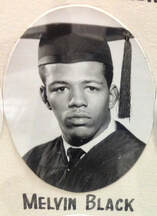
Melvin C.Black PHS Class of 1955
Ben Jobe PHS Class of 1951
Ben Jobe was raised in Nashville, Tennessee. He attended Pearl High School in Nashville where he was a successful basketball player. In 1950, Jobe earned all-district and all-state honors and was then named to the 1951 all-national high school team.
Jobe then enrolled at Fisk University, earning All-Southern Intercollegiate Athletic Conference honors during his junior and senior seasons. He earned a bachelor's degree from Fisk in 1956 and later went on to earn a master's degree from Tennessee State University. In 1958, Jobe began his coaching career at Cameron High School in Nashville, Tennessee. His first (and only) Cameron team won 24 games, a school record. After the season was over, Jobe decided to move to Sierra Leone, West Africa, to coach a junior college basketball team. Jobe's coaching had a quick effect: his teams posted back-to-back undefeated seasons.[2]
Jobe returned to the United States and began coaching at Talladega College in Alabama, a position which he held for three years.
Ben W. Jobe (March 2, 1933 – March 10, 2017) was an American basketball coach. He was best known as the head coach of the Southern University Jaguars – a position he held for 12 years. He has also been head coach of the men's college basketball teams at Tuskegee University, Talladega College, Alabama State University, South Carolina State University, University of Denver and Alabama A&M University. Jobe has also served as assistant coach at the University of South Carolina, Georgia Tech, and briefly served as an assistant with the NBA's Denver Nuggets.[1]
Ben Jobe took the helm of the Southern University Jaguars in 1986. He stayed on until 1996. He returned again to Southern in 2001 for two more seasons, retiring completely from college basketball in 2003. In 12 years at Southern, Jobe compiled a 209-141 record, led the Jaguars to the NCAA tournament four times, went to the National Invitational Tournament (NIT) once, won five Southern Intercollegiate Athletic Conference Championships, won 11 Southwestern Athletic Conference Championships.
Perhaps his most memorable moment as a college basketball coach was the Jaguars' 93-78 win over the then ACC Champions, Georgia Tech Yellow Jackets, during the first round of the 1993 NCAA Tournament in Tucson, Arizona.
Jobe coached former San Antonio Spurs star guard (former coach of the Brooklyn Nets and Dallas Mavericks) Avery Johnson and late Charlotte Hornets player Bobby Phills.
Upon his retirement from Southern in 2003, Jobe had accumulated 524 wins as a head coach in college basketball spread among 8 teams over 31 seasons (a 0.611 win percentage)
Every year since 2010, CollegeInsider.com has awarded the Ben Jobe National Coach of the Year Award (or simply, Ben Jobe Award) to recognize the nation’s top minority head coach from the Division I college basketball coach season. The award is named after Ben Jobe, the long-time head coach of the Southern Jaguars. Jobe was a head coach for a total of 31 seasons, 29 of which were at historically-black colleges and universities.
SEARCY MEMORIAL THANKSGIVING DINNER
Geraldine Searcy PHS Class of 1960
In 1987, Gerry and Keith Searcy developed this program to provide a Thanksgiving meal to a few single elderly shut-ins in the North Nashville area. Sister Naomi Libiak, Director of the Assumption Catholic Church Outreach Program, furnished them with the names and addresses of eight (8) individuals who met the criteria. The program steadily grew over the next years. Unfortunately, in 1997, Keith Searcy, who was born both mentally and physically challenged, passed away. After his death, the Parish Council named the program its current name in his honor.
The first year, Gerry purchased and cooked all of the food. Both she and Keith delivered the dinners to those in need. The following year, with financial assistance from a friend, they were able to deliver 15 meals. Since that time, the program has exponentially grown. In 2014, with the help of over 500 volunteers, more than 2100 meals were delivered on Thanksgiving morning. The volunteer crew is made up of friends, family, former colleagues from the Metro Courthouse where Gerry worked as a deputy criminal court clerk for 29 years, as well as others from the community. Volunteers have included mayors, vice-mayors, judges, politicians, coaches, attorneys, ministers, entertainers, local citizens, teenagers and children.
As the program has grown, Gerry’s role has evolved into one of directing and coordinating versus being involved in every detail and decision. Gerry still does all of the fundraising, most of the volunteer recruiting, assigning the volunteers to areas needed, as well planning the logistics of the day itself. She also plays a major role in purchasing and distributing the raw ingredients to the cooks. She has volunteers who search through the community to find names and addresses of those in need; she also has a publicist, an accountant, and a legal advisor. Each functional area has a team leader, such as the food line coordinator who supervises plate preparation and packaging. A delivery coordinator plans the delivery routes- assigning persons to each route and creating maps for each driver.
Special program features:
Geraldine Searcy PHS Class of 1960
In 1987, Gerry and Keith Searcy developed this program to provide a Thanksgiving meal to a few single elderly shut-ins in the North Nashville area. Sister Naomi Libiak, Director of the Assumption Catholic Church Outreach Program, furnished them with the names and addresses of eight (8) individuals who met the criteria. The program steadily grew over the next years. Unfortunately, in 1997, Keith Searcy, who was born both mentally and physically challenged, passed away. After his death, the Parish Council named the program its current name in his honor.
The first year, Gerry purchased and cooked all of the food. Both she and Keith delivered the dinners to those in need. The following year, with financial assistance from a friend, they were able to deliver 15 meals. Since that time, the program has exponentially grown. In 2014, with the help of over 500 volunteers, more than 2100 meals were delivered on Thanksgiving morning. The volunteer crew is made up of friends, family, former colleagues from the Metro Courthouse where Gerry worked as a deputy criminal court clerk for 29 years, as well as others from the community. Volunteers have included mayors, vice-mayors, judges, politicians, coaches, attorneys, ministers, entertainers, local citizens, teenagers and children.
As the program has grown, Gerry’s role has evolved into one of directing and coordinating versus being involved in every detail and decision. Gerry still does all of the fundraising, most of the volunteer recruiting, assigning the volunteers to areas needed, as well planning the logistics of the day itself. She also plays a major role in purchasing and distributing the raw ingredients to the cooks. She has volunteers who search through the community to find names and addresses of those in need; she also has a publicist, an accountant, and a legal advisor. Each functional area has a team leader, such as the food line coordinator who supervises plate preparation and packaging. A delivery coordinator plans the delivery routes- assigning persons to each route and creating maps for each driver.
Special program features:
- Those delivering the meals are encouraged to spend some time with the recipients, if possible. This oftentimes means more to them than the meal itself.
- Through all the growth, the mission has only changed slightly- from strictly elderly shut-ins in North Nashville to “elderly and disabled citizens” throughout the Nashville community at-large.
- Though many of the volunteers are celebrities, politicians and some wealthier than others, the volunteer pool is really a diverse cross section of the community; the beauty of the program is no one person is more important than another. We all have one common goal- to serve.
Dr. Mary Frances Berry PHS Class of 1954
Joe Goldthreate Named PTR Tennessee Member of the Year
Joe Goldthreate PHS Class of 1967
Hilton Head Island, SC - - Professional Tennis Registry (PTR) presented its annual awards today during the 2018 PTR International Tennis Symposium. The event, which includes more than 40 educational presentations for tennis coaches, is underway February 13-16, on Hilton Head Island, South Carolina.
Joe Goldthreate, of Nashville, Tennessee, has been named PTR Member of the Year for the state. This award is presented to a PTR member who has shown dedication and diligence in promoting and supporting tennis and PTR. A certified Professional, Goldthreate has been a member of the organization for more than 30 years. As a PTR Clinician, he has certified more than 1,000 to be tennis teachers.
The founder of the Hadley Park Junior Development Tennis Program (HPJDTP), Goldthreate had a vision to provide an opportunity for each disadvantaged child and young adult in Nashville to learn how to play tennis. He retired in 2010, after 35 years serving Nashville’s youth, only to be asked to come back in 2013. He accepted and worked pro bono for three more years. After his second retirement, he started the Joe Goldthreate Tennis Academy at his home.
Hadley Park received PTR Public Facility of the Year award, and in 2003, his program was named the Southern Tennis Association National Junior Tennis League (NJTL) Chapter of the Year. He is the first African American to serve on both the Tennessee and Southern Section Executive Boards of the United States Tennis Association (USTA).
Goldthreate has also been honored with several NAACP awards, including the Time is Now Award for his outstanding work with inner city youth. Goldthreate’s contributions to civil rights as one the youngest members of the NAACP are well documented and displayed in the Nashville Public Library.
PTR is the largest global organization of tennis teaching professionals with more than 16,000 members in 125 countries. It has the greatest percentage of multicultural and women members of any such organization. PTR is dedicated to educating, certifying and serving tennis teachers and coaches around the world in order to grow the game.
Perry Wallace’s story to reach new audiences through Nashville Film Festival
Perry Wallace PHS Class of 1966
Triumph: The Untold Story of Perry Wallace, the documentary film about the challenges Wallace faced as one of Vanderbilt University’s first African American students and as a pioneer in Southeastern Conference basketball, will be featured at this year’s Nashville Film Festival.
Screenings of Triumph are scheduled Friday, May 11, at 7 p.m. and Saturday, May 12, at 3:15 p.m. as part of the festival’s lineup. The host site for the festival is Regal Hollywood Stadium 27 & RPX near Vanderbilt Health One Hundred Oaks. Tickets are on sale now. A brief Q&A with director Rich Gentile and Vanderbilt University Vice Chancellor for University Affairs and Athletics Director David Williams will follow each screening.
While the film has been screened and honored at film festivals across the country, including in Austin, Santa Barbara and Los Angeles, the Nashville Film Festival offers the Vanderbilt and Nashville communities an opportunity to learn more about a hometown trailblazer who helped pave the way for today’s college and NBA standouts.
The film was three years in the making and is narrated by Academy Award winner Forest Whitaker. It chronicles Wallace’s journey as an academically and athletically talented 17-year-old from North Nashville who was a reluctant pioneer that blazed a trail through Jim Crow racism. Vanderbilt provided financial support for the film.
When Wallace arrived on Vanderbilt’s campus in 1966 after being recruited by legendary basketball coach Roy Skinner and with the support of then-Chancellor Alexander Heard, he was among the university’s first African American students. His best friend and Pearl High School classmate Walter Murray and another newly recruited basketball teammate, Godfrey Dillard, joined him at Vanderbilt that year.
Wallace, who had come from the nurturing environment of North Nashville’s Pearl High School, the city’s only black high school for half a decade and a source of academic and athletic pride for Nashville’s black community, experienced mistreatment and isolation as one of the first black athletes at Vanderbilt. The experience left an indelible mark on him, his fellow trailblazing students, Vanderbilt and the city.
As members of the freshman basketball team, Wallace and Dillard also faced abuse and hatred on the road from fans throughout the South. Despite these challenges, Wallace made history at Vanderbilt’s Memorial Gym on Dec. 4, 1967, as the first African American athlete to play varsity basketball in the SEC.
The Nashville Film Festival screenings further efforts by Vanderbilt and others to highlight Wallace’s story and legacy.
In December, Vanderbilt and the SEC marked the 50th anniversary of Wallace’s historic 1967 basketball game and honored his and Dillard’s legacies. Wallace, who died Dec. 1 following a battle with cancer, was honored posthumously by the SEC with the Michael L. Slive Distinguished Service Award on Dec. 2 along with Dillard and the four University of Kentucky players who integrated SEC football: Nate Northington, Wilbur Hackett, Houston Hogg and the late Greg Page.
On Dec. 4, Vanderbilt hosted the premiere of Triumph on campus. The film also recently finished a limited run in theaters in New York and Los Angeles.
In January, the Vanderbilt University Alumni Association recognized Wallace as its 2017 Distinguished Alumni recipient, the highest honor bestowed to a member of the university’s alumni community, and the university honored him at an event in his adopted home of Washington, D.C., where he had worked in the Justice Department, served on the Environmental Policy Advisory Council of the EPA, and was a professor at Howard and American universities.
Share This Story .@PerryWallaceDoc featured at this year's Nashville Film Festival
·
Explore Story TopicsmyVU myVU News releases alumni Athletics DAR diversity Legacy of Courage myvu-students myvupreview Perry Wallace Triumph film
Related Stories
Perry Wallace PHS Class of 1966
Triumph: The Untold Story of Perry Wallace, the documentary film about the challenges Wallace faced as one of Vanderbilt University’s first African American students and as a pioneer in Southeastern Conference basketball, will be featured at this year’s Nashville Film Festival.
Screenings of Triumph are scheduled Friday, May 11, at 7 p.m. and Saturday, May 12, at 3:15 p.m. as part of the festival’s lineup. The host site for the festival is Regal Hollywood Stadium 27 & RPX near Vanderbilt Health One Hundred Oaks. Tickets are on sale now. A brief Q&A with director Rich Gentile and Vanderbilt University Vice Chancellor for University Affairs and Athletics Director David Williams will follow each screening.
While the film has been screened and honored at film festivals across the country, including in Austin, Santa Barbara and Los Angeles, the Nashville Film Festival offers the Vanderbilt and Nashville communities an opportunity to learn more about a hometown trailblazer who helped pave the way for today’s college and NBA standouts.
The film was three years in the making and is narrated by Academy Award winner Forest Whitaker. It chronicles Wallace’s journey as an academically and athletically talented 17-year-old from North Nashville who was a reluctant pioneer that blazed a trail through Jim Crow racism. Vanderbilt provided financial support for the film.
When Wallace arrived on Vanderbilt’s campus in 1966 after being recruited by legendary basketball coach Roy Skinner and with the support of then-Chancellor Alexander Heard, he was among the university’s first African American students. His best friend and Pearl High School classmate Walter Murray and another newly recruited basketball teammate, Godfrey Dillard, joined him at Vanderbilt that year.
Wallace, who had come from the nurturing environment of North Nashville’s Pearl High School, the city’s only black high school for half a decade and a source of academic and athletic pride for Nashville’s black community, experienced mistreatment and isolation as one of the first black athletes at Vanderbilt. The experience left an indelible mark on him, his fellow trailblazing students, Vanderbilt and the city.
As members of the freshman basketball team, Wallace and Dillard also faced abuse and hatred on the road from fans throughout the South. Despite these challenges, Wallace made history at Vanderbilt’s Memorial Gym on Dec. 4, 1967, as the first African American athlete to play varsity basketball in the SEC.
The Nashville Film Festival screenings further efforts by Vanderbilt and others to highlight Wallace’s story and legacy.
In December, Vanderbilt and the SEC marked the 50th anniversary of Wallace’s historic 1967 basketball game and honored his and Dillard’s legacies. Wallace, who died Dec. 1 following a battle with cancer, was honored posthumously by the SEC with the Michael L. Slive Distinguished Service Award on Dec. 2 along with Dillard and the four University of Kentucky players who integrated SEC football: Nate Northington, Wilbur Hackett, Houston Hogg and the late Greg Page.
On Dec. 4, Vanderbilt hosted the premiere of Triumph on campus. The film also recently finished a limited run in theaters in New York and Los Angeles.
In January, the Vanderbilt University Alumni Association recognized Wallace as its 2017 Distinguished Alumni recipient, the highest honor bestowed to a member of the university’s alumni community, and the university honored him at an event in his adopted home of Washington, D.C., where he had worked in the Justice Department, served on the Environmental Policy Advisory Council of the EPA, and was a professor at Howard and American universities.
Share This Story .@PerryWallaceDoc featured at this year's Nashville Film Festival
·
Explore Story TopicsmyVU myVU News releases alumni Athletics DAR diversity Legacy of Courage myvu-students myvupreview Perry Wallace Triumph film
Related Stories
- State Legislature honors Vanderbilt athlete, civil rights pioneer Perry Wallace APR 11, 2018
- Celebration of life for Perry Wallace scheduled for Feb. 19 at Vanderbilt University FEB 6, 2018
- Red-carpet premiere of film celebrates Perry Wallace’s life DEC 5, 2017
- Writer-in-residence Andrew Maraniss shares the story of Perry Wallace on ‘The Zeppos Report’ NOV 27, 2017
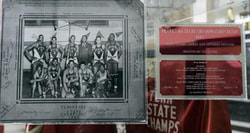
Click picture below to view:
"The Legacy of Pearl High School And Its Success During Segregation"
by Andrew Maraniss
Pearl High School Alumni Inducted Into The MNPS Sports Hall Of Fame
2020 Honoree
2016 Honorees
2013 Honorees
2012 Honorees
2011 Honoree
2010 Honoree
2009 Honorees
2008 Honorees
2007 Honoree
2006 Honoree
2005 Honorees
Pearl High School graduates Victor Rouse and Leslie Hunter played on the 1962-63 Loyola Ramblers men's basketball team that won the 1963 NCAA Tournament.
W. Victor Rouse (March 15, 1943 – May 31, 1999) was an American college basketball player. He was an All-American at Loyola University of Chicago and is best remembered for hitting the game-winning shot as time expired in the overtime period of the 1963 NCAA championship game.
Rouse, a 6'7" forward from Pearl High School in Nashville, Tennessee, played college basketball for Loyola for coach George Ireland. He, along with high school teammate Les Hunter, joined the Ramblers and helped them become the first NCAA champion to feature four African-American starters in his junior year.[1] Rouse anchored the middle, leading the team in rebounding as a sophomore (11.3 per game) and junior (12.1 per game). In the championship season of 1962–63, Rouse averaged 13.5 points.
Rouse is best known for following Hunter's miss as time expired to defeat Cincinnati and spoil that school's bid to win a third straight NCAA title. The shot gave Loyola its first, and so far only, NCAA basketball championship. Rouse and the four other Loyola starters played the entire championship game, without substitution.[2]
In his senior year, Loyola returned four starters and had eyes on repeating as champions. Rouse upped his averages to 15.6 points and 12.5 rebounds per game. However, he dislocated his shoulder early in the season, hampering his effectiveness.[2] Rouse was still named an honorable mention All-American at the close of the season.[3] Rouse scored 1,169 points and grabbed 982 rebounds in his Loyola career. His #40 jersey was retired in 1993.[2]
Following the close of his college career, Rouse was drafted by the Cincinnati Royals in the 1964 NBA Draft (seventh round, 60th pick); however, he never played in the league. Instead, Rouse earned three masters degrees and a PhD. He owned his own educational consulting firm and taught courses at the University of Maryland.[1]
Leslie Hunter was born in Nashville, Tennessee. A 6'7" forward/center, Hunter attended Pearl High School and Loyola University Chicago. [1] At Loyola, he served as the starting center of the team that upset the University of Cincinnati in overtime to win the 1963 NCAA Men's Division I Basketball Championship. He and the other four Loyola starters played the entire game, without substitution. And a first-round Mideast Regional victory by Hunter and the Ramblers over Tennessee Tech, 111-42, remains a record margin of victory for an NCAA men's basketball tournament game.[2][3]
He was drafted by the Detroit Pistons in the 2nd round (11th pick overall) of the 1964 NBA Draft.[4] He played for one season (1964–1965) in the NBA with the Baltimore Bullets.
He was drafted in the 1972 ABA Draft.[5] Hunter spent six seasons (1967–1973) in the ABA with the Minnesota Muskies, Miami Floridians, New Jersey Nets, Kentucky Colonels, and Memphis Tams.[6] Hunter scored 5,735 points in his professional career and was a two-time ABA All-Star.[7][8] He played in the first ABA All-Star game in 1968 in Indianapolis.[9]
After retiring from basketball, Hunter moved to Kansas City in 1976.[10] He owned a restaurant for ten years and now works as an instructor helping students who did not graduate take online classes to complete high school.[11]
On July 11, 2013, in the Oval Office of the White House, Hunter and former Loyola teammates John Egan, Jerry Harkness and Ron Miller met with President Barack Obama to commemorate the 50th anniversary of the school's 1963 national championship.[12] To date it remains the only NCAA Division I basketball championship won by a university from the state of Illinois.[13] In September 2013, Harkness and the entire 1963 Loyola Ramblers NCAA Championship basketball team was inducted into the Chicagoland Sports Hall of Fame.[14] The 1963 Loyola Ramblers were inducted in the College Basketball Hall of Fame in November 2013,[15] making it the first team inducted into the Hall of Fame.[16]
1962–63 Loyola Ramblers men's basketball team
The 1962–63 Loyola Ramblers men's basketball team represented Loyola University Chicago. The head coach was George Ireland. The Ramblers were the 1963 NCAA Tournament Champions, defeating top-ranked and two-time defending champion Cincinnati Bearcats in a 60–58 overtime contest. The team was notable in that it broke the so-called "gentlemen's agreement" amongst coaches in which no more than two black players would be on the floor at one time (and in some road games, black players would have to rotate so that only one of them was playing at any given moment): the Ramblers would regularly have three or four black starters, paving the way for the 1965-66 Texas Western Miners men's basketball team who would finally put the "agreement" to rest and have an all-black starting five.[1]
On July 11, 2013, to commemorate the 50th anniversary of their championship, surviving members of Loyola's team were honored by President Barack Obama in a ceremony at the Oval Office of the White House. It also was announced that the entire team would be inducted in the College Basketball Hall of Fame in a ceremony scheduled for November 2013.
The 1962–63 Loyola Ramblers men's basketball team represented Loyola University Chicago. The head coach was George Ireland. The Ramblers were the 1963 NCAA Tournament Champions, defeating top-ranked and two-time defending champion Cincinnati Bearcats in a 60–58 overtime contest. The team was notable in that it broke the so-called "gentlemen's agreement" amongst coaches in which no more than two black players would be on the floor at one time (and in some road games, black players would have to rotate so that only one of them was playing at any given moment): the Ramblers would regularly have three or four black starters, paving the way for the 1965-66 Texas Western Miners men's basketball team who would finally put the "agreement" to rest and have an all-black starting five.[1]
On July 11, 2013, to commemorate the 50th anniversary of their championship, surviving members of Loyola's team were honored by President Barack Obama in a ceremony at the Oval Office of the White House. It also was announced that the entire team would be inducted in the College Basketball Hall of Fame in a ceremony scheduled for November 2013.
Tennessee State University Rifle Team 1963
Pearl High School Graduates
Front Row L-R, Arthur Davis '61, 3rd from Left Calvian Dunnavant '61, 4th from left James Brown '61, 5th from left
Henry Irvin,Jr. '62
Back Row Howard Baugh '61
Front Row L-R, Arthur Davis '61, 3rd from Left Calvian Dunnavant '61, 4th from left James Brown '61, 5th from left
Henry Irvin,Jr. '62
Back Row Howard Baugh '61
Pearl High School
SYMPHONIC BAND
Monday Evening, March 13, 1961
1st Row L-R, B Flat Clarinet: Henry Bass '61, Russell Ennix '62, Maurice Bogus '61, Herschel Carter '61, M. H. Gunter, Band Director, Flutes: Gwendolyn Manlove '63, Dorothy Fort '61, Patricia Ashworth '61.
2nd Row B Flat Clarinet: Lillian Thornton '61, James Welch '63, Jane Valentine '63, Oboes: Joyce Rucks '62,
Thyckla Johnson '63, Bassoon Clifford Mayberry '61, Charles Bell '62, Bass Clarinet: James Sweatt '62, Alto
Clarinet: Malcolm Childs '61.
3rd Row B Flat Clarinet: Allen Williams '63, Doris Truett '63, William Collier '63, French Horns: George Biddix '62, Henry Irvin '62, Henry Pillow '61, Carmen Hughes '62, Saxophones: Richard Bradford '61, James
Robinson '63, Walter Duncan '61, Ronald Fuqua '62.
4th Row Joseph Davis '61, Raymond Holman '61, Freeman Ramsey '61, Clarence Jones '61, Robert Drummond '63, Edward Kindall '63, William Jones '61, Baritones: Theodore Reynold '63, Samuel Robinson '62, Trombones: John Howard '61, Cecil Turner '62, Godfrey Watson '61.
5th Row Tympani; John Cloud '61, Percussion: Jean S. Welch '61, Frank Sheffield '62, Charles Sherrell '61,
Charles Johnson '61, Basses: Eugene Thompson '63, Ronald Satterfield '62, Prentice Leonard '62, Paul Douglas '62.
Shared Memories
Pearl High Tigers teammates James Douglas, left, Perry Wallace and Walter Fisher collaborated to crunch this rim during Region 5 tournament action against Glencliff High. Pearl defeated the Colts 73-46 at Vanderbilt University March 10, 1966.
Pearl High junior James Douglas (40) grabs the rebound against Overton High in the Region 5 tournament at Vanderbilt University March 11, 1966. Pearl defeats Overton 59-43 and will face Stratford High in the finals.
Pearl High junior Theodore McClain (24) battles Willie Jenkins (32) of Gallatin Union for the rebound March 3, 1966. Pearl defeated Union for its first playoff victory in the District 17 tournament at Cameron High and advances into the semifinal bracket.
Pearl High junior James Douglas (40) grabs the rebound against Overton High in the Region 5 tournament at Vanderbilt University March 11, 1966. Pearl defeats Overton 59-43 and will face Stratford High in the finals.
Pearl High senior Perry Wallace (42) shoots from outside against Overton High in the Region 5 tournament at Vanderbilt University March 11, 1966. Pearl defeats Overton 59-43 and will face Stratford High in the finals.
Pearl High head coach Cornelius Ridley, right, and his assistants, James Armstrong, left, and Melvin Black, coach the Tigers against Stratford High March 12, 1966. Unbeaten Pearl wins 53-49 over Stratford in the Region 5 championships at Vanderbilt University gym.
Pearl High head coach Cornelius Ridley, left in glasses, celebrates with his team after its playoff win over Stratford High March 12, 1966. Unbeaten Pearl defeats Stratford 53-49 for the Region 5 championship.
Pearl High players pickup the trophy after their playoff win over Stratford High March 12, 1966. Unbeaten Pearl defeats Stratford 53-49 for the Region 5 championship title.
Pearl High head coach Cornelius Ridley is alone in the dressing room at Vanderbilt University gym as he makes final plans for the championship game against Memphis Treadwell. Unbeaten Pearl beat Treadwell 63-54 in the finals of the TSSAA State tournament March 19, 1966.
Pearl High head coach Cornelius Ridley, center, goes over the final game plans for the championship game against Memphis Treadwell. Pearl beats Treadwell 63-54 in the finals of the TSSAA State tournament March 19, 1966.
Pearl High guard Theodore McClain (24) lays up two at the start of their game against Memphis Treadwell. Pearl beats Treadwell 63-54 in the finals of its first TSSAA State tournament March 19, 1966.
Pearl High junior James Douglas (40) lays up two against Memphis Treadwell. Pearl beats Treadwell 63-54 in the finals of its first TSSAA State tournament March 19, 1966.
Pearl High senior Perry Wallace (42) puts in two against Memphis Treadwell. Pearl beats Treadwell 63-54 in the finals of its first TSSAA State tournament March 19, 1966.
Pearl High junior James Douglas (40) pulls up for a jumper against Memphis Treadwell. Pearl beats Treadwell 63-54 in the finals of its first TSSAA State tournament March 19, 1966.
Pearl High guard Theodore McClain (24) goes in for a layup against Memphis Treadwell in the finals of their first TSSAA State tournament March 19, 1966.
Pearl High's Walter Fisher (32) puts up two against Memphis Treadwell. The unbeaten Pearl smacked Treadwell 63-54 in the finals of their first TSSAA State tournament March 19, 1966.
The Pearl High bench waits as the game is coming to an end and victory is in hand against Memphis Treadwell. Pearl beats Treadwell 63-54 in the finals of its first TSSAA State tournament March 19, 1966.
Pearl High head coach Cornelius Ridley, center, celebrates as the game comes to an end against Memphis Treadwell. Pearl beats Treadwell 63-54 in the finals of its first TSSAA State tournament March 19, 1966..
Pearl High head coach Cornelius Ridley, left, and assistant coach Melvin Black celebrate with their players at the end of the game against Memphis Treadwell. Pearl beats Treadwell 63-54 in the finals of its first TSSAA State tournament March 19, 1966.
Pearl High's Walter Fisher is overcome as the rest of the team celebrates at the end of the game against Memphis Treadwell. Pearl beats Treadwell 63-54 in the finals of its first TSSAA State tournament March 19, 1966.
Pearl High teammates Walter Fisher and Perry Wallace receive the first-place trophy from Gov. Frank Clement. Pearl beats Treadwell 63-54 in the finals of its first TSSAA State tournament March 19, 1966..
Pearl High has four players, Theodore McClain (24), James Douglas (40), Walter Fisher (32) and Perry Wallace (42) on the All-State Tournament team. Pearl beats Treadwell 63-54 in the finals of its first TSSAA State tournament March 19, 1966.
A quartet of Pearl High stars, Walter Fisher, left, Perry Wallace, James Douglas and Joe Herbert, take a look at pictures going out over the AP wirep hoto machine March 20, 1966, many of which were taken when the Tigers grabbed the TSSAA state crown.
The captain and co-captain of Pearl High's TSSAA state champions examine a plaque awarded to their coach, Cornelius Ridley, by the Nashville club of Frontiers International, Inc. March 29, 1966. From left are William V. Harper, president of Frontiers; Walter Fisher, team captain; Perry Wallace, co-captain; coach Ridley and Lawrence Simmons, Frontiers awards chairman.



